
Results
from the 2007
National Survey on Drug Use and Health:
National Findings
DEPARTMENT
OF HEALTH AND HUMAN SERVICES
Substance Abuse and Mental Health Services Administration (SAMHSA)
Office of Applied Studies (OAS)
Acknowledgments
This report was prepared
by the Division of Population Surveys, Office of Applied Studies, SAMHSA,
and by RTI International, a trade name of Research Triangle Institute, Research
Triangle Park, North Carolina. Work by RTI was performed under Contract No.
283-2004-00022. Contributors and reviewers at RTI listed alphabetically
include Jeremy Aldworth, Kimberly Ault, Ellen Bishop, Lisa Carpenter, Patrick
Chen, James R. Chromy, Elizabeth Copello, David B. Cunningham, Lanting Dai,
Teresa R. Davis, Ralph E. Folsom, Jr., Misty Foster, Peter Frechtel, G. G.
Frick, Julia Gable, Jody M. Greene, Wafa Handley, David C. Heller, Erica Hirsch,
Ilona Johnson, Lauren Klein, Larry A. Kroutil, Bing Liu, Mary Ellen Marsden,
Katherine B. Morton, Breda Munoz, Scott Novak, Lisa E. Packer, Lanny Piper,
Jeremy Porter, Heather Ringeisen, Tania Robbins, Harley Rohloff, Kathryn Spagnola,
Thomas G. Virag (Project Director), Michael Vorburger, and Jiantong Wang.
Contributors at SAMHSA listed alphabetically, with chapter authorship noted,
include Peggy Barker, Jonaki Bose, James Colliver (Chapters 2
and 4), Lisa Colpe (Chapter 8),
Joseph Gfroerer (Chapters 1 and 9),
Beth Han (Chapters 6 and 7),
Arthur Hughes (Project Officer), Joel Kennet (Chapter 3),
Pradip Muhuri (Chapter 5), and Dicy
Painter. Also at RTI, report and web production staff listed alphabetically
include Teresa G. Bass, Wendy Broome, Cassandra M. Carter, Joyce Clay-Brooks,
Diane G. Eckard, Shari B. Lambert, Danny Occoquan, Brenda K. Porter, Pamela
Couch Prevatt, and Richard S. Straw. Final report production was provided
by Beatrice Rouse, Coleen Sanderson, and Jane Feldmann at SAMHSA.
Public Domain Notice
All material appearing
in this report is in the public domain and may be reproduced or copied without
permission from the Substance Abuse and Mental Health Services Administration.
However, this publication may not be reproduced or distributed for
a fee without specific, written authorization of the Office of Communications,
SAMHSA, U.S. Department of Health and Human Services. Citation of the source
is appreciated. Suggested citation:
Substance Abuse and
Mental Health Services Administration, Office of Applied Studies (2008).
Results from the 2007 National Survey on Drug Use and Health: National
Findings (NSDUH Series H-34, DHHS Publication No. SMA 08-4343).
Rockville, MD.
Electronic
Access to Publication
This publication
may be downloaded from http://oas.samhsa.gov.
Hard copies may be obtained from http://oas.samhsa.gov/copies.cfm.
Or please
call SAMHSA's Health Information Network at:
1-877-SAMHSA-7 (1-877-726-4727)
(English and Español).
Originating
Office
SAMHSA,
Office of Applied Studies
1 Choke Cherry Road, Room 7-1044
Rockville, MD 20857
September
2008
Skip
To Content
2007
National Survey on Drug Use & Health: National Results
|
List of
Figures
2.1
Past Month Illicit Drug Use among Persons Aged 12 or Older: 2007
2.2
Past Month Use of Selected Illicit Drugs among Persons Aged 12 or Older: 2002-2007
2.3
Past Month Nonmedical Use of Types of Psychotherapeutic Drugs among Persons
Aged 12 or Older: 2002-2007
2.4
Past Month Illicit Drug Use among Persons Aged 12 or Older, by Age: 2007
2.5
Past Month Use of Selected Illicit Drugs among Youths Aged 12 to 17: 2002-2007
2.6
Past Month Use of Selected Illicit Drugs among Young Adults Aged 18 to 25:
2002-2007
2.7
Past Month Illicit Drug Use among Adults Aged 50 to 59: 2002-2007
2.8
Past Month Marijuana Use among Youths Aged 12 to 17, by Gender: 2002-2007
2.9
Past Month Illicit Drug Use among Persons Aged 12 or Older, by Race/Ethnicity:
2007
2.10
Past Month Illicit Drug Use among Persons Aged 18 or Older, by Employment
Status: 2007
2.11
Past Month Illicit Drug Use among Persons Aged 12 or Older, by County Type:
2007
3.1
Current, Binge, and Heavy Alcohol Use among Persons Aged 12 or Older, by Age:
2007
3.2
Current, Binge, and Heavy Alcohol Use among Persons Aged 12 or Older, by Race/Ethnicity:
2007
3.3
Heavy Alcohol Use among Adults Aged 18 to 22, by College Enrollment: 2002-2007
3.4
Driving Under the Influence of Alcohol in the Past Year among Persons Aged
12 or Older: 2002-2007
3.5
Driving Under the Influence of Alcohol in the Past Year among Persons Aged
16 or Older, by Age: 2007
3.6
Current Alcohol Use among Persons Aged 12 to 20, by Age: 2002-2007
3.7
Current, Binge, and Heavy Alcohol Use among Persons Aged 12 to 20, by Gender:
2007
4.1
Past Month Tobacco Use among Persons Aged 12 or Older: 2002-2007
4.2
Past Month Tobacco Use among Youths Aged 12 to 17: 2002-2007
4.3
Past Month Cigarette Use among Persons Aged 12 or Older, by Age: 2007
4.4
Past Month Cigarette Use among Youths Aged 12 to 17, by Gender: 2002-2007
4.5
Past Month Cigarette Use among Women Aged 15 to 44, by Pregnancy Status: Combined
Years 2002-2003 to 2006-2007
4.6
Past Month Tobacco Use among Adults Aged 18 or Older, by Education: 2007
5.1
Specific Drug Used When Initiating Illicit Drug Use among Past Year Initiates
of Illicit Drugs Aged 12 or Older: 2007
5.2
Past Year Initiates for Specific Illicit Drugs among Persons Aged 12 or Older:
2007
5.3
Mean Age at First Use for Specific Illicit Drugs among Past Year Initiates
Aged 12 to 49: 2007
5.4
Past Year Marijuana Initiates among Persons Aged 12 or Older and Mean Age
at First Use of Marijuana among Past Year Marijuana Initiates Aged 12 to 49:
2002-2007
5.5
Past Year Ecstasy Initiates among Persons Aged 12 or Older and Mean Age at
First Use of Ecstasy among Past Year Ecstasy Initiates Aged 12 to 49: 2002-2007
5.6
Past Year Methamphetamine Initiates among Persons Aged 12 or Older and Mean
Age at First Use of Methamphetamine among Past Year Methamphetamine Initiates
Aged 12 to 49: 2002-2007
5.7
Past Year Cigarette Initiates among Persons Aged 12 or Older, by Age at First
Use: 2002-2007
5.8
Past Year Cigarette Initiation among Youths Aged 12 to 17 Who Had Never Smoked,
by Gender: 2002-2007
6.1
Past Month Binge Drinking and Marijuana Use among Youths Aged 12 to 17, by
Perceptions of Risk: 2007
6.2
Perceived Great Risk of Cigarette and Alcohol Use among Youths Aged 12 to
17: 2002-2007
6.3
Perceived Great Risk of Marijuana Use among Youths Aged 12 to 17: 2002-2007
6.4
Perceived Great Risk of Use of Selected Illicit Drugs among Youths Aged 12
to 17: 2002-2007
6.5
Perceived Availability of Selected Illicit Drugs among Youths Aged 12 to 17:
2002-2007
6.6
Approached in the Past Month by Someone Selling Drugs among Youths Aged 12
to 17: 2002-2007
6.7
Exposure to Substance Use Prevention Messages and Programs among Youths Aged
12 to 17: 2002-2007
7.1
Substance Dependence or Abuse in the Past Year among Persons Aged 12 or Older:
2002-2007
7.2
Dependence on or Abuse of Specific Illicit Drugs in the Past Year among Persons
Aged 12 or Older: 2007
7.3
Alcohol Dependence or Abuse in the Past Year among Adults Aged 21 or Older,
by Age at First Use of Alcohol: 2007
7.4
Substance Dependence or Abuse in the Past Year, by Age and Gender: 2007
7.5
Locations Where Past Year Substance Use Treatment Was Received among Persons
Aged 12 or Older: 2007
7.6
Substances for Which Most Recent Treatment Was Received in the Past Year among
Persons Aged 12 or Older: 2007
7.7
Past Year Perceived Need for and Effort Made to Receive Specialty Treatment
among Persons Aged 12 or Older Needing But Not Receiving Treatment for Illicit
Drug or Alcohol Use: 2007
7.8
Reasons for Not Receiving Substance Use Treatment among Persons Aged 12 or
Older Who Needed and Made an Effort to Get Treatment But Did Not Receive Treatment
and Felt They Needed Treatment: 2004-2007 Combined
8.1
Serious Psychological Distress in the Past Year among Adults Aged 18 or Older,
by Age: 2006-2007
8.2
Number of Types of Mental Health Services Received in the Past Year among
Persons Aged 18 or Older with Past Year Serious Psychological Distress Who
Received Mental Health Services in the Past Year: 2007
8.3
Past Year Mental Health Care among Adults Aged 18 or Older with Both Serious
Psychological Distress and a Substance Use Disorder: 2007
8.4
Major Depressive Episode in the Past Year among Adults Aged 18 or Older, by
Severe Impairment, Age, and Gender: 2007
8.5
Substance Dependence or Abuse among Adults Aged 18 or Older, by Major Depressive
Episode in the Past Year: 2007
8.6
Past Year Mental Health Service Use among Adults Aged 18 or Older, by Type
of Care: 2002-2007
8.7
Reasons for Not Receiving Mental Health Services in the Past Year among Adults
Aged 18 or Older with an Unmet Need for Mental Health Care Who Did Not Receive
Mental Health Services: 2007
8.8
Major Depressive Episode in the Past Year among Youths Aged 12 to 17, by Severe
Impairment, Age, and Gender: 2007
8.9
Substance Use among Youths Aged 12 to 17, by Major Depressive Episode in the
Past Year: 2007
8.10
Past Year Mental Health Service Use among Youths Aged 12 to 17, by Gender:
2007
8.11
Number of Outpatient Visits in the Past Year among Youths Aged 12 to 17 Who
Received Outpatient Specialty Mental Health Services: 2007
8.12
Number of Nights Stayed in an Inpatient Specialty Mental Health Facility in
the Past Year among Youths Aged 12 to 17 Who Received Inpatient Specialty
Mental Health Services: 2007
9.1
Past Month Marijuana Use among Youths in NSDUH, MTF, and YRBS: 1971-2007
B.1
Required Effective Sample as a Function of the Proportion Estimated
List of
Tables
9.1
Comparison of NSDUH and MTF Prevalence Estimates among Youths: 2002-2007
9.2
Comparison of NSDUH and MTF Prevalence Estimates among Young Adults: 2002-2007
B.1
Demographic and Geographic Domains Forced to Match Their Respective U.S. Census
Bureau Population Estimates through the Weight Calibration Process, 2007
B.2
Summary of 2007 NSDUH Suppression Rules
B.3
Weighted Percentages and Sample Sizes for 2006 and 2007 NSDUHs, by Screening
Result Code
B.4
Weighted Percentages and Sample Sizes for 2006 and 2007 NSDUHs, by Final Interview
Code
B.5
Response Rates and Sample Sizes for 2006 and 2007 NSDUHs, by Demographic Characteristics
B.6
Nonmedical Use of Methamphetamine in Lifetime, Past Year, and Past Month,
by Demographic Characteristics: Percentages Based on Different Estimation
Methods, 2002-2007
B.7
Nonmedical Use of Stimulants in Lifetime, Past Year, and Past Month, by Demographic
Characteristics: Percentages Based on Different Estimation Methods, 2002-2007
B.8
Nonmedical Use of Psychotherapeutics in Lifetime, Past Year, and Past Month,
by Demographic Characteristics: Percentages Based on Different Estimation
Methods, 2002-2007
B.9
Nonmedical Use of Sedatives and Stimulants in the Lifetime, Past Year, and
Past Month among Persons Aged 12 or Older Based on Different Estimation Methods,
by Demographic Characteristics: Percentages, 2006 and 2007
B.10
Nonmedical Use of Prescription-Type Psychotherapeutics and Use of Hallucinogens
in the Lifetime, Past Year, and Past Month among Persons Aged 12 or Older
Based on Different Estimation Methods, by Demographic Characteristics: Percentages,
2006 and 2007
B.11
Illicit Drug Use and Illicit Drug Use Other Than Marijuana in the Lifetime,
Past Year, and Past Month among Persons Aged 12 or Older Based on Different
Estimation Methods, by Demographic Characteristics: Percentages, 2006 and
2007
D.1
Use of Specific Substances in Lifetime, Past Year, and Past Month among 8th,
10th, and 12th Graders in NSDUH and MTF: Percentages, 2006 and 2007
D.2
Lifetime and Past Month Substance Use among Students in Grades 9 to 12 in
YRBS and NSDUH: 2005 and 2007
F.1
Survey Sample Size for Respondents Aged 12 or Older, by Gender and Detailed
Age Category: 2006 and 2007
F.2
Numbers (in Thousands) of Persons Aged 12 or Older, by Gender and Detailed
Age Category: 2006 and 2007
F.3
Survey Sample Size for Respondents Aged 12 or Older, by Age Group and Demographic
Characteristics: 2006 and 2007
F.4
Numbers (in Thousands) of Persons Aged 12 or Older, by Age Group and Demographic
Characteristics: 2006 and 2007
F.5
Survey Sample Size for Respondents Aged 12 or Older, by Age Group and Geographic
Characteristics: 2006 and 2007
F.6
Numbers (in Thousands) of Persons Aged 12 or Older, by Age Group and Geographic
Characteristics: 2006 and 2007
G.1
Types of Illicit Drug Use in Lifetime among Persons Aged 12 or Older: Numbers
in Thousands, 2002-2007
G.2
Types of Illicit Drug Use in Lifetime among Persons Aged 12 or Older: Percentages,
2002-2007
G.3
Types of Illicit Drug Use in the Past Year among Persons Aged 12 or Older:
Numbers in Thousands, 2002-2007
G.4
Types of Illicit Drug Use in the Past Year among Persons Aged 12 or Older:
Percentages, 2002-2007
G.5
Types of Illicit Drug Use in the Past Month among Persons Aged 12 or Older:
Numbers in Thousands, 2002-2007
G.6
Types of Illicit Drug Use in the Past Month among Persons Aged 12 or Older:
Percentages, 2002-2007
G.7
Types of Illicit Drug Use in the Past Month among Persons Aged 12 to 17: Percentages,
2002-2007
G.8
Types of Illicit Drug Use in the Past Month among Persons Aged 18 to 25: Percentages,
2002-2007
G.9
Types of Illicit Drug Use in the Past Month among Persons Aged 26 or Older:
Percentages, 2002-2007
G.10
Illicit Drug Use in Lifetime, Past Year, and Past Month, by Detailed Age Category:
Percentages, 2006 and 2007
G.11
Illicit Drug Use in Lifetime, Past Year, and Past Month among Persons Aged
12 or Older, by Demographic Characteristics: Percentages, 2006 and 2007
G.12
Illicit Drug Use in Lifetime, Past Year, and Past Month among Persons Aged
12 to 17, by Demographic Characteristics: Percentages, 2006 and 2007
G.13
Illicit Drug Use in Lifetime, Past Year, and Past Month among Persons Aged
18 or Older, by Demographic Characteristics: Percentages, 2006 and 2007
G.14
Tobacco Product and Alcohol Use in the Past Month among Persons Aged 12 or
Older, by Gender: Numbers in Thousands, 2002-2007
G.15
Tobacco Product and Alcohol Use in the Past Month among Persons Aged 12 or
Older, by Gender: Percentages, 2002-2007
G.16
Tobacco Product and Alcohol Use in the Past Month among Persons Aged 12 to
17, by Gender: Percentages, 2002-2007
G.17
Tobacco Product and Alcohol Use in the Past Month among Persons Aged 18 to
25, by Gender: Percentages, 2002-2007
G.18
Tobacco Product and Alcohol Use in the Past Month among Persons Aged 26 or
Older, by Gender: Percentages, 2002-2007
G.19
Alcohol Use in Lifetime, Past Year, and Past Month among Persons Aged 12 to
20, by Gender: Percentages, 2002-2007
G.20
Alcohol Use, Binge Alcohol Use, and Heavy Alcohol Use in the Past Month, by
Detailed Age Category: Percentages, 2006 and 2007
G.21
Alcohol Use, Binge Alcohol Use, and Heavy Alcohol Use in the Past Month among
Persons Aged 12 to 20, by Demographic Characteristics: Percentages, 2006 and
2007
G.22
Cigarette Use in Lifetime, Past Year, and Past Month, by Detailed Age Category:
Percentages, 2006 and 2007
G.23
Cigarette Use in Lifetime, Past Year, and Past Month among Persons Aged 12
to 17, by Demographic Characteristics: Percentages, 2006 and 2007
G.24
Cigarette Use in Lifetime, Past Year, and Past Month among Persons Aged 18
or Older, by Demographic Characteristics: Percentages, 2006 and 2007
G.25
Perceived Risk and Availability of Substances among Persons Aged 12 to 17:
Percentages, 2002-2007
G.26
Past Year Initiation of Substance Use among Persons Aged 12 or Older: Numbers
in Thousands, 2002-2007
G.27
Substance Dependence or Abuse for Specific Substances in the Past Year among
Persons Aged 12 or Older: Numbers in Thousands, 2002-2007
G.28
Substance Dependence or Abuse for Specific Substances in the Past Year among
Persons Aged 12 or Older: Percentages, 2002-2007
G.29
Substance Dependence or Abuse in the Past Year among Persons Aged 12 or Older,
by Demographic Characteristics: Percentages, 2006 and 2007
G.30
Received Substance Use Treatment at Any Treatment Location or at a Specialty
Facility in the Past Year among Persons Aged 12 or Older: Numbers in Thousands,
2002-2007
G.31
Received Substance Use Treatment at Any Treatment Location or at a Specialty
Facility in the Past Year among Persons Aged 12 or Older: Percentages, 2002-2007
G.32
Needed and Received Treatment for a Substance Use Problem in the Past Year
among Persons Aged 12 or Older: Numbers in Thousands, 2002-2007
G.33
Needed and Received Treatment for a Substance Use Problem in the Past Year
among Persons Aged 12 or Older: Percentages, 2002-2007
G.34
Needed and Received Treatment for an Illicit Drug or Alcohol Problem in the
Past Year among Persons Aged 12 or Older, by Demographic Characteristics:
Percentages, 2006 and 2007
G.35
Perceived Need for Illicit Drug or Alcohol Treatment and Whether Made an Effort
to Get Treatment in the Past Year among Persons Aged 12 or Older Classified
as Needing But Not Receiving Treatment for an Illicit Drug or Alcohol Problem,
by Demographic Characteristics: Numbers in Thousands, 2006 and 2007
G.36
Perceived Need for Illicit Drug or Alcohol Treatment and Whether Made an Effort
to Get Treatment in the Past Year among Persons Aged 12 or Older Classified
as Needing But Not Receiving Treatment for an Illicit Drug or Alcohol Problem,
by Demographic Characteristics: Percentages, 2006 and 2007
G.37
Serious Psychological Distress in the Past Year among Persons Aged 18 or Older,
by Demographic Characteristics: Percentages, 2004-2007
G.38
Received Mental Health Treatment/Counseling in the Past Year among Persons
Aged 18 or Older, by Demographic Characteristics: Percentages, 2002-2007
G.39
Had at Least One Major Depressive Episode (MDE) in the Past Year among Persons
Aged 18 or Older, by Demographic Characteristics: Percentages, 2004-2007
G.40
Had at Least One Major Depressive Episode (MDE) in the Past Year among Persons
Aged 12 to 17, by Demographic Characteristics: Percentages, 2004-2007
G.41
Source of Mental Health Service in the Past Year among Persons Aged 12 to
17: Percentages, 2002-2007
Highlights
This report presents the
first information from the 2007 National Survey on Drug Use and Health (NSDUH),
an annual survey sponsored by the Substance Abuse and Mental Health Services
Administration (SAMHSA). The survey is the primary source of information on
the use of illicit drugs, alcohol, and tobacco in the civilian, noninstitutionalized
population of the United States aged 12 years old or older. The survey interviews
approximately 67,500 persons each year. Unless otherwise noted, all comparisons
in this report described using terms such as "increased," "decreased,"
or "more than" are statistically significant at the .05 level.
Illicit
Drug Use
- In 2007, an estimated
19.9 million Americans aged 12 or older were current (past month) illicit
drug users, meaning they had used an illicit drug during the month prior
to the survey interview. This estimate represents 8.0 percent of the
population aged 12 years old or older. Illicit drugs include marijuana/hashish,
cocaine (including crack), heroin, hallucinogens, inhalants, or prescription-type
psychotherapeutics used nonmedically.
- The rate of current
illicit drug use among persons aged 12 or older in 2007 (8.0 percent)
was similar to the rate in 2006 (8.3 percent).
- Marijuana was the most
commonly used illicit drug (14.4 million past month users). Among persons
aged 12 or older, the rate of past month marijuana use in 2007 (5.8 percent)
was similar to the rate in 2006 (6.0 percent).
- In 2007, there were
2.1 million current cocaine users aged 12 or older, comprising 0.8 percent
of the population. These estimates were similar to the number and rate in
2006 (2.4 million or 1.0 percent).
- Hallucinogens were
used in the past month by 1.0 million persons (0.4 percent) aged 12
or older in 2007, including 503,000 (0.2 percent) who had used Ecstasy.
These estimates were similar to the corresponding estimates for 2006.
- There were 6.9 million
(2.8 percent) persons aged 12 or older who used prescription-type
psychotherapeutic drugs nonmedically in the past month. Of these, 5.2 million
used pain relievers, the same as the number in 2006.
- In 2007, there were
an estimated 529,000 current users of methamphetamine aged 12 or older (0.2 percent
of the population). These estimates were not significantly different from
the estimates for 2006 (731,000 or 0.3 percent).
- Among youths aged 12
to 17, the current illicit drug use rate remained stable from 2006 (9.8 percent)
to 2007 (9.5 percent). Between 2002 and 2007, youth rates declined
significantly for illicit drugs in general (from 11.6 to 9.5 percent)
and for marijuana, cocaine, hallucinogens, LSD, Ecstasy, prescription-type
drugs used nonmedically, pain relievers, stimulants, methamphetamine, and
the use of illicit drugs other than marijuana.
- The rate of current
marijuana use among youths aged 12 to 17 declined from 8.2 percent
in 2002 to 6.7 percent in 2007. The rate decreased for both males (from
9.1 to 7.5 percent) and females (from 7.2 to 5.8 percent).
- Among young adults
aged 18 to 25, there were decreases from 2006 to 2007 in the rate of current
use of several drugs, including cocaine (from 2.2 to 1.7 percent),
Ecstasy (from 1.0 to 0.7 percent), stimulants (from 1.4 to 1.1 percent),
methamphetamine (from 0.6 to 0.4 percent), and illicit drugs other
than marijuana (from 8.9 to 8.1 percent).
- From 2002 to 2007,
there was an increase among young adults aged 18 to 25 in the rate of current
use of prescription pain relievers, from 4.1 to 4.6 percent. There
were decreases in the use of hallucinogens (from 1.9 to 1.5 percent),
Ecstasy (from 1.1 to 0.7 percent), and methamphetamine (from 0.6 to
0.4 percent).
- Among those aged 50
to 54, the rate of past month illicit drug use increased from 3.4 percent
in 2002 to 5.7 percent in 2007. Among those aged 55 to 59, current
illicit drug use showed an increase from 1.9 percent in 2002 to 4.1 percent
in 2007. These trends may partially reflect the aging into these age groups
of the baby boom cohort, whose lifetime rates of illicit drug use are higher
than those of older cohorts.
- Among persons aged
12 or older who used pain relievers nonmedically in the past 12 months,
56.5 percent reported that the source of the drug the most recent time
they used was from a friend or relative for free. Another 18.1 percent
reported they got the drug from just one doctor. Only 4.1 percent got
the pain relievers from a drug dealer or other stranger, and 0.5 percent
reported buying the drug on the Internet. Among those who reported getting
the pain reliever from a friend or relative for free, 81.0 percent
reported in a follow-up question that the friend or relative had obtained
the drugs from just one doctor.
- Among unemployed adults
aged 18 or older in 2007, 18.3 percent were current illicit drug users,
which was higher than the 8.4 percent of those employed full time and
10.1 percent of those employed part time. However, most illicit drug
users were employed. Of the 17.4 million current illicit drug users aged
18 or older in 2007, 13.1 million (75.3 percent) were employed either
full or part time.
- In 2007, there were
9.9 million persons aged 12 or older who reported driving under the influence
of illicit drugs during the past year. This corresponds to 4.0 percent
of the population aged 12 or older, similar to the rate in 2006 (4.2 percent),
but lower than the rate in 2002 (4.7 percent). In 2007, the rate was
highest among young adults aged 18 to 25 (12.5 percent).
Alcohol
Use
- Slightly more than
half of Americans aged 12 or older reported being current drinkers of alcohol
in the 2007 survey (51.1 percent). This translates to an estimated
126.8 million people, which was similar to the 2006 estimate of 125.3 million
people (50.9 percent).
- More than one fifth
(23.3 percent) of persons aged 12 or older participated in binge drinking
(having five or more drinks on the same occasion on at least 1 day in the
30 days prior to the survey) in 2007. This translates to about 57.8 million
people, similar to the estimate in 2006.
- In 2007, heavy drinking
was reported by 6.9 percent of the population aged 12 or older, or
17.0 million people. This rate was the same as the rate of heavy drinking
in 2006. Heavy drinking is defined as binge drinking on at least 5 days
in the past 30 days.
- In 2007, among young
adults aged 18 to 25, the rate of binge drinking was 41.8 percent,
and the rate of heavy drinking was 14.7 percent. These rates were similar
to the rates in 2006.
- The rate of current
alcohol use among youths aged 12 to 17 was 15.9 percent in 2007. Youth
binge and heavy drinking rates were 9.7 and 2.3 percent, respectively.
These rates were essentially the same as the 2006 rates.
- Past month and binge
drinking rates among underage persons (aged 12 to 20) have remained essentially
unchanged since 2002. In 2007, about 10.7 million persons aged 12 to 20
(27.9 percent of this age group) reported drinking alcohol in the past
month. Approximately 7.2 million (18.6 percent) were binge drinkers, and
2.3 million (6.0 percent) were heavy drinkers.
- Among persons aged
12 to 20, past month alcohol use rates in 2007 were 16.8 percent among
Asians, 18.3 percent among blacks, 24.7 percent among Hispanics,
26.2 percent among those reporting two or more races, 28.3 percent
among American Indians or Alaska Natives, and 32.0 percent among whites.
- In 2007, 56.3 percent
of current drinkers aged 12 to 20 reported that their last use of alcohol
in the past month occurred in someone else's home, and 29.4 percent
reported that it had occurred in their own home. About one third (30.2 percent)
paid for the alcohol the last time they drank, including 8.2 percent
who purchased the alcohol themselves and 21.8 percent who gave money
to someone else to purchase it. Among those who did not pay for the alcohol
they last drank, 37.2 percent got it from an unrelated person aged
21 or older, 20.7 percent from another person under 21 years of age,
and 19.5 percent got it from a parent, guardian, or other adult family
member.
- In 2007, an estimated
12.7 percent of persons aged 12 or older drove under the influence
of alcohol at least once in the past year. This percentage has decreased
since 2002, when it was 14.2 percent. From 2006 to 2007, the rate of
driving under the influence of alcohol among persons aged 18 to 25 decreased
from 24.4 to 22.8 percent.
Tobacco
Use
- In 2007, an estimated
70.9 million Americans aged 12 or older were current (past month) users
of a tobacco product. This represents 28.6 percent of the population in
that age range. In addition, 60.1 million persons (24.2 percent of
the population) were current cigarette smokers; 13.3 million (5.4 percent)
smoked cigars; 8.1 million (3.2 percent) used smokeless tobacco; and
2.0 million (0.8 percent) smoked tobacco in pipes.
- The rate of current
use of any tobacco product among persons aged 12 or older decreased from
29.6 percent in 2006 to 28.6 percent in 2007, but the rates of
current use of cigarettes, smokeless tobacco, cigars, and pipe tobacco did
not change significantly over that period. Between 2002 and 2007, past month
use of any tobacco product decreased from 30.4 to 28.6 percent, and
past month cigarette use declined from 26.0 to 24.2 percent. Rates
of past month use of cigars, smokeless tobacco, and pipe tobacco were similar
in 2002 and 2007.
- The rate of past month
cigarette use among 12 to 17 year olds declined from 13.0 percent in
2002 to 9.8 percent in 2007. However, past month smokeless tobacco
use was higher in 2007 (2.4 percent) than in 2002 (2.0 percent).
- Among pregnant women
aged 15 to 44, combined data for 2006 and 2007 indicated that the rate of
past month cigarette use was 16.4 percent. The rate was higher among
women in that age group who were not pregnant (28.4 percent).
Initiation
of Substance Use (Incidence, or First-Time Use) within the Past 12 Months
- In 2007, an estimated
2.7 million persons aged 12 or older used an illicit drug for the first
time within the past 12 months. A majority of these past year illicit drug
initiates reported that their first drug was marijuana (56.2 percent).
Nearly one third initiated with psychotherapeutics (30.6 percent, including
19.0 percent with pain relievers, 6.5 percent with tranquilizers,
4.1 percent with stimulants, and 1.1 percent with sedatives).
A sizable proportion reported inhalants (10.7 percent) as their first
illicit drug, and a small proportion used hallucinogens as their first drug
(2.0 percent).
- The illicit drug categories
with the largest number of past year initiates among persons aged 12 or
older were nonmedical use of pain relievers (2.1 million) and marijuana
use (2.1 million). These estimates were not significantly different from
the numbers in 2006.
- In 2007, there were
775,000 persons aged 12 or older who had used inhalants for the first time
within the past 12 months; 66.3 percent were under age 18 when they
first used. There was no significant change in the number of inhalant initiates
from 2006 to 2007.
- The number of past
year initiates of methamphetamine among persons aged 12 or older was 157,000
in 2007. This estimate was significantly lower than the estimate in 2002
(299,000), 2003 (260,000), 2004 (318,000), and 2006 (259,000).
- Ecstasy initiation
remained essentially unchanged from 2006 (860,000) to 2007 (781,000), but
was lower in 2007 than in 2002 (1.2 million).
- Most (85.9 percent)
of the 4.6 million past year alcohol initiates were younger than age 21
at the time of initiation.
- The number of persons
aged 12 or older who smoked cigarettes for the first time within the past
12 months was 2.2 million in 2007, which was significantly lower than the
estimate in 2006 (2.4 million) but significantly higher than the estimate
for 2002 (1.9 million). Most new smokers in 2007 were under age 18 when
they first smoked cigarettes (59.7 percent).
Youth
Prevention-Related Measures
- Perceived risk is measured
by NSDUH as the percentage reporting that there is great risk in the substance
use behavior. Among youths aged 12 to 17, there were no changes in the perceived
risk of marijuana, cocaine, or heroin use between 2006 and 2007. However,
between 2002 and 2007, there were increases in the perceived risk of smoking
marijuana once a month (from 32.4 to 34.5 percent) and smoking marijuana
once or twice a week (from 51.5 to 54.7 percent). On the other hand,
the percentage of youths who perceived that trying heroin once or twice
is a great risk declined from 58.5 percent in 2002 to 57.0 percent
in 2007, and those who perceived that using LSD once or twice a week is
a great risk declined from 76.2 to 74.2 percent.
- Almost half (49.1 percent)
of youths aged 12 to 17 reported in 2007 that it would be "fairly easy"
or "very easy" for them to obtain marijuana if they wanted some.
Around one quarter reported it would be easy to get cocaine (24.5 percent).
About one in seven (14.1 percent) indicated that heroin would be "fairly"
or "very" easily available, and 14.4 percent reported easy
availability for LSD.
- The percentage of youths
aged 12 to 17 reporting that it would be easy to obtain cocaine declined
from 25.9 percent in 2006 to 24.5 percent in 2007. In addition, the
perceived availability decreased between 2002 and 2007 for marijuana (from
55.0 to 49.1 percent), heroin (from 15.8 to 14.1 percent), and
LSD (from 19.4 to 14.4 percent).
- A majority of youths
aged 12 to 17 (91.0 percent) in 2007 reported that their parents would
strongly disapprove of their trying marijuana or hashish once or twice.
Current marijuana use was much less prevalent among youths who perceived
strong parental disapproval for trying marijuana or hashish once or twice
than for those who did not (4.6 vs. 28.1 percent).
- In 2007, 11.3 percent
of youths aged 12 to 17 reported that they had participated in substance
use prevention programs outside of school within the past year. Almost four
fifths (77.9 percent) reported having seen or heard drug or alcohol
prevention messages from sources outside of school, lower than in 2002 when
the percentage was 83.2 percent. Most (59.6 percent) youths reported
in 2007 that they had talked with a parent in the past year about the dangers
of drug, tobacco, or alcohol use.
Substance
Dependence, Abuse, and Treatment
- In 2007, an estimated
22.3 million persons (9.0 percent of the population aged 12 or older)
were classified with substance dependence or abuse in the past year based
on criteria specified in the Diagnostic and Statistical Manual of Mental
Disorders, 4th edition (DSM-IV). Of these, 3.2 million were classified
with dependence on or abuse of both alcohol and illicit drugs, 3.7 million
were dependent on or abused illicit drugs but not alcohol, and 15.5 million
were dependent on or abused alcohol but not illicit drugs.
- Between 2002 and 2007,
there was no change in the number of persons with substance dependence or
abuse (22.0 million in 2002, 22.3 million in 2007).
- The specific illicit
drugs that had the highest levels of past year dependence or abuse in 2007
were marijuana (3.9 million), followed by pain relievers (1.7 million) and
cocaine (1.6 million).
- Adults aged 21 or older
who had first used alcohol before age 21 were more likely than adults who
had their first drink at age 21 or older to be classified with alcohol dependence
or abuse (9.6 vs. 2.2 percent).
- The rate of substance
dependence or abuse for males aged 12 or older in 2007 was about twice as
high as the rate for females (12.5 vs. 5.7 percent). Among youths aged
12 to 17, however, the rate of substance dependence or abuse among males
was the same as the rate among females (7.7 percent for both).
- Treatment need is defined
as having a substance use disorder or receiving treatment at a specialty
facility (hospital inpatient, drug or alcohol rehabilitation, or mental
health centers) within the past 12 months. In 2007, 23.2 million persons
aged 12 or older needed treatment for an illicit drug or alcohol use problem
(9.4 percent of persons aged 12 or older). Of these, 2.4 million (1.0 percent
of persons aged 12 or older and 10.4 percent of those who needed treatment)
received treatment at a specialty facility. Thus, 20.8 million persons (8.4 percent
of the population aged 12 or older) needed treatment for an illicit drug
or alcohol use problem but did not receive treatment at a specialty substance
abuse facility in the past year.
- Of the 20.8 million
people in 2007 who were classified as needing substance use treatment but
did not receive treatment at a specialty facility in the past year, 1.3
million persons (6.4 percent) reported that they felt they needed treatment
for their illicit drug or alcohol use problem. Of these 1.3 million persons
who felt they needed treatment, 380,000 (28.5 percent) reported that
they made an effort to get treatment, and 955,000 (71.5 percent) reported
making no effort to get treatment.
Mental
Health
- Serious psychological
distress (SPD) is an overall indicator of past year nonspecific psychological
distress that is constructed from the K6 scale administered to adults aged
18 or older in NSDUH. In 2007, there were an estimated 24.3 million adults
aged 18 or older in the United States with SPD in the past year. This represents
10.9 percent of all adults in this country, a rate similar to the SPD
rate in 2006 (11.3 percent) but below the rate in 2004 (12.2 percent).
- Rates of SPD in 2007
were highest for adults aged 18 to 25 (17.9 percent) and lowest for
adults aged 50 or older (7.0 percent).
- The prevalence of SPD
among women aged 18 or older (13.4 percent) was higher than that among
men in that age group (8.2 percent).
- SPD in the past year
was associated with past year substance dependence or abuse in 2007. Among
adults aged 18 or older with SPD in 2007, 22.1 percent (5.4 million)
were dependent on or abused illicit drugs or alcohol. The rate among adults
without SPD was 7.6 percent (15.0 million).
- Among the 24.3 million
adults with SPD in 2007, 10.8 million (44.6 percent) used mental health
services in the past year. Among all adults with SPD, 38.8 percent
received a prescription medication, 27.3 percent received outpatient
services, and 5.1 percent received inpatient services for a mental
health problem in the past year.
- Among the 5.4 million
adults with both SPD and substance dependence or abuse (i.e., a substance
use disorder) in 2007, nearly half (46.5 percent) received mental health
care or substance use treatment at a specialty facility; 10.4 percent
received both mental health care and specialty substance use treatment,
33.3 percent received only mental health care, and 2.8 percent
received only specialty substance use treatment.
- In 2007, 7.5 percent
of persons aged 18 or older (16.5 million persons) had at least one major
depressive episode (MDE) in the past year. Almost 1 in 20 adults (4.6 percent
or 10.1 million persons) had a past year MDE with severe impairment.
- Having MDE in the past
year was associated with past year substance dependence or abuse. In 2007,
adults aged 18 or older with past year MDE had higher rates of past year
illicit drug use than those without MDE (27.4 vs. 12.8 percent). Adults
with past year MDE were more likely than those without MDE to be dependent
on or abuse illicit drugs (8.8 vs. 2.1 percent) and alcohol (17.0 vs.
7.0 percent).
- Among adults aged 18
or older who had MDE in the past year, 64.5 percent received treatment
(i.e., saw or talked to a medical doctor or other professional or used prescription
medication) for depression in the same time period, which was lower than
in 2006 (69.1 percent).
- Among adults aged 18
or older with MDE in the past year in 2007, women were more likely than
men to receive treatment for depression in the past year (68.0 vs. 57.8 percent),
though the treatment rate for women was significantly lower than in 2006
(73.7 percent).
- In 2007, there were
2.0 million youths (8.2 percent of the population aged 12 to 17) who
had MDE during the past year. An estimated 1.4 million (5.5 percent)
had MDE with severe impairment in one or more role domains (chores at home;
school or work; close relationships with family; or social life).
- The rate of MDE in
the past year was higher for adolescent females (11.9 percent) than
for adolescent males (4.6 percent). The prevalence of MDE with severe
impairment was 8.2 percent for females and 3.0 percent for males.
- Among 12 to 17 year
olds who had past year MDE in 2007, 35.5 percent had used illicit drugs
during the same period. This was higher than the rate of 17.2 percent
among youths who did not have past year MDE. Similarly, the rates of past
month daily cigarette use and heavy alcohol use were higher for youths with
MDE (4.8 and 3.8 percent, respectively) than for youths who did not
have MDE (2.3 and 2.2 percent, respectively).
- In 2007, 38.9 percent
of youths aged 12 to 17 with past year MDE received treatment for depression
(saw or talked to a medical doctor or other professional or used prescription
medication). Among youths with past year MDE, 20.5 percent saw or talked
to a medical doctor or other professional only, 2.5 percent used prescription
medication only, and 15.6 percent received treatment from both sources
for depression in the past year.
- In 2007, 3.1 million
youths aged 12 to 17 (12.5 percent) received treatment or counseling
for problems with behavior or emotions in the specialty mental health setting
(inpatient or outpatient care). Additionally, 11.5 percent of youths
received services in the education setting, and 2.8 percent received
mental health services in the general medical setting in the past 12 months.
Mental health services were received in both the specialty setting and either
the education or general medical settings (i.e., care from multiple settings)
by 5.1 percent of youths.
1. Introduction
This report presents the
first information from the 2007 National Survey on Drug Use and Health (NSDUH),
an annual survey of the civilian, noninstitutionalized population of the United
States aged 12 years old or older. This initial report on the 2007 data presents
national estimates of rates of use, numbers of users, and other measures related
to illicit drugs, alcohol, and tobacco products. Measures related to mental
health problems also are presented, including data on depression and on the
co-occurrence of substance use and mental health problems. Estimates
from NSDUH for States and areas within States will be presented in separate
reports.
A major focus of this
report is a comparison of substance use prevalence estimates between 2006
and 2007. Trends since 2002 also are discussed for some measures. Because
of improvements to the survey in 2002, the 2002 data constitute a new baseline
for tracking trends in substance use and other measures. Therefore, estimates
from the 2002 through 2007 NSDUHs should not be compared with estimates from
the 2001 and earlier surveys in the series to assess changes in substance
use and mental health problems over time.
1.1. Summary of NSDUH
NSDUH is the primary source
of statistical information on the use of illegal drugs by the U.S. population.
Conducted by the Federal Government since 1971, the survey collects data by
administering questionnaires to a representative sample of the population
through face-to-face interviews at the respondent's place of residence.
The survey is sponsored by the Substance Abuse and Mental Health Services
Administration (SAMHSA), U.S. Department of Health and Human Services, and
is planned and managed by SAMHSA's Office of Applied Studies (OAS). Data collection
and analysis are conducted under contract with RTI International, Research
Triangle Park, North Carolina.1
This section briefly describes the survey methodology; a more complete description
is provided in Appendix A.
NSDUH collects information
from residents of households and noninstitutional group quarters (e.g., shelters,
rooming houses, dormitories) and from civilians living on military bases.
The survey excludes homeless persons who do not use shelters, military personnel
on active duty, and residents of institutional group quarters, such as jails
and hospitals. Appendix D describes
surveys that cover populations outside the NSDUH target population.
Since 1999, the NSDUH
interview has been carried out using computer-assisted interviewing (CAI).
Most of the questions are administered with audio computer-assisted self-interviewing
(ACASI). ACASI is designed to provide the respondent with a highly private
and confidential means of responding to questions to increase the level of
honest reporting of illicit drug use and other sensitive behaviors. Less sensitive
items are administered by interviewers using computer-assisted personal
interviewing (CAPI).
The 2007 NSDUH employed
a State-based design with an independent, multistage area probability
sample within each State and the District of Columbia. The eight States with
the largest population (which together account for 48 percent of the
total U.S. population aged 12 or older) were designated as large sample States
(California, Florida, Illinois, Michigan, New York, Ohio, Pennsylvania, and
Texas). For these States, the design provided a sample sufficient to support
direct State estimates. For the remaining 42 States and the District of Columbia,
smaller, but adequate, samples support State estimates using small area estimation
(SAE) techniques. The design oversampled youths and young adults, so that
each State's sample was approximately equally distributed among three age
groups: 12 to 17 years, 18 to 25 years, and 26 years or older.
Nationally, 141,487 addresses
were screened for the 2007 survey, and 67,870 completed interviews were obtained.
The survey was conducted from January through December 2007. Weighted response
rates for household screening and for interviewing were 89.5 and 73.9 percent,
respectively. See Appendix B
for more information on NSDUH response rates.
1.2. Trend Measurement
Although the design of
the 2002 through 2007 NSDUHs is similar to the design of the 1999 through
2001 surveys, there are important methodological differences that affect the
comparability of the 2002-2007 estimates with estimates from prior surveys.
The most important change was the incentive payment started in 2002 and continuing
in subsequent surveys. Each NSDUH respondent completing the interview is given
$30. The name of the survey was also changed in 2002, from the National
Household Survey on Drug Abuse (NHSDA) to the current name. In addition, improved
data collection quality control procedures were introduced in the survey starting
in 2001, and updated population data from the 2000 decennial census were incorporated
into NSDUH sample weighting procedures starting with the 2002 estimates. Analyses
of the effects of these factors on NSDUH estimates have shown that 2002 and
later data should not be compared with 2001 and earlier data from the survey
series to assess changes over time. Appendix C of the 2004 NSDUH report
on national findings discusses this issue in more detail (see OAS, 2005b).
1.3. Change in Estimates
for Psychotherapeutic Drugs and Stimulants
This report includes revised
estimates of nonmedical use of prescription psychotherapeutic drugs and prescription
stimulants that take into account data on methamphetamine use based on information
obtained from survey items added to NSDUH in 2005, 2006, and 2007. The 2006
NSDUH national findings report incorporated revised estimates for methamphetamine
use based on these new items (OAS, 2007b), and this report extends the revisions
to use of stimulants and any prescription psychotherapeutics. In a methodological
study, these measures were found to be noticeably higher when the data from
the new methamphetamine use items were taken into account. Estimates for use
of illicit drugs overall and use of illicit drugs other than marijuana, however,
were affected only minimally by these methamphetamine use items and were not
revised. See Section B.4.6
in Appendix B for more information
on the results of this study.
The 2006 estimates for
nonmedical use of stimulants and prescription psychotherapeutics in this report
have been revised based on the additional questions on methamphetamine use,
and statistical adjustments have been applied to the estimates from 2002 to
2005. These modifications control for the potentially confounding effects
of the questionnaire changes and enable year-to-year comparisons
to be made over the period from 2002 to 2007. Section B.4.6
in Appendix B provides a discussion
of the revised measures and the procedures used to generate estimates based
on them. Because of these changes, estimates for nonmedical use of stimulants
and psychotherapeutic drugs in this report are not comparable to corresponding
estimates in previous NSDUH reports. Methamphetamine use estimates in this
report also are not comparable with those in NSDUH reports for survey years
prior to 2006.
1.4. Format of Report
and Explanation of Tables
This report has separate
chapters that discuss the national findings on seven topics: use of illicit
drugs; use of alcohol; use of tobacco products; initiation of substance use;
prevention-related issues; substance dependence, abuse, and treatment;
and mental health problems and treatment. A final chapter summarizes the results
and discusses key findings in relation to other research and survey results.
Technical appendices describe the survey (Appendix A),
provide technical details on the statistical methods and measurement (Appendix B),
offer key NSDUH definitions (Appendix C),
discuss other sources of related data (Appendix D),
list the references cited in the report (as well as other relevant references)
(Appendix E), and present selected
tabulations of estimates (Appendices F
and G).
Tables, text, and figures
present prevalence measures for the population in terms of both the number
of persons and the percentage of the population. Substance use tables show
prevalence estimates by lifetime (i.e., ever used), past year, and past month
use. Analyses focus primarily on past month use, which also is referred to
as "current use." Tables and figures in which estimates are presented
by year have footnotes indicating whether the 2007 estimates are significantly
different from 2006 or earlier estimates.
Statistical tests have
been conducted for all statements appearing in the text of the report that
compare estimates between years or subgroups of the population. Unless explicitly
stated that a difference is not statistically significant, all statements
that describe differences are significant at the .05 level. Statistically
significant differences are described using terms such as "higher,"
"lower," "increased," and "decreased." Statements
that use terms such as "similar," "no difference," "same,"
or "remained steady" to describe the relationship between estimates
denote that a difference is not statistically significant. In addition, a
set of estimates for survey years or population subgroups may be presented
without a statement of comparison, in which case a statistically significant
difference between these estimates is not implied and testing was not conducted.
All estimates presented
in the report have met the criteria for statistical reliability (see Section B.2.2
of Appendix B). Estimates that
do not meet these criteria are suppressed and do not appear in tables, figures,
or text. Also, subgroups with suppressed estimates are not included in statistical
tests of comparisons. For example, a statement that "whites had the highest
prevalence" means that the rate among whites was higher than the rate
among all nonsuppressed racial/ethnic subgroups, but not necessarily higher
than the rate among a subgroup for which the estimate was suppressed.
Data are presented for
racial/ethnic groups based on current guidelines for collecting and reporting
race and ethnicity data (Office of Management and Budget [OMB], 1997). Because
respondents were allowed to choose more than one racial group, a "two
or more races" category is presented that includes persons who reported
more than one category among the basic groups listed in the survey question
(white, black or African American, American Indian or Alaska Native, Native
Hawaiian, Other Pacific Islander, Asian, Other). Respondents choosing both
Native Hawaiian and Other Pacific Islander but no other categories mentioned
above are classified in the combined "Native Hawaiian or Other Pacific
Islander" category instead of the "two or more race" category.
It should be noted that, except for the "Hispanic or Latino" group,
the racial/ethnic groups discussed in this report include only non-Hispanics.
The category "Hispanic or Latino" includes Hispanics of any race.
Data also are presented
for four U.S. geographic regions and nine geographic divisions within these
regions. These regions and divisions, defined by the U.S. Census Bureau, consist
of the following groups of States:
Northeast
Region - New England Division: Connecticut,
Maine, Massachusetts, New Hampshire, Rhode Island, Vermont; Middle Atlantic
Division: New Jersey, New York, Pennsylvania.
Midwest
Region - East North Central Division: Illinois,
Indiana, Michigan, Ohio, Wisconsin; West North Central Division:
Iowa, Kansas, Minnesota, Missouri, Nebraska, North Dakota, South Dakota.
South Region
- South Atlantic Division: Delaware, District of Columbia,
Florida, Georgia, Maryland, North Carolina, South Carolina, Virginia, West
Virginia; East South Central Division: Alabama, Kentucky, Mississippi,
Tennessee; West South Central Division: Arkansas, Louisiana, Oklahoma,
Texas.
West Region
- Mountain Division: Arizona, Colorado, Idaho, Montana, Nevada,
New Mexico, Utah, Wyoming; Pacific Division: Alaska, California,
Hawaii, Oregon, Washington.
Geographic comparisons
also are made based on county type, a variable that reflects different levels
of urbanicity and metropolitan area inclusion of counties, based on metropolitan
area definitions issued by the OMB in June 2003 (OMB, 2003). For this purpose,
counties are grouped based on the 2003 rural-urban continuum codes. These
codes were originally developed by the U.S. Department of Agriculture (Butler
& Beale, 1994). Each county is either inside or outside a metropolitan
statistical area (MSA), as defined by the OMB.
Large metropolitan areas
have a population of 1 million or more. Small metropolitan areas have a population
of fewer than 1 million. Small metropolitan areas are further classified based
on whether they have a population of 250,000 or more. Nonmetropolitan areas
are areas outside MSAs. Counties in nonmetropolitan areas are further classified
based on the number of people in the county who live in an urbanized area,
as defined by the Census Bureau at the subcounty level. "Urbanized"
counties have a population of 20,000 or more in urbanized areas, "less
urbanized" counties have at least 2,500 but fewer than 20,000 population
in urbanized areas, and "completely rural" counties have fewer than
2,500 population in urbanized areas.
1.5. Other NSDUH Reports
and Data
Other reports focusing
on specific topics of interest will be produced using the 2007 NSDUH data
and made available on SAMHSA's website. A report on State-level estimates
for 2006-2007 will be available in early 2009.
A comprehensive set of
tables, referred to as "detailed tables," is available through the
Internet at http://oas.samhsa.gov. The
tables are organized into sections based primarily on the topic, and most
tables are provided in several parts, showing population estimates (e.g.,
numbers of drug users), rates (e.g., percentages of population using drugs),
and standard errors of all nonsuppressed estimates. A small subset of these
detailed tables has been selected for inclusion in Appendices F
and G of this report. The appendix
tables can be mapped back to the detailed tables by using the table number
in parentheses in the upper left corner of each table (e.g., Table G.1
in Appendix G is Table 8.1A in
the detailed tables). Additional methodological information on NSDUH, including
the questionnaire, is available electronically at the same web address.
Brief descriptive reports
and in-depth analytic reports focusing on specific issues or population
groups also are produced by OAS. A complete listing of previously published
reports from NSDUH and other data sources is available from OAS. Most of these
reports also are available through the Internet (http://oas.samhsa.gov).
In addition, OAS makes public use data files available to researchers through
the Substance Abuse and Mental Health Data Archive (SAMHDA, 2008) at http://www.icpsr.umich.edu/SAMHDA/index.html.
Currently, files are available from the 1979 to 2006 surveys.2
The 2007 NSDUH public use file will be available by the end of 2008.
2. Illicit
Drug Use
The National Survey on
Drug Use and Health (NSDUH) obtains information on nine different categories
of illicit drug use: use of marijuana, cocaine, heroin, hallucinogens, and
inhalants; and the nonmedical use of prescription-type pain relievers,
tranquilizers, stimulants, and sedatives. In these categories, hashish is
included with marijuana, and crack is considered a form of cocaine. Several
drugs are grouped under the hallucinogens category, including LSD, PCP, peyote,
mescaline, psilocybin mushrooms, and "Ecstasy" (MDMA). Inhalants
include a variety of substances, such as nitrous oxide, amyl nitrite, cleaning
fluids, gasoline, spray paint, other aerosol sprays, and glue. The four categories
of prescription-type drugs (pain relievers, tranquilizers, stimulants,
and sedatives) cover numerous medications available by prescription and drugs
within these groupings that may be manufactured illegally, such as methamphetamine,
which is included under stimulants. Respondents are asked to report only "nonmedical"
use of these drugs, defined as use without a prescription of the individual's
own or simply for the experience or feeling the drugs caused. Use of over-the-counter
drugs and legitimate use of prescription drugs are not included. NSDUH reports
combine the four prescription-type drug groups into a category referred
to as "psychotherapeutics."
Estimates of "illicit
drug use" reported from NSDUH reflect the use of any of the nine drug
categories listed above. Use of alcohol and tobacco products, while illegal
for youths, is not included in these estimates, but is discussed in Chapters 3
and 4.
This chapter includes
revised estimates of the nonmedical use of prescription psychotherapeutic
drugs and prescription stimulants that take into account data on methamphetamine
use based on information obtained from survey items added to NSDUH in 2005,
2006, and 2007. The 2006 NSDUH national findings report incorporated revised
estimates for methamphetamine use based on these additional items (Office
of Applied Studies [OAS], 2007b), and this report extends the revisions to
use of stimulants and any prescription psychotherapeutics. In a methodological
study, these measures were found to be noticeably higher when the data from
the additional methamphetamine use items were taken into account. Estimates
for use of illicit drugs overall and use of illicit drugs other than marijuana,
however, were affected only minimally by these methamphetamine use items and
were not revised. See Section B.4.6
in Appendix B for more information
on the results of this study.
The 2006 estimates for
nonmedical use of stimulants and prescription psychotherapeutics in this report
have been revised based on the additional questions on methamphetamine use,
and statistical adjustments have been applied to the estimates from 2002 to
2005. These modifications control for the potentially confounding effects
of the questionnaire changes and enable year-to-year comparisons
to be made over the period from 2002 to 2007. Section B.4.6
in Appendix B provides a discussion
of the revised measures and the procedures used to generate estimates based
on them. Because of these changes, estimates for the nonmedical use of stimulants
and psychotherapeutic drugs in this report are not comparable with corresponding
estimates in previous NSDUH reports. Methamphetamine use estimates in this
report also are not comparable with those in NSDUH reports for survey years
prior to 2006.
- In 2007, an estimated
19.9 million Americans aged 12 or older were current (past month) illicit
drug users, meaning they had used an illicit drug during the month prior
to the survey interview (Figure 2.1).
This estimate represents 8.0 percent of the population aged 12 years old
or older.
- The overall rate of
current illicit drug use among persons aged 12 or older in 2007 (8.0 percent)
was similar to the rate in 2006 (8.3 percent) and has remained stable
since 2002 (8.3 percent) (Figure 2.2).
Below are two bar graphs.
Click here for the text describing these graphs.
Figure 2.1 Past Month
Illicit Drug Use among Persons Aged 12 or Older: 2007
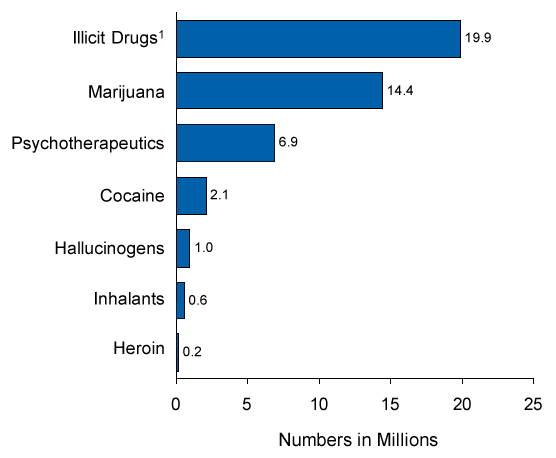
1
Illicit Drugs include marijuana/hashish, cocaine (including crack), heroin,
hallucinogens, inhalants, or prescription-type psychotherapeutics used
nonmedically.
Below is a line graph.
Click here for the text describing this graph.
Figure 2.2 Past Month
Use of Selected Illicit Drugs among Persons Aged 12 or Older: 2002-2007
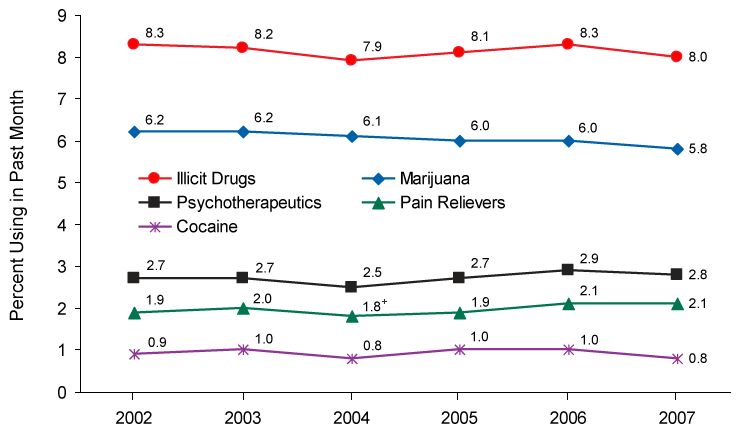
+
Difference between this estimate and the 2007 estimate is statistically significant
at the .05 level.
- Marijuana was the most
commonly used illicit drug (14.4 million past month users). In 2007, marijuana
was used by 72.8 percent of current illicit drug users and was the
only drug used by 53.3 percent of them. Illicit drugs other than marijuana
were used by 9.3 million persons or 46.7 percent of illicit drug users
aged 12 or older. Current use of other drugs but not marijuana was reported
by 27.2 percent of illicit drug users, and 19.4 percent used both
marijuana and other drugs.
- Among persons aged
12 or older, the overall rate of past month marijuana use in 2007 (5.8 percent)
was similar to the rate in 2006 and the rates in earlier years going back
to 2002 (Figure 2.2).
- An estimated 9.3 million
people aged 12 or older (3.7 percent) were current users of illicit
drugs other than marijuana in 2007. Most (6.9 million persons, or 2.8 percent
of the population) used psychotherapeutic drugs nonmedically. In addition
to the estimated 5.2 million nonmedical users of pain relievers in 2007,
1.8 million used tranquilizers, 1.1 million used stimulants, and 346,000
used sedatives. The numbers of nonmedical users of pain relievers, tranquilizers,
and sedatives in 2007 were similar to the corresponding numbers in 2006,
and the percentage rates also remained stable (Figure 2.3).
However, the number and percentage of nonmedical stimulant users decreased
from 2006 to 2007.
Below is a line graph.
Click here for the text describing this graph.
Figure 2.3 Past Month
Nonmedical Use of Types of Psychotherapeutic Drugs among Persons Aged 12 or
Older: 2002-2007
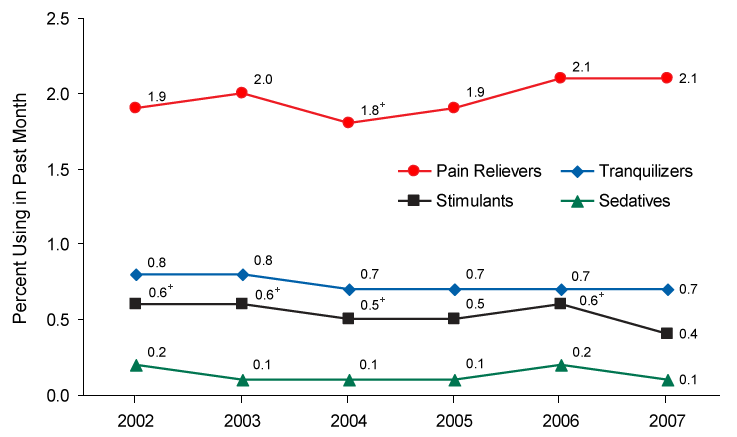
+
Difference between this estimate and the 2007 estimate is statistically significant
at the .05 level.
- The estimated number
and percentage of persons aged 12 or older who used cocaine in the past
month in 2007 (2.1 million users or 0.8 percent of the population) were
similar to those in 2006 (2.4 million or 1.0 percent) and 2002 (2.0
million or 0.9 percent). The number of past month crack users was also
similar over this period (610,000 in 2007 vs. 702,000 in 2006 and 567,000
in 2002).
- Hallucinogens were
used in the past month by 1.0 million persons aged 12 or older (0.4 percent)
in 2007, including 503,000 (0.2 percent) who had used Ecstasy. These
estimates are similar to the corresponding estimates for 2006. However,
lifetime use of Ecstasy increased from 10.2 million persons (4.3 percent)
in 2002 to 12.4 million (5.0 percent) in 2007, while past year use
of Ecstasy decreased from 3.2 million (1.3 percent) to 2.1 million
(0.9 percent) over the same period.
- The number of current
heroin users decreased from 338,000 in 2006 to 153,000 in 2007, and the
corresponding prevalence rate decreased from 0.14 to 0.06 percent.
- In both 2006 and 2007,
an estimated 5.2 million persons aged 12 or older (2.1 percent in each
year) were current nonmedical users of prescription pain relievers (Figure 2.3).
This number was higher than the estimated 4.4 million in 2002, but the difference
between the rates in 2002 and 2007 (1.9 and 2.1 percent, respectively)
was not statistically significant. However, the rate was higher in 2007
(2.1 percent) than in 2004 (1.8 percent).
- In 2007, the estimated
number of past month nonmedical users of stimulants aged 12 or older, 1.1
million, was lower than it had been in 2006 (1.4 million); the corresponding
rates also showed a decline (from 0.6 percent in 2006 to 0.4 percent
in 2007). These numbers for stimulants included 529,000 persons (0.2 percent)
who were current users of methamphetamine in 2007, similar to the number
and rate in 2006 (731,000 persons or 0.3 percent of the population).
However, the estimated number of past year methamphetamine users declined
from 1.9 million in 2006 to 1.3 million in 2007, and the corresponding rate
declined from 0.8 to 0.5 percent.
Age
- In 2007, rates of past
month illicit drug use varied with age. Through the adolescent years from
12 to 17, the rates of current illicit drug use increased from 3.3 percent
at ages 12 or 13 to 8.9 percent at ages 14 or 15 to 16.0 percent
at ages 16 or 17 (Figure 2.4).
The highest rate was among persons aged 18 to 20 (21.6 percent). The
rate was 18.5 percent among those aged 21 to 25, 12.8 percent
among those aged 26 to 29, and 0.7 percent among those aged 65 or older.
Below is a bar graph.
Click here for the text describing this graph.
Figure 2.4 Past Month
Illicit Drug Use among Persons Aged 12 or Older, by Age: 2007
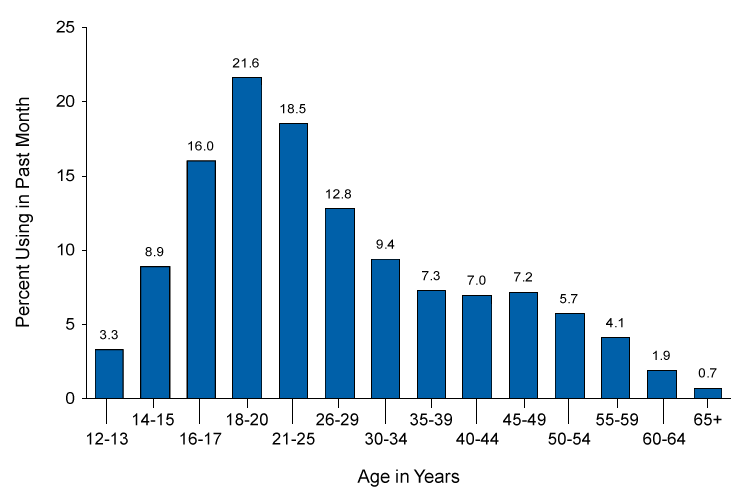
- Although adults aged
26 or older were less likely to be current drug users in 2007 than youths
aged 12 to 17 or young adults aged 18 to 25 (5.8 vs. 9.5 and 19.7 percent,
respectively), there were more drug users aged 26 or older (11.0 million)
than in the 12-to-17-year age group (2.4 million) and 18-to-25-year
age group (6.5 million) combined.
- Current illicit drug
use remained stable from 2006 to 2007 among youths aged 12 to 17, young
adults aged 18 to 25, and adults aged 26 or older. From 2002 to 2007, however,
the rate of current illicit drug use among 12 to 17 year olds decreased
from 11.6 to 9.5 percent (Figure 2.5).
Below is a line graph.
Click here for the text describing this graph.
Figure 2.5 Past Month
Use of Selected Illicit Drugs among Youths Aged 12 to 17: 2002-2007
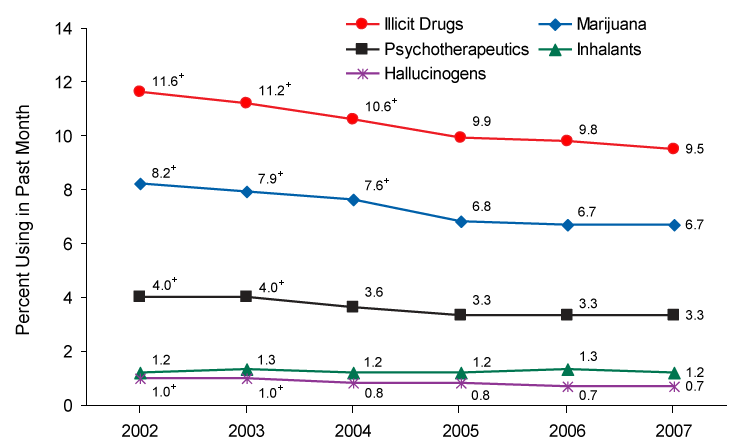
+
Difference between this estimate and the 2007 estimate is statistically significant
at the .05 level.
Youths Aged 12 to 17
- In 2007, 9.5 percent
of youths aged 12 to 17 were current illicit drug users: 6.7 percent
used marijuana, 3.3 percent engaged in nonmedical use of prescription-type
psychotherapeutics, 1.2 percent used inhalants, 0.7 percent used
hallucinogens, and 0.4 percent used cocaine.
- Among youths aged 12
to 17, the types of drugs used in the past month varied by age group. Among
12 or 13 year olds, 1.4 percent used prescription-type drugs nonmedically,
1.1 percent used inhalants, and 0.9 percent used marijuana. Among
14 or 15 year olds, marijuana was the most commonly used drug (5.7 percent),
followed by prescription-type drugs used nonmedically (3.4 percent),
and then inhalants (1.4 percent). Marijuana also was the most commonly
used drug among 16 or 17 year olds (13.1 percent), followed by prescription-type
drugs used nonmedically (4.9 percent), and then hallucinogens (1.2 percent),
inhalants (1.0 percent), and cocaine (0.9 percent).
- Rates of current use
remained stable from 2006 to 2007 among youths aged 12 to 17 for all drugs
except use of heroin, which decreased from 0.06 to 0.01 percent, and
nonmedical use of tranquilizers, which increased from 0.5 to 0.7 percent.
- From 2002 to 2007,
rates of current use among youths aged 12 to 17 declined significantly for
illicit drugs overall and for several specific drugs, including marijuana,
cocaine, hallucinogens, LSD, Ecstasy, prescription-type drugs used
nonmedically, pain relievers, stimulants, methamphetamine, and the use of
illicit drugs other than marijuana (Figure 2.5).
For illicit drug use overall, the rates were 11.6 percent in 2002,
11.2 percent in 2003, 10.6 percent in 2004, 9.9 percent in
2005, 9.8 percent in 2006, and 9.5 percent in 2007.
- The rate of current
marijuana use among youths aged 12 to 17 decreased from 8.2 percent
in 2002 to 6.7 percent in 2007. Significant declines were also evident
between 2002 and 2007 for past year marijuana use (from 15.8 to 12.5 percent)
and lifetime marijuana use (from 20.6 to 16.2 percent).
- Current use of illicit
drugs other than marijuana among 12 to 17 year olds declined from 5.7 percent
in 2002 to 4.7 percent in 2007. Over the same period, past month nonmedical
use of psychotherapeutic drugs decreased from 4.0 to 3.3 percent, nonmedical
use of pain relievers declined from 3.2 to 2.7 percent, nonmedical
use of stimulants decreased from 0.8 to 0.5 percent, and methamphetamine
use declined from 0.3 to 0.1 percent. Youths' current use of hallucinogens
declined from 1.0 percent in 2002 to 0.7 percent in 2007, reflecting
decreases in current use of Ecstasy (from 0.5 to 0.3 percent) and LSD
(from 0.2 to 0.1 percent).
Young Adults Aged 18
to 25
- Rates of current use
of illicit drugs in 2007 were higher for young adults aged 18 to 25 (19.7 percent)
than for youths aged 12 to 17 (9.5 percent) and adults aged 26 or older
(5.8 percent). Among young adults, 16.4 percent used marijuana,
6.0 percent used prescription-type drugs nonmedically, 1.7 percent
used cocaine, and 1.5 percent used hallucinogens (Figure 2.6).
Below is a line graph.
Click here for the text describing this graph.
Figure 2.6 Past Month
Use of Selected Illicit Drugs among Young Adults Aged 18 to 25: 2002-2007
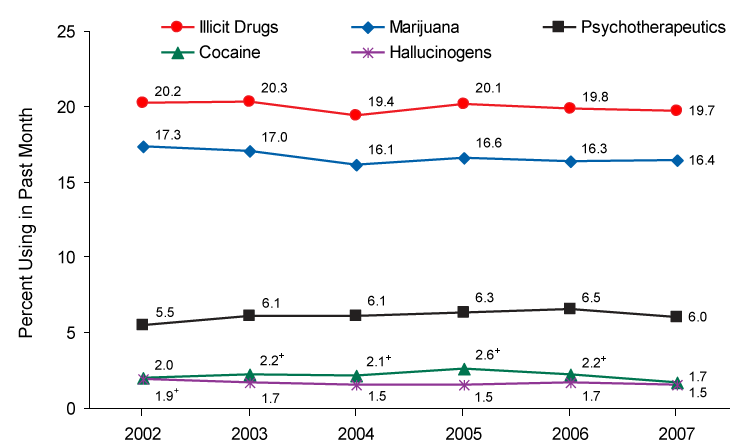
+
Difference between this estimate and the 2007 estimate is statistically significant
at the .05 level.
- From 2006 to 2007,
current use of several illicit drugs declined among young adults aged 18
to 25. Use of cocaine decreased from 2.2 to 1.7 percent, Ecstasy use
declined from 1.0 to 0.7 percent, stimulant use went from 1.4 to 1.1 percent,
methamphetamine use declined from 0.6 to 0.4 percent, and use of illicit
drugs other than marijuana decreased from 8.9 to 8.1 percent.
- From 2002 to 2007,
the rate of current use of prescription pain relievers among young adults
aged 18 to 25 increased from 4.1 to 4.6 percent. Past month use of hallucinogens
overall decreased from 1.9 to 1.5 percent, and use of Ecstasy decreased
from 1.1 to 0.7 percent; however, use of LSD increased from 0.1 to
0.2 percent. A decline also was seen in current use of methamphetamine
(0.6 percent in 2002 vs. 0.4 percent in 2007).
Adults Aged 26 or Older
- Among adults aged 26
or older, 5.8 percent reported current illicit drug use in 2007. In
this age group, 3.9 percent used marijuana and 2.2 percent used
prescription-type drugs nonmedically. Less than 1 percent used
cocaine (0.7 percent), hallucinogens (0.2 percent), heroin (0.1
percent), and inhalants (0.1 percent). The only significant change
between 2006 and 2007 in the rates of past month use among adults in this
age group involved heroin, which decreased from 0.14 to 0.05 percent.
Lifetime use of marijuana among adults aged 26 or older increased from 40.6 percent
in 2006 to 42.0 percent in 2007, while past year nonmedical use of
stimulants declined from 1.0 to 0.8 percent and past year use of methamphetamine
decreased from 0.6 to 0.4 percent.
- Among adults aged 50
to 59, the rate of current illicit drug use showed an irregular increasing
trend between 2002 and 2007 (Figure 2.7).
For those aged 50 to 54, the rate increased from 3.4 in 2002 to 6.0 percent
in 2006, then ended at 5.7 percent in 2007, not significantly different
from the rate in 2006. Among those aged 55 to 59, current illicit drug use
also showed an irregular trend with an overall increase from 1.9 percent
in 2002 to 4.1 percent in 2007. These patterns and trends may partially
reflect the aging into these age groups of the baby boom cohort, whose lifetime
rates of illicit drug use are higher than those of older cohorts.
Below is a line graph.
Click here for the text describing this graph.
Figure 2.7 Past Month
Illicit Drug Use among Adults Aged 50 to 59: 2002-2007
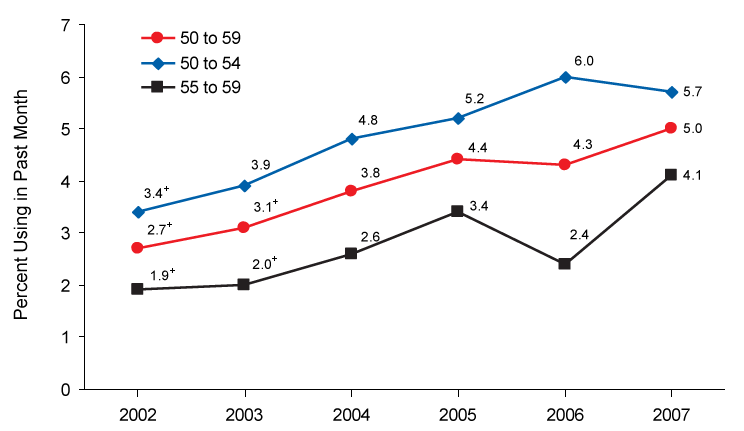
+
Difference between this estimate and the 2007 estimate is statistically significant
at the .05 level.
Gender
- In 2007, as in prior
years, the rate of current illicit drug use among persons aged 12 or older
was higher for males than for females (10.4 vs. 5.8 percent, respectively).
Males were about twice as likely as females to be past month marijuana users
(8.0 vs. 3.8 percent). However, males and females had similar rates
of past month use of tranquilizers (0.8 and 0.7 percent for males and
females, respectively), stimulants (0.4 percent for males and 0.5 percent
for females), methamphetamine (0.2 percent for both males and females),
sedatives (0.2 percent for males and 0.1 percent for females), and
OxyContin® (0.2 percent for males and 0.1 percent
for females).
- From 2006 to 2007,
the rate of current heroin use decreased from 0.06 to 0.02 percent
among females aged 12 or older, and the rate of current nonmedical use of
stimulants declined from 0.6 to 0.4 percent among males in that age
group.
- Among youths aged 12
to 17 in 2007, males and females had similar rates of current use of illicit
drugs (10.0 percent for males and 9.1 percent for females), cocaine
(0.4 and 0.5 percent, respectively), crack (0.03 and 0.09 percent),
hallucinogens (0.8 and 0.6 percent), and inhalants (1.2 and 1.1 percent).
Rates also were similar for nonmedical use of prescription psychotherapeutic
drugs (3.0 and 3.5 percent for males and females, respectively) and
prescription pain relievers (2.5 and 2.8 percent). Current marijuana
use, however, was more common among male youths (7.5 percent) than
female youths (5.8 percent).
- Past month marijuana
use among male youths aged 12 to 17 declined from 9.1 percent in 2002
to 6.8 percent in 2006. In 2007, the rate was 7.5 percent, which
was not significantly different from the rate in 2006, but was lower than
the rate in 2002 (Figure 2.8).
Among female youths, little change occurred from 2002 to 2004, but the rate
in 2007 (5.8 percent) was lower than the rate in 2002 (7.2 percent).
Below is a line graph.
Click here for the text describing this graph.
Figure 2.8 Past Month
Marijuana Use among Youths Aged 12 to 17, by Gender: 2002-2007
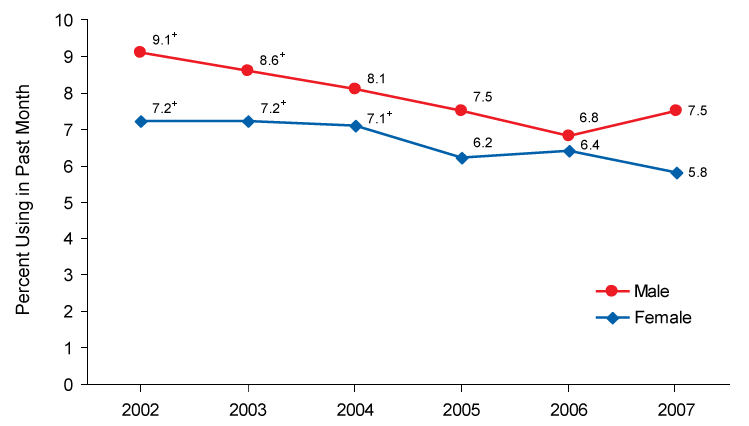
+
Difference between this estimate and the 2007 estimate is statistically significant
at the .05 level.
Pregnant Women
- Among pregnant women
aged 15 to 44 years, an average of 5.2 percent used illicit drugs in
the past month based on combined 2006 and 2007 NSDUH data. This rate was
significantly lower than the rate among women in that age group who were
not pregnant (9.7 percent). Among pregnant women, the average rate
of current illicit drug use did not change significantly between 2004-2005
(3.9 percent) and 2006-2007 (5.2 percent).
- The rate of current
illicit drug use in the combined 2006-2007 data was lower for pregnant
women than for nonpregnant women among those aged 18 to 25 (7.2 vs. 16.0 percent,
respectively) and among those aged 26 to 44 (3.0 vs. 6.5 percent).
Among women aged 15 to 17, however, those who were pregnant had a higher
rate of use (22.6 percent) than those who were not pregnant (13.3 percent).
For nonpregnant women aged 15 to 17, current illicit drug use decreased
from 14.7 to 13.3 percent between 2004-2005 and 2006-2007.
Race/Ethnicity
- Current illicit drug
use varied by race/ethnicity in 2007 among persons aged 12 or older, with
the lowest rate among Asians (4.2 percent) (Figure 2.9).
Rates were 12.6 percent for American Indians or Alaska Natives, 11.8 percent
for persons reporting two or more races, 9.5 percent for blacks, 8.2 percent
for whites, and 6.6 percent for Hispanics.
- There were no statistically
significant changes between 2006 and 2007 in the rate of current illicit
drug use for any racial/ethnic group among persons aged 12 or older.
Below is a bar graph.
Click here for the text describing this graph.
Figure 2.9 Past Month
Illicit Drug Use among Persons Aged 12 or Older, by Race/Ethnicity: 2007
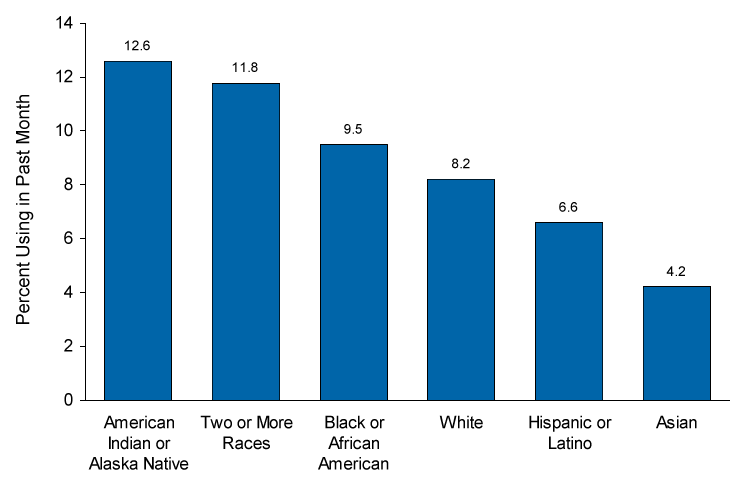
Note:
Due to low precision, the estimate for Native Hawaiians or Other Pacific Islanders
is not shown.
Education
- Illicit drug use in
2007 varied by educational status. Among adults aged 18 or older, the rate
of current illicit drug use was lower for college graduates (5.1 percent)
than for those who did not graduate from high school (9.3 percent),
high school graduates (8.6 percent), and those with some college (8.9 percent).
However, adults who had graduated from college were more likely to have
tried illicit drugs in their lifetime when compared with adults who had
not completed high school (51.8 vs. 36.0 percent). Rates of current
illicit drug use remained stable from 2006 to 2007 for each category of
education among adults.
College Students
- Among persons aged
18 to 22 years old, the rate of current use of illicit drugs in 2007 was
lower among full-time college students (19.8 percent) than among
other persons in that age group (22.8 percent), which includes part-time
college students, students in other grades, and nonstudents. Current illicit
drug use among college students and other 18 to 22 year olds did not change
between 2006 and 2007.
- Among full-time
college students aged 18 to 22, there were declines from 2006 to 2007 in
the current rate of use of hallucinogens (from 1.9 to 1.0 percent),
Ecstasy (1.2 to 0.5 percent), and methamphetamine (0.3 to 0.1 percent).
Among persons aged 18 to 22 who were not full-time college students,
there were decreases in the rate of cocaine use (from 2.7 to 2.1 percent)
and nonmedical use of stimulants (from 1.5 to 0.9 percent).
Employment
- Current illicit drug
use differed by employment status in 2007. Among adults aged 18 or older,
the rate of drug use was higher for unemployed persons (18.3 percent)
than for those who were employed full time (8.4 percent) or part time
(10.1 percent) (Figure 2.10).
These rates were all similar to the corresponding rates in 2006.
Below are two bar graphs.
Click here for the text describing these graphs.
Figure 2.10 Past Month
Illicit Drug Use among Persons Aged 18 or Older, by Employment Status: 2007
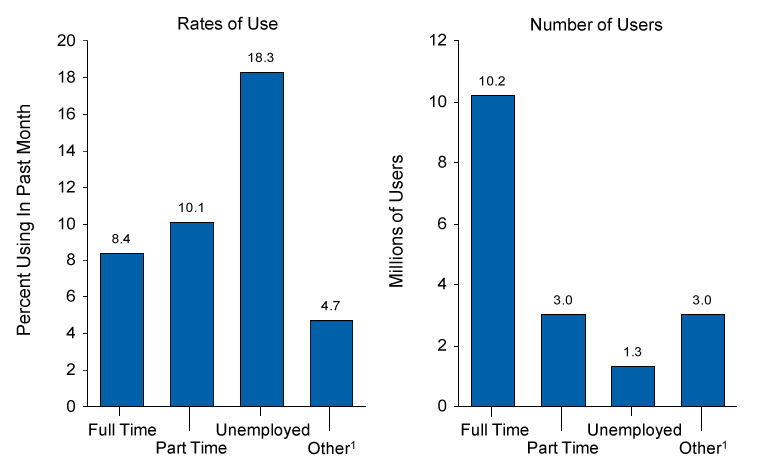
1
The Other Employment category includes retired persons, disabled persons,
homemakers, students, or other persons not in the labor force.
- Although the rate of
past month illicit drug use was higher among unemployed persons compared
with those from other employment groups, most drug users were employed.
Of the estimated 17.4 million current illicit drug users aged 18 or older
in 2007, 13.1 million (75.3 percent) were employed either full or part
time.
Geographic Area
- Among persons aged
12 or older, the rate of current illicit drug use in 2007 was 9.3 percent
in the West, 7.9 percent in the Midwest, 7.8 percent in the Northeast,
and 7.4 percent in the South.
- Among youths aged 12
to 17, current marijuana use declined from 2002 to 2007 in each region,
although the difference was not significant in the West. In the Northeast,
marijuana use rates declined from 9.5 percent in 2002 to 7.2 percent
in 2007. In the Midwest, the rate declined from 8.1 percent in 2002
to 6.9 percent in 2005 and remained stable through 2007. In the South,
the rate decreased from 2002 to 2004 and then remained reasonably stable
through 2007. In the West, the rate did not change significantly from 2002
through 2004 (8.0 percent in 2002, 8.7 percent in 2003, and 9.3 percent
in 2004), but then declined to 6.8 percent in 2005 and remained around
that level through 2007.
- In 2007, the rate of
current illicit drug use among persons aged 12 or older was higher in metropolitan
areas than in nonmetropolitan areas. The rates were 8.3 percent in
large metropolitan counties, 8.2 percent in small metropolitan counties,
and 6.7 percent in nonmetropolitan counties as a group (Figure 2.11).
Within nonmetropolitan areas, the rate was 7.5 percent in urbanized
counties, 6.7 percent in less urbanized counties, and 4.1 percent
in completely rural counties.
- The rate of current
illicit drug use among the population aged 12 or older in completely rural
counties in 2007 (4.1 percent) was lower than that observed in 2006
(7.8 percent).
Below is a bar graph.
Click here for the text describing this graph.
Figure 2.11 Past Month
Illicit Drug Use among Persons Aged 12 or Older, by County Type: 2007
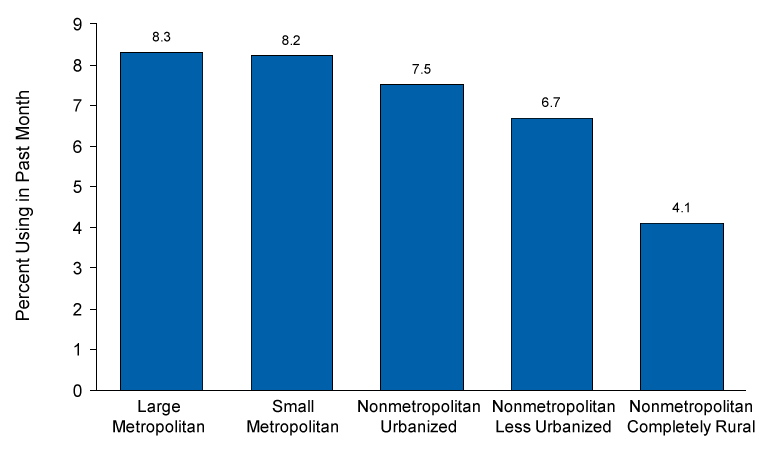
Criminal Justice Populations
- In 2007, there were
an estimated 1.6 million adults aged 18 or older on parole or other supervised
release from prison during the past year. Almost one fourth of these (24.1 percent)
were current illicit drug users, higher than the 7.7 percent among
adults not on parole or supervised release.
- Among the 5.1 million
adults on probation at some time in the past year, 28.4 percent reported
current illicit drug use in 2007. This was higher than the rate of 7.4 percent
among adults not on probation in 2007.
Frequency of Use
- In 2007, an estimated
14.2 percent of past year marijuana users aged 12 or older used marijuana
on 300 or more days within the past 12 months. This translates into 3.6
million using marijuana on a daily or almost daily basis over a 12-month
period, higher than the estimate of 3.1 million (12.3 percent of past
year users) in 2006. Among past month marijuana users aged 12 or older,
35.3 percent (5.1 million) used the drug on 20 or more days in the
past month.
Association with Cigarette
and Alcohol Use
- In 2007, the rate of
current illicit drug use was almost 9 times higher among youths aged 12
to 17 who smoked cigarettes in the past month (47.3 percent) than it
was among youths who did not smoke cigarettes in the past month (5.4 percent).
- Past month illicit
drug use also was associated with the level of past month alcohol use. Among
youths aged 12 to 17 in 2007 who were heavy drinkers (i.e., consumed five
or more drinks on the same occasion on each of 5 or more days in the past
30 days), 60.1 percent also were current illicit drug users, which
was higher than the rate among nondrinkers (5.0 percent).
Driving Under the Influence
of Illicit Drugs
- In 2007, 9.9 million
persons aged 12 or older reported driving under the influence of illicit
drugs during the past year. This corresponds to 4.0 percent of the
population in that age group, similar to the rate in 2006 (4.2 percent),
but lower than the rate in 2002 (4.7 percent). In 2007, the rate was highest
among young adults aged 18 to 25 (12.5 percent).
Source of Prescription
Drugs
- Past year nonmedical
users of prescription-type psychotherapeutic drugs are asked how they
obtained the drugs they recently used nonmedically. In both 2006 and 2007,
over half of the nonmedical users of prescription-type pain relievers,
tranquilizers, stimulants, and sedatives aged 12 or older said they got
the drugs they used most recently "from a friend or relative for free."
In a follow-up question, the majority of these respondents indicated
that their friend or relative had obtained the drugs from one doctor.
- Among persons aged
12 or older in 2007 who used pain relievers nonmedically in the past 12
months, 56.5 percent said they got the pain relievers they most recently
used from a friend or relative for free. Another 8.9 percent bought
them from a friend or relative, and 5.2 percent reported stealing them
from a friend or relative. Nearly one fifth (18.1 percent) indicated
that they got the drugs from one doctor. Around 1 in 20 users (4.1 percent)
got pain relievers from a drug dealer or other stranger, and 0.5 percent
said they bought them on the Internet.
- In 81.0 percent
of the cases in 2007 where nonmedical users of prescription pain relievers
aged 12 or older obtained the drugs from a friend or relative for free,
the individuals indicated that their friend or relative had obtained them
from just one doctor. Only 1.8 percent reported that the friend or
relative had bought the drugs from a drug dealer or other stranger.
- In 2007, 44.3 percent
of past year methamphetamine users aged 12 or older reported that they obtained
the methamphetamine they used most recently from a friend or relative for
free. Another 30.4 percent bought it from a friend or relative. Around
one in five users (19.8 percent) bought it from a drug dealer or other
stranger.
3. Alcohol
Use
The National Survey on
Drug Use and Health (NSDUH) includes questions about the recency and frequency
of consumption of alcoholic beverages, such as beer, wine, whiskey, brandy,
and mixed drinks. An extensive list of examples of the kinds of beverages
covered is given to respondents prior to the question administration. A "drink"
is defined as a can or bottle of beer, a glass of wine or a wine cooler, a
shot of liquor, or a mixed drink with liquor in it. Times when the respondent
only had a sip or two from a drink are not considered to be consumption. For
this report, estimates for the prevalence of alcohol use are reported primarily
at three levels defined for both males and females and for all ages as follows:
Current
(past month) use - At least one drink in the past 30 days.
Binge
use - Five or more drinks on the same occasion (i.e., at the
same time or within a couple of hours of each other) on at least 1 day in
the past 30 days.
Heavy
use - Five or more drinks on the same occasion on each of 5
or more days in the past 30 days.
These levels are not mutually
exclusive categories of use; heavy use is included in estimates of binge and
current use, and binge use is included in estimates of current use.
This chapter is divided
into two main sections. Section 3.1
describes trends and patterns of alcohol use among the population aged 12
or older. Section 3.2 is particularly
concerned with the use of alcohol by persons aged 12 to 20. These persons
are under the legal drinking age in all 50 States and the District of Columbia.
3.1. Alcohol Use among
Persons Aged 12 or Older
- Slightly more than
half of Americans aged 12 or older reported being current drinkers of alcohol
in the 2007 survey (51.1 percent). This translates to an estimated
126.8 million people, which is similar to the 2006 estimate of 125.3 million
people (50.9 percent).
- More than one fifth
(23.3 percent) of persons aged 12 or older participated in binge drinking
at least once in the 30 days prior to the survey in 2007. This translates
to about 57.8 million people. The rate in 2007 is similar to the rate in
2006 (23.0 percent).
- In 2007, heavy drinking
was reported by 6.9 percent of the population aged 12 or older, or
17.0 million people. This percentage is the same as the rate of heavy drinking
in 2006 (6.9 percent).
Age
- In 2007, rates of current
alcohol use were 3.5 percent among persons aged 12 or 13, 14.7 percent
of persons aged 14 or 15, 29.0 percent of 16 or 17 year olds, 50.7 percent
of those aged 18 to 20, and 68.3 percent of 21 to 25 year olds (Figure 3.1).
Among older age groups, the prevalence of current alcohol use decreased
with increasing age, from 63.2 percent among 26 to 29 year olds to 47.6 percent
among 60 to 64 year olds and 38.1 percent among people aged 65 or older.
Below is a bar graph.
Click here for the text describing this graph.
Figure 3.1 Current, Binge,
and Heavy Alcohol Use among Persons Aged 12 or Older, by Age: 2007
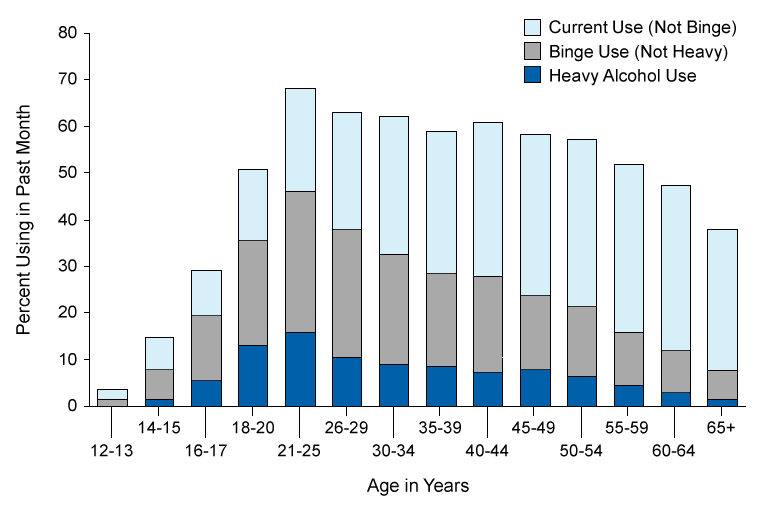
- Rates of binge alcohol
use in 2007 were 1.5 percent among 12 or 13 year olds, 7.8 percent
among 14 or 15 year olds, 19.4 percent among 16 or 17 year olds, 35.7 percent
among persons aged 18 to 20, and peaked among those aged 21 to 25 at 45.9 percent.
The rate decreased beyond young adulthood from 35.1 percent of 26 to
34 year olds to 18.9 percent of persons aged 35 or older.
- The rate of binge drinking
was 41.8 percent for young adults aged 18 to 25. Heavy alcohol use
was reported by 14.7 percent of persons aged 18 to 25. These rates
are similar to the rates in 2006 (42.2 and 15.6 percent, respectively).
- Persons aged 65 or
older had lower rates of binge drinking (7.6 percent) than adults in
other age groups. The rate of heavy drinking among persons aged 65 or older
was 1.4 percent.
- The rate of current
alcohol use among youths aged 12 to 17 was 15.9 percent in 2007. Youth
binge and heavy drinking rates were 9.7 and 2.3 percent, respectively.
These rates are essentially the same as the 2006 rates (16.6, 10.3, and
2.4 percent, respectively).
Gender
- In 2007, 56.6 percent
of males aged 12 or older were current drinkers, higher than the rate for
females (46.0 percent). However, among youths aged 12 to 17, the percentage
of males who were current drinkers (15.9 percent) was similar to the
rate for females (16.0 percent).
- Among adults aged 18
to 25, an estimated 57.1 percent of females and 65.3 percent of
males reported current drinking in 2007. These rates are similar to those
reported in 2006 (57.9 and 65.9 percent, respectively).
Pregnant Women
- Among pregnant women
aged 15 to 44, an estimated 11.6 percent reported current alcohol use,
3.7 percent reported binge drinking, and 0.7 percent reported heavy
drinking. These rates were significantly lower than the rates for nonpregnant
women in the same age group (53.2, 24.1, and 5.5 percent, respectively).
Binge drinking during the first trimester of pregnancy was reported by 6.6 percent
of pregnant women aged 15 to 44. All of these estimates by pregnancy status
are based on data averaged over 2006 and 2007.
Race/Ethnicity
- Among persons aged
12 or older, whites in 2007 were more likely than other racial/ethnic groups
to report current use of alcohol (56.1 percent) (Figure 3.2).
The rates were 47.5 percent for persons reporting two or more races,
44.7 percent for American Indians or Alaska Natives, 42.1 percent
for Hispanics, 39.3 percent for blacks, and 35.2 percent for Asians.
Below is a bar graph.
Click here for the text describing this graph.
Figure 3.2 Current, Binge,
and Heavy Alcohol Use among Persons Aged 12 or Older, by Race/Ethnicity: 2007
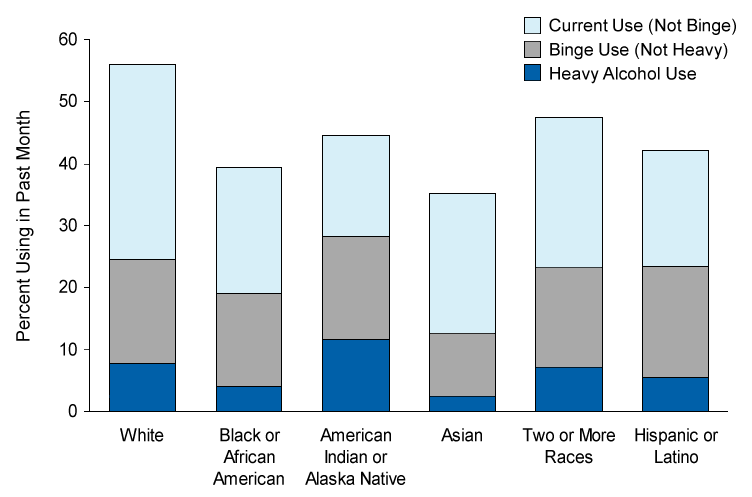
Note:
Due to low precision, estimates for Native Hawaiians or Other Pacific Islanders
are not shown.
- The rate of binge alcohol
use was lowest among Asians (12.6 percent). Rates for other racial/ethnic
groups were 19.1 percent for blacks, 23.2 percent for persons
reporting two or more races, 23.4 percent for Hispanics, 24.6 percent
for whites, and 28.2 percent for American Indians or Alaska Natives.
- Among youths aged 12
to 17 in 2007, whites had higher rates of current alcohol use than any other
racial/ethnic group. In 2007, 18.2 percent of white youths were current
drinkers, while 8.1 percent of Asian youths, 10.1 percent of black
youths, 12.5 percent of those reporting two or more races, and 15.2 percent
of Hispanic youths used alcohol in the past month.
Education
- Among adults aged 18
or older, the rate of past month alcohol use increased with increasing levels
of education. Among adults with less than a high school education, 36.5 percent
were current drinkers in 2007, significantly lower than the 68.5 percent
of college graduates who were current drinkers. However, among adults aged
26 or older, binge and heavy alcohol use rates were lower among college
graduates (20.1 and 4.8 percent, respectively) than among those who
had not completed college (22.7 vs. 6.7 percent, respectively).
College Students
- Young adults aged 18
to 22 enrolled full time in college were more likely than their peers not
enrolled full time (i.e., part-time college students and persons not
currently enrolled in college) to use alcohol in the past month, binge drink,
and drink heavily. Past month alcohol use was reported by 63.7 percent
of full-time college students compared with 53.5 percent of persons
aged 18 to 22 who were not enrolled full time. Binge and heavy use rates
for college students were 43.6 and 17.2 percent, respectively, compared
with 38.4 and 12.9 percent, respectively, for 18 to 22 year olds not
enrolled full time in college.
- The pattern of higher
rates of current alcohol use, binge alcohol use, and heavy alcohol use among
full-time college students compared with rates for others aged 18 to
22 has remained consistent since 2002 (Figure 3.3).
Below is a line graph.
Click here for the text describing this graph.
Figure 3.3 Heavy Alcohol
Use among Adults Aged 18 to 22, by College Enrollment: 2002-2007
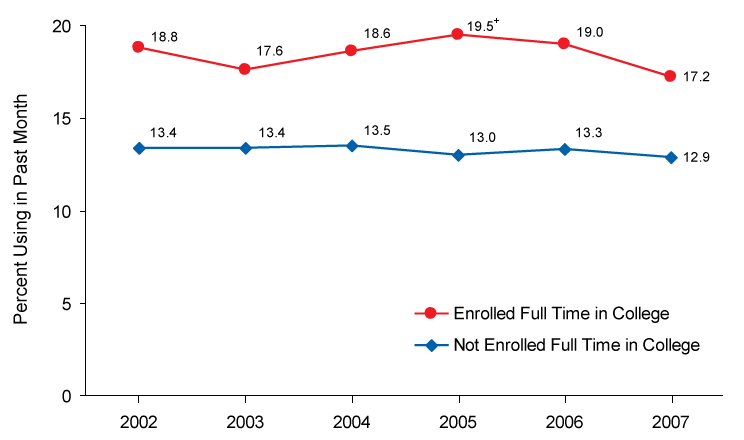
+
Difference between this estimate and the 2007 estimate is statistically significant
at the .05 level.
Employment
- Rates of current alcohol
use were 62.8 percent for full-time employed adults aged 18 or
older in 2007, higher than the rate for unemployed adults (56.9 percent).
However, the rate of heavy use for unemployed persons was 12.0 percent,
which was higher than the rate of 8.8 percent for full-time employed
persons. There was no significant difference in binge alcohol use rates
between full-time employed adults (30.2 percent) and unemployed
adults (32.2 percent).
- Most binge and heavy
alcohol users were employed in 2007. Among 55.3 million adult binge drinkers,
44.0 million (79.4 percent) were employed either full or part time.
Among 16.4 million heavy drinkers, 13.1 million (79.6 percent) were
employed.
Geographic Area
- The rate of past month
alcohol use for people aged 12 or older in 2007 was lower in the South (46.8 percent)
than in the Northeast (56.0 percent), Midwest (54.6 percent), or West
(50.8 percent).
- Among people aged 12
or older, the rate of past month alcohol use in large metropolitan areas
(53.5 percent) was higher than the 50.9 percent in small metropolitan
areas and 44.0 percent in nonmetropolitan areas. Binge drinking was
equally prevalent in small metropolitan areas (23.4 percent), large metropolitan
areas (23.3 percent), and nonmetropolitan areas (23.0 percent).
The rate of binge alcohol use in nonmetropolitan urbanized areas increased
from 21.9 percent in 2006 to 25.7 percent in 2007.
- The rates of binge
alcohol use among youths aged 12 to 17 were 11.6 percent in nonmetropolitan
areas, 9.4 percent in small metropolitan areas, and 9.3 percent
in large metropolitan areas.
Association with Illicit
Drug and Tobacco Use
- The level of alcohol
use was associated with illicit drug use in 2007. Among the 17.0 million
heavy drinkers aged 12 or older, 31.3 percent were current illicit drug
users. Persons who were not current alcohol users were less likely to have
used illicit drugs in the past month (3.4 percent) than those who reported
(a) current use of alcohol but did not meet the criteria for binge or heavy
use (5.5 percent), (b) binge use but did not meet the criteria for
heavy use (16.1 percent), or (c) heavy use of alcohol (31.3 percent).
- Alcohol consumption
levels also were associated with tobacco use. Among heavy alcohol users
aged 12 or older, 58.1 percent smoked cigarettes in the past month,
while only 19.0 percent of non-binge current drinkers and 16.4 percent
of persons who did not drink alcohol in the past month were current smokers.
Smokeless tobacco use and cigar use also were more prevalent among heavy
drinkers (12.3 and 17.5 percent, respectively) than among non-binge
drinkers (2.0 and 4.3 percent) and nondrinkers (1.9 and 2.2 percent).
Driving Under the Influence
of Alcohol
- In 2007, an estimated
12.7 percent of persons aged 12 or older drove under the influence
of alcohol at least once in the past year (Figure 3.4).
This percentage has dropped slightly since 2002, when it was 14.2 percent.
The 2007 estimate corresponds to 31.4 million persons. From 2006 to 2007,
the rate of driving under the influence of alcohol among young adults aged
18 to 25 decreased from 24.4 to 22.8 percent.
- Driving under the influence
of alcohol was associated with age in 2007. An estimated 7.8 percent
of 16 or 17 year olds, 18.3 percent of 18 to 20 year olds, and 25.8 percent
of 21 to 25 year olds reported driving under the influence of alcohol in
the past year (Figure 3.5).
Beyond age 25, these rates showed a general decline with increasing age.
- Among persons aged
12 or older, males were nearly twice as likely as females (16.6 vs. 9.0 percent)
to drive under the influence of alcohol in the past year.
Below is a bar graph.
Click here for the text describing this graph.
Figure 3.4 Driving Under
the Influence of Alcohol in the Past Year among Persons Aged 12 or Older:
2002-2007
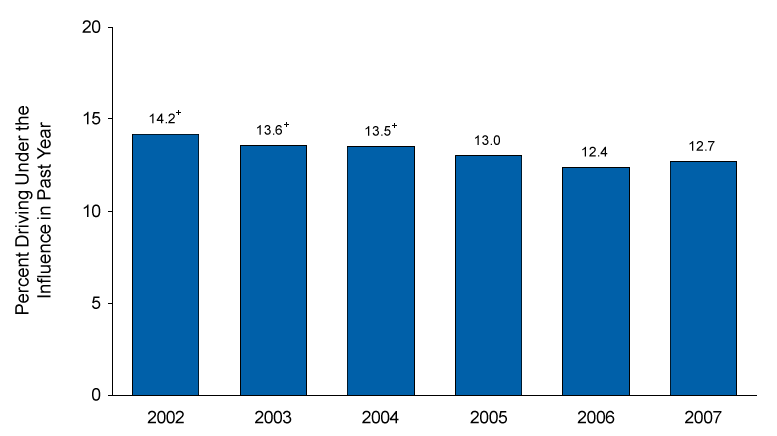
+
Difference between this estimate and the 2007 estimate is statistically significant
at the .05 level.
Below is a bar graph.
Click here for the text describing this graph.
Figure 3.5 Driving Under
the Influence of Alcohol in the Past Year among Persons Aged 16 or Older,
by Age: 2007
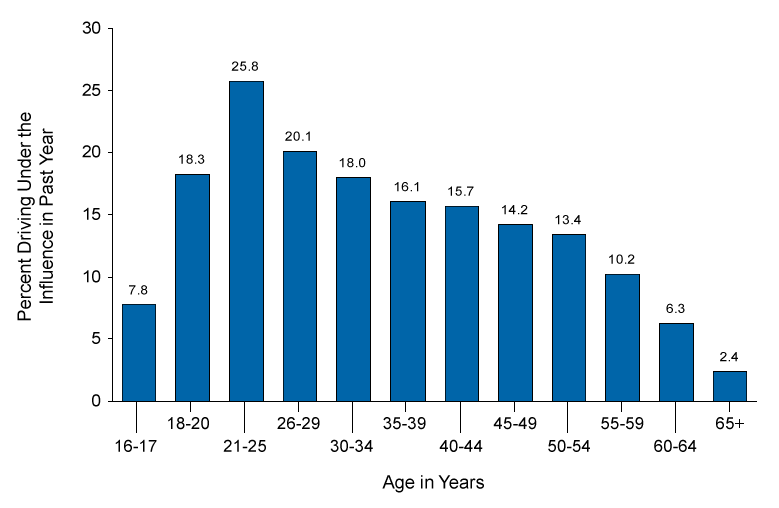
3.2. Underage Alcohol
Use
- In 2007, about 10.7
million persons aged 12 to 20 (27.9 percent of this age group) reported
drinking alcohol in the past month. Approximately 7.2 million (18.6 percent)
were binge drinkers, and 2.3 million (6.0 percent) were heavy drinkers.
These figures have remained essentially the same since the 2002 survey.
- Rates of current alcohol
use increased with increasing age among underage persons. In 2007, 3.5 percent
of persons aged 12 or 13, 14.7 percent of persons aged 14 or 15, 29.0 percent
of 16 or 17 year olds, and 50.7 percent of 18 to 20 year olds drank
alcohol during the 30 days before they were surveyed. This pattern has remained
stable since 2002 (Figure 3.6).
Below is a line graph.
Click here for the text describing this graph.
Figure 3.6 Current Alcohol
Use among Persons Aged 12 to 20, by Age: 2002-2007
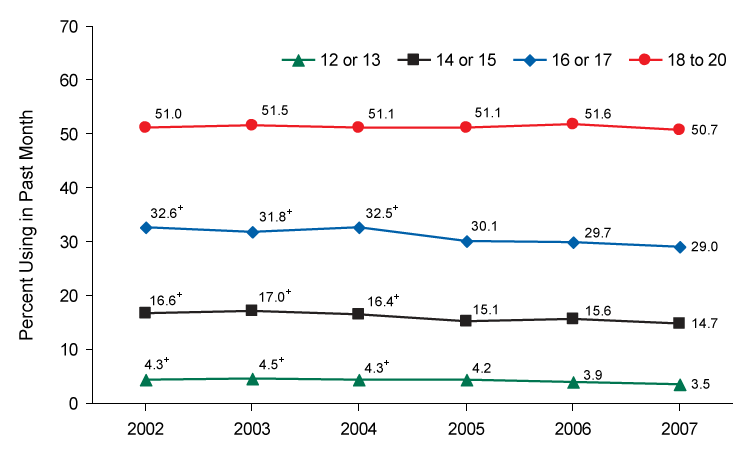
+
Difference between this estimate and the 2007 estimate is statistically significant
at the .05 level.
- More males than females
aged 12 to 20 reported binge drinking (21.1 vs. 16.1 percent) and heavy
drinking (7.8 vs. 4.2 percent) in 2007 (Figure 3.7).
However, rates of current alcohol use were similar by gender (28.4 percent
for males and 27.3 percent for females).
Below is a bar graph.
Click here for the text describing this graph.
Figure 3.7 Current, Binge,
and Heavy Alcohol Use among Persons Aged 12 to 20, by Gender: 2007
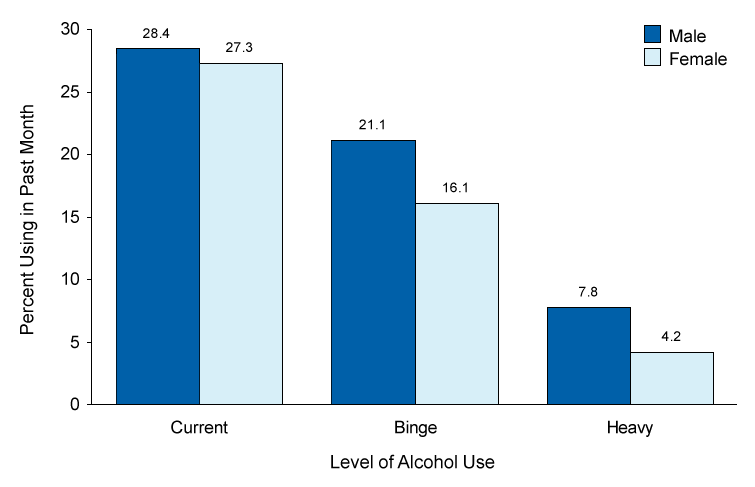
- Among persons aged
12 to 20, past month alcohol use rates in 2007 were 16.8 percent among
Asians, 18.3 percent among blacks, 24.7 percent among Hispanics,
26.2 percent among those reporting two or more races, 28.3 percent
among American Indians or Alaska Natives, and 32.0 percent among whites.
- In 2007, among persons
aged 12 to 20, binge drinking was reported by 22.4 percent of whites,
16.7 percent of Hispanics, and 16.4 percent of persons reporting
two or more races, but only by 9.6 percent of Asians and 8.4 percent
of blacks.
- Across geographic regions
in 2007, underage current alcohol use rates were higher in the Northeast
(31.4 percent) and Midwest (29.1 percent) than in the South (25.7 percent).
The rate in the West (27.3 percent) was similar to rates in the South
and Midwest regions, but was significantly lower than the rate in the Northeast.
- In 2007, underage current
alcohol use rates were higher in small metropolitan areas (29.2 percent)
compared with large metropolitan areas (26.9 percent) and similar in
small metropolitan areas and nonmetropolitan areas (28.8 percent).
The rate in completely rural nonmetropolitan areas was 24.6 percent.
- In 2007, 80.9 percent
of current drinkers aged 12 to 20 were with two or more other people the
last time they drank alcohol, 14.1 percent were with one other person
the last time they drank, and 4.9 percent were alone.
- A majority of underage
current drinkers in 2007 reported that their last use of alcohol in the
past month occurred either in someone else's home (56.3 percent) or
their own home (29.4 percent). Underage males were more likely than
females to have been in their own home on their last drinking occasion (31.3
vs. 27.3 percent), whereas females were more likely than males to have
been in a restaurant, bar, or club on their last drinking occasion (12.8
vs. 6.1 percent).
- Among underage current
drinkers in 2007, 30.2 percent paid for the alcohol the last time they
drank, including 8.2 percent who purchased the alcohol themselves and
21.8 percent who gave money to someone else to purchase it.
- Among underage drinkers
who did not pay for the alcohol the last time they drank, the most common
source was an unrelated person aged 21 or older (37.2 percent). Other
underage persons provided the alcohol on the last occasion 20.7 percent
of the time. Parents, guardians, or other adult family members provided
the alcohol 19.5 percent of the time. Other sources of alcohol for
underage drinkers included (a) took the alcohol from home (5.5 percent),
(b) took it from someone else's home (3.4 percent), and (c) got it
some other way (8.5 percent).
- Underage drinkers were
more likely than persons aged 21 or older to use illicit drugs within 2
hours of alcohol use on their last reported drinking occasion (16.3 vs.
4.5 percent, respectively). The most commonly reported illicit drug
used by underage drinkers in combination with alcohol was marijuana, which
was used within 2 hours of alcohol use by 15.3 percent of current underage
drinkers (1.6 million persons) on their last drinking occasion.
4. Tobacco
Use
The National Survey on
Drug Use and Health (NSDUH) includes a series of questions about the use of
tobacco products, including cigarettes, chewing tobacco, snuff, cigars, and
pipe tobacco. Cigarette use is defined as smoking "part or all of a cigarette."
For analytic purposes, data for chewing tobacco and snuff are combined as
"smokeless tobacco."
- In 2007, an estimated
70.9 million Americans aged 12 or older were current (past month) users
of a tobacco product. This represents 28.6 percent of the population in
that age range. In addition, 60.1 million persons (24.2 percent of
the population) were current cigarette smokers; 13.3 million (5.4 percent)
smoked cigars; 8.1 million (3.2 percent) used smokeless tobacco; and
2.0 million (0.8 percent) smoked tobacco in pipes (Figure 4.1).
- The rate of current
use of any tobacco product among persons aged 12 or older decreased from
29.6 percent in 2006 to 28.6 percent in 2007, but the rates of
current use of cigarettes, smokeless tobacco, cigars, and pipe tobacco did
not change significantly over that period. Between 2002 and 2007, past month
use of any tobacco product decreased from 30.4 to 28.6 percent, and
past month cigarette use declined from 26.0 to 24.2 percent. Rates of past
month use of cigars, smokeless tobacco, and pipe tobacco were similar in
2002 and 2007.
Below is a line graph.
Click here for the text describing this graph.
Figure 4.1 Past Month
Tobacco Use among Persons Aged 12 or Older: 2002-2007
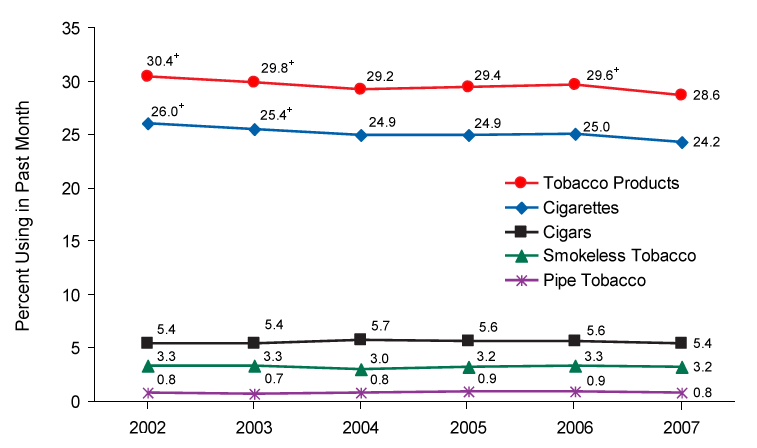
+
Difference between this estimate and the 2007 estimate is statistically significant
at the .05 level.
Age
- Young adults aged 18
to 25 had the highest rate of current use of a tobacco product (41.8 percent)
and of each specific product compared with youths aged 12 to 17 and adults
aged 26 or older. In 2007, the rates of past month use among young adults
were 36.2 percent for cigarettes, 11.8 percent for cigars, 5.3 percent
for smokeless tobacco, and 1.2 percent for pipe tobacco. The rate of
current use of a tobacco product by young adults decreased from 2006 to
2007 (43.9 vs. 41.8 percent), as did the rate of cigarette use (38.4
vs. 36.2 percent). These decreases from 2006 to 2007 in current use
of any tobacco product and cigarettes continue declines seen from 2002 to
2006 among young adults; in 2002, the rates were 45.3 and 40.8 percent,
respectively. However, the rate of current use of cigars by young adults
was higher in 2007 than in 2002 (11.8 vs. 11.0 percent).
- Among youths aged 12
to 17 in 2007, 3.1 million (12.4 percent) used a tobacco product in
the past month, 2.5 million (9.8 percent) used cigarettes, and 1.1
million (4.2 percent) used cigars (Figure 4.2).
The rate of past month cigarette use among 12 to 17 year olds declined from
13.0 percent in 2002 to 9.8 percent in 2007. Past month use of
smokeless tobacco, however, was higher in 2007 (2.4 percent) than in
2002 (2.0 percent).
Below is a line graph.
Click here for the text describing this graph.
Figure 4.2 Past Month
Tobacco Use among Youths Aged 12 to 17: 2002-2007
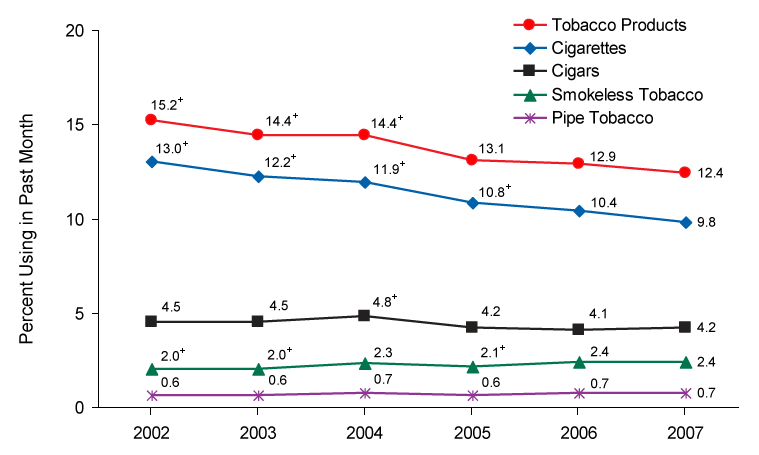
+
Difference between this estimate and the 2007 estimate is statistically significant
at the .05 level.
- In 2007, 1.8 percent
of 12 or 13 year olds, 8.4 percent of 14 or 15 year olds, and 18.9 percent
of 16 or 17 year olds were current cigarette smokers (Figure 4.3).
Across age groups, current cigarette use peaked at 38.5 percent among
persons aged 21 to 25. Less than a quarter (22.0 percent) of persons
aged 35 or older in 2007 smoked cigarettes in the past month. From 2006
to 2007, the rate of current cigarette use decreased among persons aged
18 to 20 (from 35.6 to 32.7 percent) and among persons aged 21 to 25
(from 40.2 to 38.5 percent).
Below is a bar graph.
Click here for the text describing this graph.
Figure 4.3 Past Month
Cigarette Use among Persons Aged 12 or Older, by Age: 2007
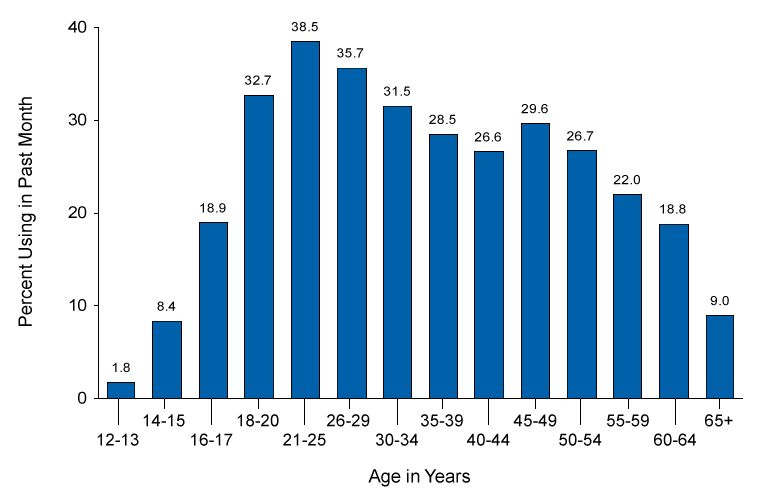
Gender
- In 2007, current use
of a tobacco product among persons aged 12 or older was reported by a higher
percentage of males (35.2 percent) than females (22.4 percent).
Males also had higher rates of past month use than females of each specific
tobacco product: cigarette smoking (27.1 percent of males vs. 21.5 percent
of females), cigar smoking (9.1 vs. 1.8 percent), use of smokeless
tobacco (6.3 vs. 0.4 percent), and use of pipe tobacco (1.5 vs. 0.2 percent).
- Among youths aged 12
to 17, the rate of current cigarette smoking in 2007 did not differ significantly
for males (10.0 percent) and females (9.7 percent). The rate declined
for females between 2006 and 2007 (10.7 vs. 9.7 percent), but remained
unchanged for males (10.0 percent in each year). From 2002 to 2007,
the rate of current cigarette smoking among youths decreased for both males
(from 12.3 to 10.0 percent) and females (from 13.6 to 9.7 percent)
(Figure 4.4).
Below is a line graph.
Click here for the text describing this graph.
Figure 4.4 Past Month
Cigarette Use among Youths Aged 12 to 17, by Gender: 2002-2007
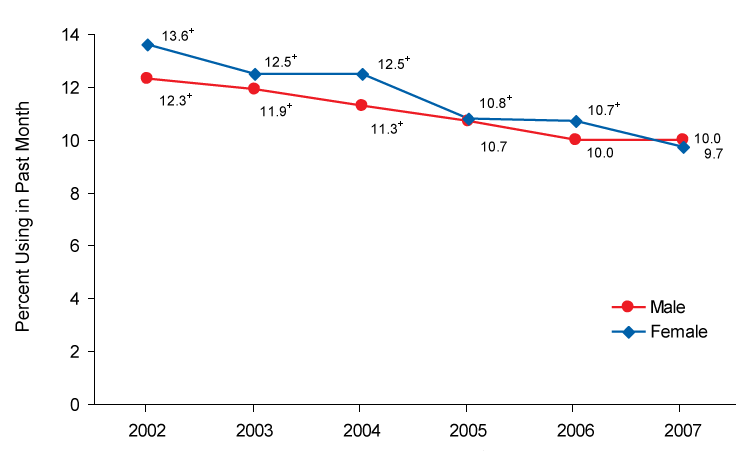
+
Difference between this estimate and the 2007 estimate is statistically significant
at the .05 level.
- Among female young
adults aged 18 to 25, current cigarette smoking decreased from 34.9 percent
in 2006 to 31.8 percent in 2007. Between 2002 and 2007, the rate of
cigarette use among young adults declined for both males (from 44.4 to 40.5 percent)
and females (from 37.1 to 31.8 percent). Among male young adults, however,
there was an increase in the rate of current cigar smoking over that period
(from 16.8 percent in 2002 to 18.4 percent in 2007).
Pregnant Women
- Among women aged 15
to 44, combined data for 2006 and 2007 indicated that the rate of past month
cigarette use was lower among those who were pregnant (16.4 percent)
than it was among those who were not pregnant (28.4 percent). This
pattern was evident among women aged 18 to 25 (23.3 vs. 33.9 percent
for pregnant and nonpregnant women, respectively) and among women aged 26
to 44 (11.6 vs. 28.3 percent, respectively). However, among those aged
15 to 17, the rate of cigarette smoking for pregnant women was higher than
for nonpregnant women (24.3 vs. 16.0 percent). A similar pattern in
cigarette smoking was observed in the combined 2004-2005 data, although
the difference among those aged 15 to 17 was not statistically significant
in the data for those years.
- Two-year moving
average rates from 2002-2003 to 2006-2007 indicate that current
cigarette use among women aged 15 to 44 decreased from 30.7 to 28.4 percent
for those who were not pregnant and from 18.0 to 16.4 percent for those
who were pregnant, although the latter difference was not statistically
significant (Figure 4.5).
Below is a line graph.
Click here for the text describing this graph.
Figure 4.5 Past Month
Cigarette Use among Women Aged 15 to 44, by Pregnancy Status: Combined Years
2002-2003 to 2006-2007

+
Difference between this estimate and the 2006-2007 estimate is statistically
significant at the .05 level.
Race/Ethnicity
- In 2007, the prevalence
of current use of a tobacco product among persons aged 12 or older was 15.4 percent
for Asians, 22.7 percent for Hispanics, 26.8 percent for blacks,
30.7 percent for whites, 35.2 percent for persons who reported
two or more races, and 41.8 percent for American Indians or Alaska
Natives. There were no statistically significant changes in past month use
of a tobacco product between 2006 and 2007 for any of these racial/ethnic
groups. Among the specific tobacco products, smokeless tobacco use in the
past month among blacks decreased from 1.7 percent in 2006 to 0.7 percent
in 2007.
- In 2007, current cigarette
smoking among youths aged 12 to 17 and young adults aged 18 to 25 was more
prevalent among whites than blacks (12.2 vs. 6.1 percent for youths
and 40.8 vs. 26.2 percent for young adults). Among adults aged 26 or
older, however, whites and blacks used cigarettes at about the same rate
(24.8 and 25.7 percent, respectively). The rates for Hispanics were
6.7 percent among youths, 29.5 percent among young adults, and
21.0 percent among those aged 26 or older.
- From 2006 to 2007,
current cigarette use among whites aged 18 to 25 decreased from 44.4 to
40.8 percent, and current use of smokeless tobacco among blacks aged
26 or older decreased from 2.2 to 0.8 percent.
Education
- Cigarette smoking in
the past month was less prevalent among adults who were college graduates
compared with those with less education. Among adults aged 18 or older,
current cigarette use in 2007 was reported by 32.9 percent of those
who had not completed high school, 31.9 percent of high school graduates
who did not attend college, 26.8 percent of persons with some college,
and 14.0 percent of college graduates (Figure 4.6).
Past month cigarette smoking among adults who had not completed high school
decreased from 35.6 percent in 2006 to 32.9 percent in 2007.
- In 2007, the use of
smokeless tobacco in the past month was reported by 3.5 percent of
persons aged 18 or older who had not completed high school, 4.4 percent
of those who completed high school but did not attend college, and 3.3 percent
of those who attended some college. The prevalence among college graduates,
2.1 percent, was lower than among the other groups.
Below is a bar graph.
Click here for the text describing this graph.
Figure 4.6 Past Month
Tobacco Use among Adults Aged 18 or Older, by Education: 2007
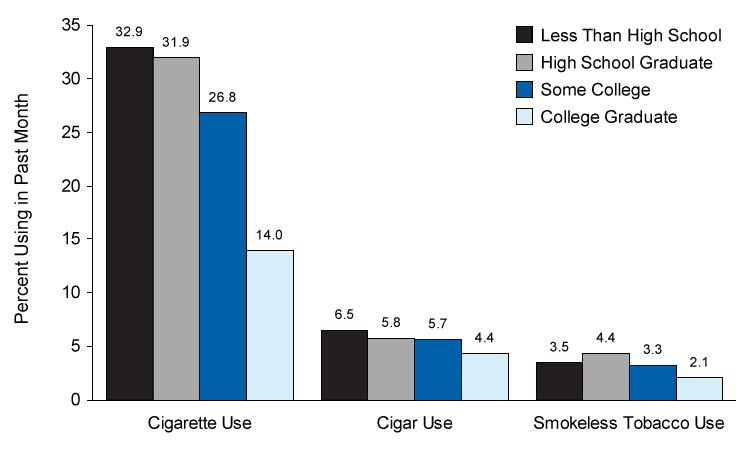
College Students
- Among young adults
18 to 22 years old, full-time college students were less likely to
be current cigarette smokers than their peers who were not enrolled full
time in college. Cigarette use in the past month in 2007 was reported by
25.6 percent of full-time college students, less than the rate
of 41.2 percent for those not enrolled full time.
- Among males aged 18
to 22 in 2007, full-time college students and those not enrolled full
time in college did not differ significantly in their rates of past month
cigar smoking (19.1 and 21.7 percent, respectively) or past month smokeless
tobacco use (9.8 and 10.7 percent). A similar pattern was seen among females
aged 18 to 22.
Employment
- In 2007, current cigarette
smoking was more common among unemployed adults aged 18 or older than among
adults who were working full time or part time (44.6 vs. 27.6 and 24.5 percent,
respectively). Cigar smoking followed a similar pattern, with 11.2 percent
of unemployed adults reporting past month use compared with 6.4 percent
of full-time workers and 5.3 percent of part-time workers.
- Current use of smokeless
tobacco in 2007 was higher among adults aged 18 or older who were employed
full time (4.4 percent) and those who were unemployed (4.9 percent)
than among adults who were employed part time (2.0 percent) and those
in the "other" employment category, which includes persons not
in the labor force (1.9 percent).
Geographic Area
- In 2007, current cigarette
smoking among persons aged 12 or older was lowest in the West (21.1 percent)
and Northeast (22.1 percent), higher in the South (25.5 percent),
and highest in the Midwest (27.2 percent). Use of smokeless tobacco
was higher in the Midwest and South (4.0 and 3.8 percent, respectively)
than in the West (2.8 percent); the lowest rate was in the Northeast
(1.8 percent).
- Among persons aged
12 or older, the rate of current cigarette use was associated with county
type in 2007. The rates of cigarette smoking were 22.7 percent in large
metropolitan areas, 24.8 percent in small metropolitan areas, 28.0 percent
in urbanized nonmetropolitan areas, and 29.5 percent in less urbanized nonmetropolitan
areas. In completely rural counties, 23.6 percent of persons aged 12
or older were current cigarette smokers in 2007, which is lower than the
rate in 2006 (30.1 percent) and similar to the rate in 2005 (23.3 percent).
- Use of smokeless tobacco
in the past month in 2007 among persons aged 12 or older was lowest in large
metropolitan areas (2.0 percent). In small metropolitan areas, the
rate was 3.5 percent; in nonmetropolitan areas, it was 6.7 percent;
and in completely rural nonmetropolitan counties, the rate was 7.0 percent.
Association with Illicit
Drug and Alcohol Use
- Use of illicit drugs
and alcohol was more common among current cigarette smokers than among nonsmokers
in 2007, as in 2002 through 2006. Among persons aged 12 or older, 20.1 percent
of past month cigarette smokers reported current use of an illicit drug
compared with 4.1 percent of persons who were not current cigarette
smokers. Past month alcohol use was reported by 66.9 percent of current
cigarette smokers compared with 46.1 percent of those who did not use cigarettes
in the past month. The association also was found with binge drinking (45.0 percent
of current cigarette users vs. 16.4 percent of current nonusers) and
heavy drinking (16.4 vs. 3.8 percent, respectively).
Frequency of Cigarette
Use
- Among the 60.1 million
current cigarette smokers aged 12 or older in 2007, 36.8 million (61.3 percent)
used cigarettes daily. The percentage of daily cigarette smokers increased
with age, with 26.3 percent among past month cigarette users aged 12
to 17, 49.3 percent among those aged 18 to 25, and 66.3 percent
among those aged 26 or older. In addition, over half (50.9 percent)
of daily smokers aged 12 or older reported smoking 16 or more cigarettes
per day; this is approximately one pack or more. The percentage of daily
smokers who used a pack of cigarettes or more per day was steadily higher
with age from 18.5 percent among those aged 12 to 17 to 33.1 percent
among those aged 18 to 25 to 55.0 percent among those aged 26 or older.
5. Initiation
of Substance Use
Information on substance
use initiation, also known as incidence or first-time use, is important
for policymakers and researchers. Measures of initiation are often leading
indicators of emerging patterns of substance use. They provide valuable information
that can be used in the assessment of the effectiveness of current prevention
programs and in focusing prevention efforts.
With its large sample
size and oversampling of youths aged 12 to 17 and young adults aged 18 to
25, the National Survey on Drug Use and Health (NSDUH) provides a variety
of estimates related to substance use initiation based on questions on age,
year, and month at first use. Using this information, along with the interview
date and the respondent's date of birth, a date of first use is determined
for each substance used by a respondent. Estimates of the number of initiates,
rates of initiation, and average age at first use can be constructed for specific
time periods.
Because of concerns about
the validity of trend estimates of incidence based on long recall periods
(Gfroerer, Hughes, Chromy, Heller, & Packer, 2004), this report only presents
estimates of initiation occurring in the 12 months prior to the interview
date. Individuals who initiated use within the past 12 months are defined
as recent or past year initiates. Estimates for each year are produced independently
based on the data from the survey conducted that year. One caveat of this
approach is that because the survey interviews persons aged 12 or older and
asks about the past 12 months, the initiation estimates will represent some,
but not all of initiation at age 11, and no initiation occurring at age 10
or younger. This underestimation problem primarily affects estimates of initiation
for cigarettes, alcohol, and inhalants because they tend to be initiated at
a younger age than other substances. See Section B.4.1
in Appendix B for further discussion
of the methods and bias in initiation estimates.
There are some important
issues that readers need to be aware of when interpreting these NSDUH incidence
estimates. First, note that some tables and analyses are based on the ages
of initiates at the time of interview, while others focus on the age at the
time of first substance use. This can have a large impact on estimates, so
readers should pay close attention to the approach used in each situation.
Titles and notes on tables document which method applies. Regarding the age
at first use estimates, means, as measures of central tendency, are heavily
influenced by the presence of extreme values in the data. Thus, for the purposes
of this report and unless specified otherwise, the mean age at initiation
pertains to persons aged 12 to 49. This constraint was implemented so that
the mean age estimates reported would not be influenced by those few respondents
who were past year initiates at age 50 or older. Note that this constraint
only affects estimates of mean age at initiation; other estimates in this
chapter, including the number and prevalence of past year initiates, are among
all persons aged 12 or older.
An important consideration
in looking at incidence estimates across different drug categories is that
substance users typically initiate use of different substances at different
times in their lives. Thus, the estimates for specific illicit drugs cannot
be added to obtain the number of illicit drug initiates, because, for example,
most of the cocaine initiates had previously used marijuana or other drugs
and therefore would be represented in the illicit drug initiate estimates
for a prior year. Similarly, the estimates of crack initiation are not a subset
of the estimates of cocaine initiation, as some persons would have used powder
cocaine prior to using crack. To help clarify this aspect of the incidence
data, additional tables have been generated to identify which specific illicit
drug was used at the time of first use of any illicit drug. These new estimates
are discussed below in the first section of this chapter.
The prevalence estimates
for nonmedical use of psychotherapeutic drugs, stimulants, and methamphetamine
discussed in Chapter 2 take account
of data from new items on methamphetamine use that were added to the noncore
section of the survey in 2005 and 2006 to capture information on methamphetamine
users who failed to recognize the drug when it was presented in the context
of prescription drugs in the core stimulants module. The drug use initiation
estimates in this chapter, however, are based on data only from the core section
of the questionnaire and do not take account of data from new items on the
initiation of methamphetamine use that were added to the noncore section in
2007 following up on the additional methamphetamine users identified in the
questions introduced in 2005 and 2006. See Section B.4.6
in Appendix B of this report
for details.
Initiation of Illicit
Drug Use
- In 2007, an estimated
2.7 million persons aged 12 or older used an illicit drug for the first
time within the past 12 months; this averages to more than 7,000 initiates
per day. This estimate was not significantly different from the number in
2006 (2.8 million). Three fifths of initiates (60.1 percent) were younger
than age 18 when they first used, and 54.1 percent of new users were
female. The average age at initiation among persons aged 12 to 49 was 18.0
years.
- In 2007, of the 2.7
million persons aged 12 or older who used illicit drugs for the first time
within the past 12 months, a majority reported that their first drug was
marijuana (56.2 percent) (Figure 5.1).
Nearly one third initiated with psychotherapeutics (30.6 percent, including
19.0 percent with pain relievers, 6.5 percent with tranquilizers,
4.1 percent with stimulants, and 1.1 percent with sedatives). A sizable
proportion reported inhalants (10.7 percent) as their first drug, and
a small proportion used hallucinogens as their first illicit drug (2.0 percent).
The percentage of past year illicit drug initiates whose first drug was
tranquilizers increased from 2.4 percent in 2002 to 6.5 percent in
2007, while the percentage whose first drug was Ecstasy decreased from 1.9 percent
in 2002 to 0.6 percent in 2007.
Below is a pie chart.
Click here for the text describing this chart.
Figure 5.1 Specific Drug
Used When Initiating Illicit Drug Use among Past Year Initiates of Illicit
Drugs Aged 12 or Older: 2007
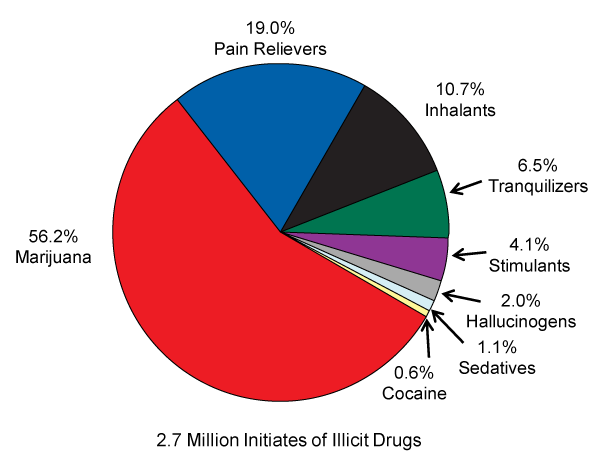
Note:
The percentages add to greater than 100 percent because of a small number
of respondents initiating multiple drugs on the same day.
Comparison, by Drug
- The specific drug categories
with the largest number of recent initiates among persons aged 12 or older
were nonmedical use of pain relievers (2.1 million) and marijuana use (2.1
million), followed by nonmedical use of tranquilizers (1.2 million), cocaine
(0.9 million), Ecstasy (0.8 million), inhalants (0.8 million), and stimulants
(0.6 million) (Figure 5.2).
- Among persons aged
12 to 49, the average age at first use of inhalants in 2007 was 17.1 years;
it was 17.6 years for marijuana, 20.2 years for cocaine, 20.2 years for
Ecstasy, 21.2 years for pain relievers, and 24.5 years for tranquilizers
(Figure 5.3).
Below is a bar graph.
Click here for the text describing this graph.
Figure 5.2 Past Year
Initiates for Specific Illicit Drugs among Persons Aged 12 or Older: 2007
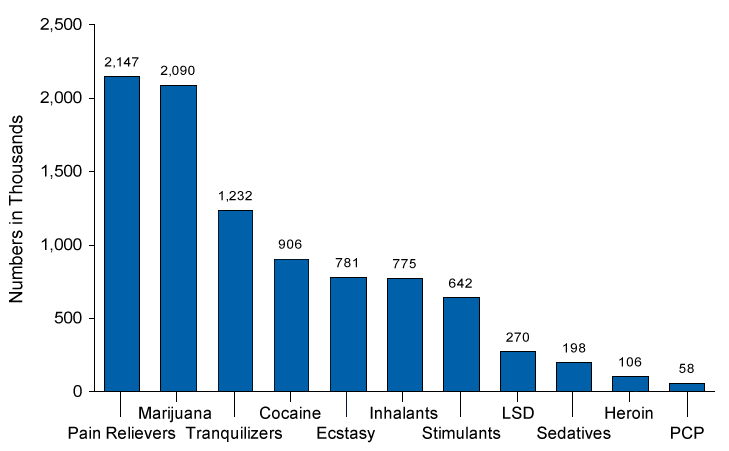
Below is a bar graph.
Click here for the text describing this graph.
Figure 5.3 Mean Age at
First Use for Specific Illicit Drugs among Past Year Initiates Aged 12 to
49: 2007
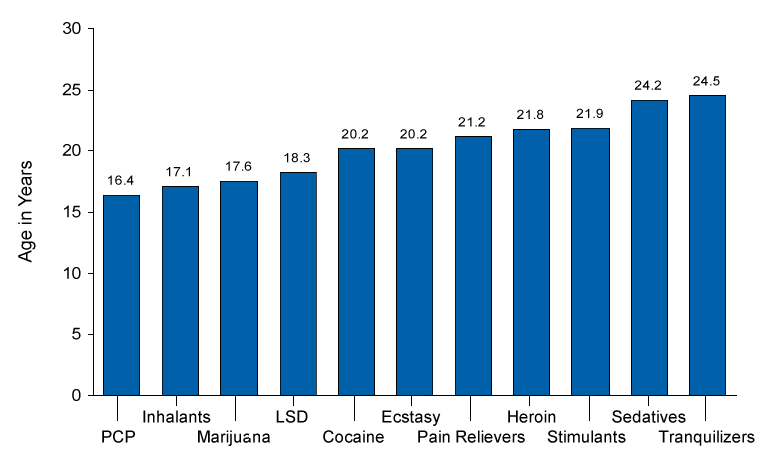
Marijuana
- In 2007, there were
2.1 million persons who had used marijuana for the first time within the
past 12 months; this averages to approximately 6,000 initiates per day.
This estimate of past year initiates in 2007 was about the same as the number
in 2006 (2.1 million), 2005 (2.1 million), 2004 (2.1 million), 2003 (2.0
million), and 2002 (2.2 million) (Figure 5.4).
Below are two bar graphs.
Click here for the text describing these graphs.
Figure 5.4 Past Year
Marijuana Initiates among Persons Aged 12 or Older and Mean Age at First Use
of Marijuana among Past Year Marijuana Initiates Aged 12 to 49: 2002-2007
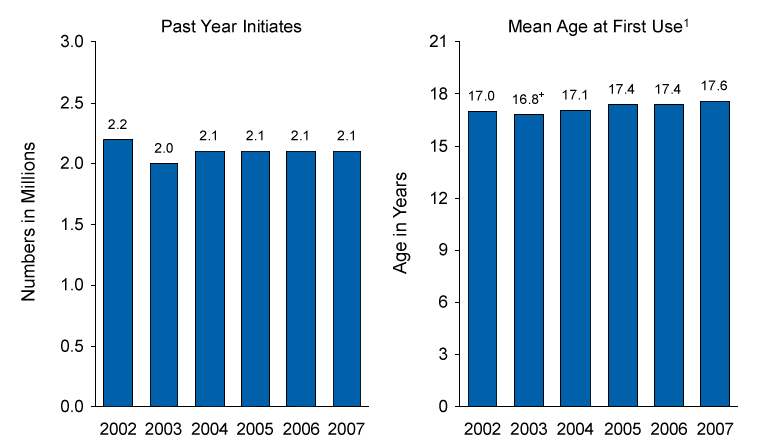
+
Difference between this estimate and the 2007 estimate is statistically significant
at the .05 level.
1 Mean-age-at-first-use estimates are for recent
initiates aged 12 to 49.
- Most (62.2 percent)
of the 2.1 million recent marijuana initiates were younger than age 18 when
they first used. Among youths aged 12 to 17, an estimated 4.6 percent
had used marijuana for the first time within the past year, similar to the
rate in 2006 (4.7 percent).
- As a percentage of
those aged 12 to 17 who had not used marijuana prior to the past year, the
youth marijuana initiation rate in 2007 (5.2 percent) was similar to
the rate in 2006 (5.4 percent).
- In 2007, the average
age at first marijuana use among recent initiates aged 12 to 49 was 17.6
years, which was similar to the average in 2006 (17.4 years) (Figure 5.4).
Among recent initiates aged 12 or older who initiated use prior to the age
of 21, the mean age at first use was 16.2 years in 2007, which was not significantly
different from the estimate (16.1 years) in 2006.
Cocaine
- In 2007, there were
906,000 persons aged 12 or older who had used cocaine for the first time
within the past 12 months; this averages to approximately 2,500 initiates
per day. This estimate was not significantly different from the number in
2006 (977,000).
- Most (66.5 percent)
of the 0.9 million recent cocaine initiates were 18 or older when they first
used. The average age at first use among recent initiates aged 12 to 49
was 20.2 years, which was similar to the average age in 2006 (20.3 years).
Heroin
- In 2007, there were
106,000 persons aged 12 or older who had used heroin for the first time
within the past 12 months. The average age at first use among recent initiates
aged 12 to 49 was 21.8 years in 2007. There were no significant changes
in the number of initiates or in the average age at first use from 2006
to 2007.
Hallucinogens
- In 2007, there were
1.1 million persons aged 12 or older who had used hallucinogens for the
first time within the past 12 months. This estimate was not significantly
different from the estimate in 2002, 2004, 2005, and 2006. However, the
estimate was significantly higher than the estimate in 2003 (886,000).
- There was no significant
change between 2006 and 2007 in the number of past year initiates of LSD
(264,000 and 270,000, respectively).
- There was no significant
change in the past year initiates of Ecstasy between 2006 (860,000) and
2007 (781,000). The number of past year Ecstasy initiates in 2007, however,
was significantly lower than the estimate in 2002 (1.2 million), but higher
than the estimate in 2003 (642,000), 2004 (607,000), and 2005 (615,000)
(Figure 5.5). Most (61.2 percent)
of the recent Ecstasy initiates in 2007 were aged 18 or older at the time
they first used Ecstasy. The corresponding figure was 70.1 percent
in 2006. Among past year initiates aged 12 to 49, the average age at initiation
of Ecstasy in 2007 was 20.2 years, similar to the average age in 2006 (20.6
years).
Below are two bar graphs.
Click here for the text describing these graphs.
Figure 5.5 Past Year
Ecstasy Initiates among Persons Aged 12 or Older and Mean Age at First Use
of Ecstasy among Past Year Ecstasy Initiates Aged 12 to 49: 2002-2007
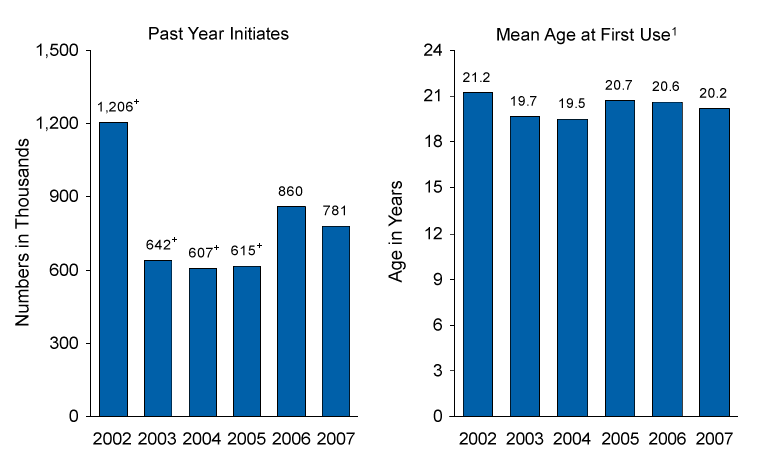
+
Difference between this estimate and the 2007 estimate is statistically significant
at the .05 level.
1 Mean-age-at-first-use estimates are for recent
initiates aged 12 to 49.
Inhalants
- In 2007, there were
775,000 persons aged 12 or older who had used inhalants for the first time
within the past 12 months; 66.3 percent were under age 18 when they
first used. There was no significant difference in the number of inhalant
initiates between 2006 and 2007. However, there was a significant increase
in the average age at first use among recent initiates aged 12 to 49 from
2006 (15.7 years) to 2007 (17.1 years).
Psychotherapeutics
- Psychotherapeutics
include the nonmedical use of any prescription-type pain relievers,
tranquilizers, stimulants, or sedatives. Over-the-counter substances
are not included. In 2007, there were 2.5 million persons aged 12 or older
who used psychotherapeutics nonmedically for the first time within the past
year, which averages out to around 7,000 initiates per day. The numbers
of new users of specific classes of psychotherapeutics in 2007 were 2.1
million for pain relievers, 1.2 million for tranquilizers, 642,000 for stimulants,
and 198,000 for sedatives. There was a significant decrease in the number
of past year initiates of stimulants from 2006 (845,000) to 2007 (642,000),
but there were no significant changes in the estimates for the remaining
psychotherapeutics between these years. The estimated number of past year
initiates of nonmedical pain reliever use declined from 2.5 million in 2003
to 2.1 million in 2007.
- The average age at
first nonmedical use of any psychotherapeutics among recent initiates aged
12 to 49 was 21.8 years. More specifically, it was 21.2 years for pain relievers,
21.9 years for stimulants, 24.5 years for tranquilizers, and 24.2 years
for sedatives.
- In 2007, the number
of new nonmedical users of OxyContin® aged 12 or older was
554,000, with an average age at first use of 24.0 years among those aged
12 to 49. These estimates are similar to those for 2006 (533,000 and 22.6
years, respectively).
- The number of recent
new users of methamphetamine among persons aged 12 or older was 157,000
in 2007 (Figure 5.6). This estimate
was significantly lower than the estimate in 2002 (299,000), 2003 (260,000),
2004 (318,000), and 2006 (259,000). The average age of new methamphetamine
users aged 12 to 49 in 2007 was 19.1 years, not significantly different
from the average ages in 2002 through 2006.
Below are two bar graphs.
Click here for the text describing these graphs.
Figure 5.6 Past Year
Methamphetamine Initiates among Persons Aged 12 or Older and Mean Age at First
Use of Methamphetamine among Past Year Methamphetamine Initiates Aged 12 to
49: 2002-2007
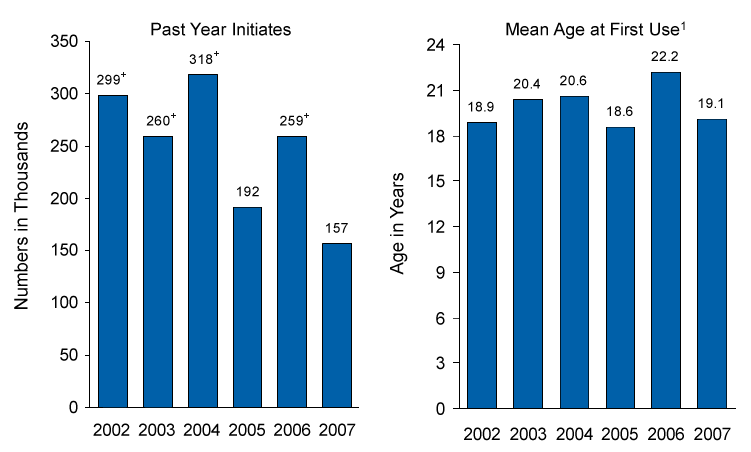
+
Difference between this estimate and the 2007 estimate is statistically significant
at the .05 level.
1 Mean-age-at-first-use estimates are for recent
initiates aged 12 to 49.
Alcohol
- In 2007, there were
4.6 million persons aged 12 or older who had used alcohol for the first
time within the past 12 months; this averages to approximately 12,500 initiates
per day. The number of past year alcohol initiates in 2007 was significantly
greater than the estimate in 2002 (3.9 million) and 2003 (4.1 million),
but similar to the numbers in 2004 (4.4 million), 2005 (4.3 million), and
2006 (4.4 million).
- Most (85.9 percent)
of the 4.6 million recent alcohol initiates were younger than age 21 at
the time of initiation.
- In 2007, the average
age at first alcohol use among recent initiates aged 12 to 49 was 16.8 years,
similar to the corresponding 2006 estimate (16.6 years). The mean age at
first use among recent initiates aged 12 or older who initiated use prior
to the age of 21 was 15.8 years, which was the same as the 2006 estimate.
Tobacco
- The number of persons
aged 12 or older who smoked cigarettes for the first time within the past
12 months was 2.2 million in 2007, which was significantly lower than the
estimate in 2006 (2.4 million) but significantly higher than the estimate
for 2002 (1.9 million) and 2003 (2.0 million) (Figure 5.7).
The 2007 estimate averages out to approximately 6,100 new cigarette smokers
every day. Most new smokers in 2007 were under age 18 when they first smoked
cigarettes (59.7 percent).
Below is a bar graph.
Click here for the text describing this graph.
Figure 5.7 Past Year
Cigarette Initiates among Persons Aged 12 or Older, by Age at First Use: 2002-2007
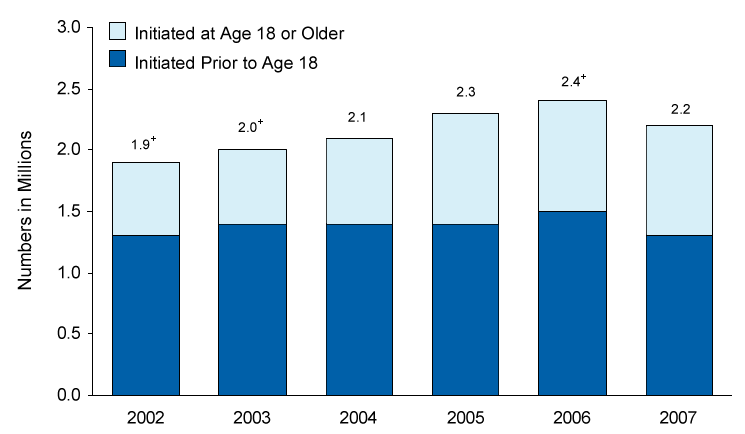
+
Difference between this estimate and the 2007 estimate is statistically significant
at the .05 level.
- In 2007, among recent
initiates aged 12 to 49, the average age of first cigarette use was 16.9
years, similar to the average in 2006 (17.1 years).
- Of those aged 12 or
older who had not smoked cigarettes prior to the past year, the past year
initiation rate for cigarettes was 2.5 percent in 2007, significantly lower
than the rate in 2006 (2.9 percent). Among youths aged 12 to 17 years
who had not smoked cigarettes prior to the past year, incidence showed a
significant decrease between 2006 (6.6 percent) and 2007 (5.9 percent).
Among males aged 12 to 17, the decrease in the past year initiation rate
from 6.1 percent in 2002 to 5.7 percent in 2007 was not statistically
significant, but among females, the decrease from 7.4 percent in 2002 to
6.0 percent in 2007 was statistically significant (Figure 5.8).
Below is a line graph.
Click here for the text describing this graph.
Figure 5.8 Past Year
Cigarette Initiation among Youths Aged 12 to 17 Who Had Never Smoked, by Gender:
2002-2007
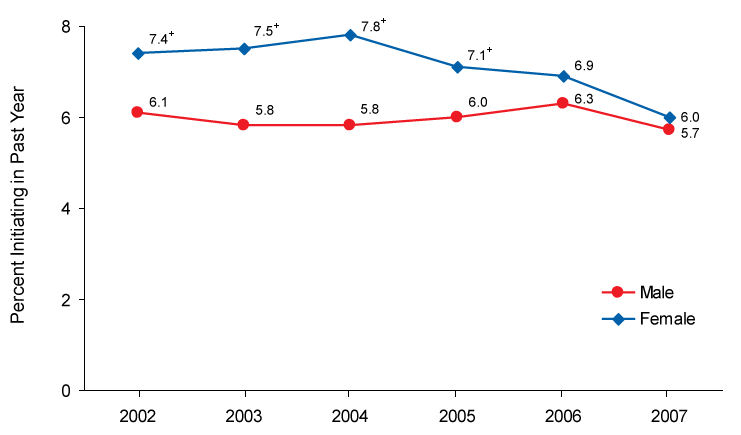
+
Difference between this estimate and the 2007 estimate is statistically significant
at the .05 level.
- In 2007, the number
of persons who had started smoking cigarettes daily within the past 12 months
was 1.0 million. This estimate is similar to the estimates for 2002 (1.0
million), 2003 (1.1 million), 2004 (1.1 million), 2005 (1.0 million), and
2006 (1.1 million). Of these new daily smokers in 2007, 40.7 percent,
or 400,000, were younger than age 18 when they started smoking daily. This
figure averages to approximately 1,100 initiates of daily smoking under
age 18 every day.
- The average age of
first daily smoking among new daily smokers aged 12 to 49 in 2007 was 19.2
years. This was not significantly different from the average in 2006 (18.9
years).
- In 2007, there were
3.1 million persons aged 12 or older who had used cigars for the first time
in the past 12 months, the same as the number in 2006. However, this estimate
reflects a significant increase in the number of initiates from 2003 (2.7
million). Among past year cigar initiates aged 12 to 49, the average age
at first use was 20.5 years in 2007, which was not significantly different
from the estimate in 2006 (19.9 years).
- The number of persons
aged 12 or older initiating use of smokeless tobacco in the past year was
1.3 million in 2007, which was the same as the estimate in 2006 and not
significantly different from the estimate in 2005 (1.1 million). However,
the estimated number of past year initiates of smokeless tobacco use in
2007 was at least 30 percent higher than the estimate in 2002 (951,000),
2003 (928,000), and 2004 (999,000). About three quarters (74.2 percent)
of new initiates in 2007 were male, and a little more than half (52.5 percent)
were under age 18 when they first used.
- The average age at
first smokeless tobacco use among recent initiates aged 12 to 49 in 2007
was 18.0 years. Averages were 17.4 years for males and 19.7 years for females.
6. Youth
Prevention-Related Measures
The National Survey on
Drug Use and Health (NSDUH) includes questions for youths aged 12 to 17 about
a number of risk and protective factors that may affect the likelihood that
they will engage in substance use. Risk factors are individual characteristics
and environmental influences associated with an increased vulnerability to
the initiation, continuation, or escalation of substance use. Protective factors
include individual resilience and other circumstances that appear to reduce
the likelihood of substance use. Risk and protective factors include variables
that operate at different stages of development and reflect different domains
of influence, including the individual, family, peer, school, community, and
societal levels (Hawkins, Catalano, & Miller, 1992). Interventions to
prevent substance use generally are designed to ameliorate the influence of
risk factors and enhance the effectiveness of protective factors.
This chapter presents
findings for youth prevention-related measures collected in the 2007
NSDUH and compares these with findings from previous years. Included are measures
of perceived risk from substance use (cigarettes, alcohol, and illicit drugs),
perceived availability of substances, perceived parental disapproval of substance
use, feelings about peer substance use, involvement in fighting and delinquent
behavior, participation in religious and other activities, exposure to substance
use prevention messages and programs, and parental involvement.
In this chapter, rates
of substance use are compared for persons responding differently to questions
reflecting risk or protective factors, such as the perceived risk of harm
from using a substance. Because the NSDUH data for an individual are collected
at only one point in time, it is not possible to determine causal connections
from these data. However, a number of research studies of youths have shown
that reducing risk factors and increasing protective factors can reduce rates
of substance use (Botvin, Botvin, & Ruchlin, 1998). This report shows
that marijuana use, cigarette use, and alcohol use among youths aged 12 to
17 decreased between 2002 and 2007, yet corresponding changes in individual
risk and protective factors for the same period may or may not have occurred.
There can be many reasons for this, such as the lack of or a weak causal connection,
a lagged relationship between the occurrence of a risk factor and the change
in drug use behavior, or that individual use is typically the result of multiple
simultaneous risk factors rather than a single factor (Newcomb, Maddahian,
& Bentler, 1986).
Perceptions of Risk
One factor that can influence
whether youths will use tobacco, alcohol, or illicit drugs is the extent to
which youths believe these substances might cause them harm. NSDUH respondents
were asked how much they thought people risk harming themselves physically
and in other ways when they use various substances in certain amounts or frequencies.
Response choices for these items were "great risk," "moderate
risk," "slight risk," or "no risk."
- The percentages of
youths reporting binge alcohol use and use of cigarettes and marijuana in
the past month were lower among those who perceived great risk in using
these substances than among those who did not perceive great risk. For example,
in 2007, 5.0 percent of youths aged 12 to 17 who perceived great risk
from "having 5 or more drinks of an alcoholic beverage once or twice
a week" reported binge drinking in the past month (consumption of five
or more drinks of an alcoholic beverage on a single occasion on at least
1 day in the past 30 days); by contrast, past month binge drinking was reported
by 12.9 percent of youths who saw moderate, slight, or no risk from
having five or more drinks of an alcoholic beverage once or twice a week
(Figure 6.1). Past month marijuana
use was reported by 1.4 percent of youths who saw great risk in smoking
marijuana once a month compared with 9.5 percent of youths who saw
moderate, slight, or no risk.
Below is a bar graph.
Click here for the text describing this graph.
Figure 6.1 Past Month
Binge Drinking and Marijuana Use among Youths Aged 12 to 17, by Perceptions
of Risk: 2007
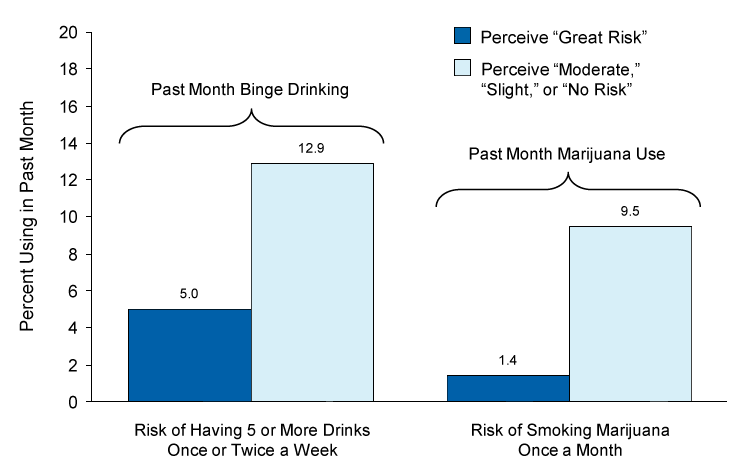
- Increases in the perceived
risk of using a substance often are associated with decreases in the rate
of current use of that substance. Looking over the 6-year period, the
proportion of youths aged 12 to 17 who reported perceiving great risk from
smoking one or more packs of cigarettes per day increased from 63.1 percent
in 2002 to 68.8 percent in 2007 (Figure 6.2).
The rate of past month cigarette smoking among youths aged 12 to 17 dropped
from 13.0 to 9.8 percent during the same period. Percentages for both
perceived risk of smoking one or more packs of cigarettes per day and smoking
in the past month were similar in 2006 and 2007.
Below is a line graph.
Click here for the text describing this graph.
Figure 6.2 Perceived
Great Risk of Cigarette and Alcohol Use among Youths Aged 12 to 17: 2002-2007
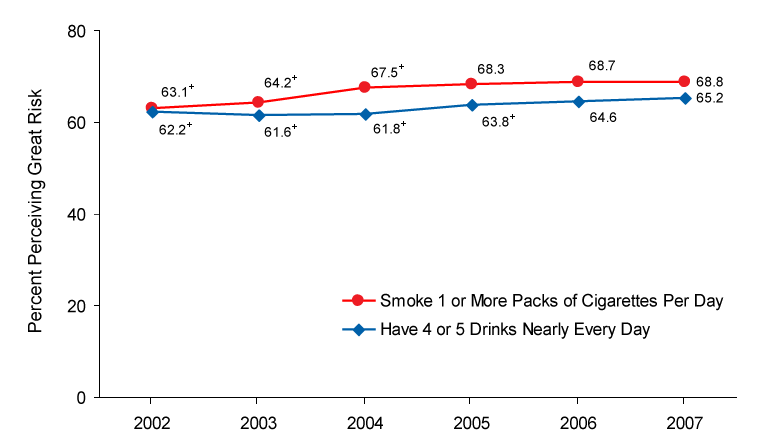
+
Difference between this estimate and the 2007 estimate is statistically significant
at the .05 level.
- The percentage of youths
aged 12 to 17 indicating great risk in having four or five drinks nearly
every day increased from 62.2 percent in 2002 to 65.2 percent
in 2007, but the percentage remained unchanged between 2006 (64.6 percent)
and 2007 (Figure 6.2). The rates
of past month heavy alcohol use among youths aged 12 to 17 were about the
same throughout the period from 2002 to 2007 (e.g., 2.5 percent in
2002, 2.4 percent in 2006, and 2.3 percent in 2007).
- The percentage of youths
aged 12 to 17 perceiving great risk in having five or more drinks of an
alcoholic beverage once or twice a week increased from 38.2 percent
in 2002 to 39.4 percent in 2007, but remained stable between 2006 (39.4 percent)
and 2007. Accordingly, the rate of past month binge alcohol use among youths
decreased from 10.7 percent in 2002 to 9.7 percent in 2007, but
the rate remained stable between 2006 (10.3 percent) and 2007.
- The percentage of youths
aged 12 to 17 indicating great risk in smoking marijuana once a month increased
from 32.4 percent in 2002 to 34.5 percent in 2007 (Figure 6.3).
The percentage of youths aged 12 to 17 perceiving great risk in smoking
marijuana once or twice a week also increased from 51.5 percent in
2002 to 54.7 percent in 2007. Both of these percentages of perceived
great risk of use were similar between 2006 and 2007.
Below is a line graph.
Click here for the text describing this graph.
Figure 6.3 Perceived
Great Risk of Marijuana Use among Youths Aged 12 to 17: 2002-2007
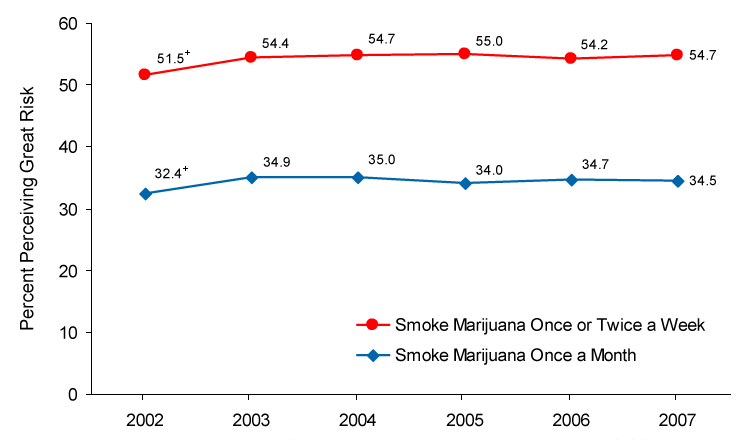
+
Difference between this estimate and the 2007 estimate is statistically significant
at the .05 level.
- Coincident with the
increase in the percentage of youths who perceived great risk of marijuana
use, the prevalence of lifetime, past year, and past month marijuana use
among youths aged 12 to 17 decreased between 2002 and 2007. During the 6-year
period, lifetime use of marijuana dropped from 20.6 to 16.2 percent,
past year use declined from 15.8 to 12.5 percent, and past month use
fell from 8.2 to 6.7 percent. Although lifetime use of marijuana decreased
from 17.3 percent in 2006 to 16.2 percent in 2007, past year and
past month marijuana use rates remained stable during the 2-year period.
- Between 2002 and 2007,
the percentage of youths aged 12 to 17 perceiving great risk declined for
the following substance use patterns: trying heroin once or twice (from
58.5 to 57.0 percent), using heroin once or twice a week (from 82.5
to 81.0 percent), trying LSD once or twice (from 52.6 to 51.2 percent),
and using LSD once or twice a week (from 76.2 to 74.2 percent) (Figure 6.4).
Over the same period, however, the percentage of youths aged 12 to 17 indicating
great risk for using cocaine once a month (50.5 percent in 2002 and
49.6 percent in 2007) and using cocaine once or twice a week (79.8 percent
in 2002 and 78.9 percent in 2007) remained statistically unchanged.
Moreover, percentages for all of these perception of risk measures remained
stable between 2006 and 2007.
Below is a line graph.
Click here for the text describing this graph.
Figure 6.4 Perceived
Great Risk of Use of Selected Illicit Drugs among Youths Aged 12 to 17: 2002-2007
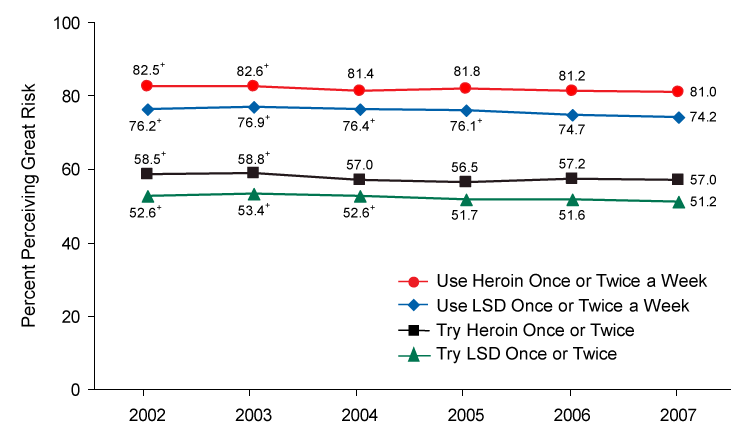
+
Difference between this estimate and the 2007 estimate is statistically significant
at the .05 level.
Perceived Availability
- In 2007, about half
(49.1 percent) of the youths aged 12 to 17 reported that it would be
"fairly easy" or "very easy" for them to obtain marijuana
if they wanted some (Figure 6.5).
One in seven (14.1 percent) indicated that heroin would be "fairly"
or "very" easily available, and 14.4 percent reported so
for LSD. Between 2002 and 2007, there were decreases in the perceived availability
of marijuana (from 55.0 to 49.1 percent), crack (from 26.5 to 25.3 percent),
LSD (from 19.4 to 14.4 percent), and heroin (from 15.8 to 14.1 percent).
The perceived availability of cocaine declined from 25.9 percent in
2006 to 24.5 percent in 2007, but the perceived availability of marijuana,
crack, LSD, and heroin did not change significantly during the 2-year
period.
Below is a line graph.
Click here for the text describing this graph.
Figure 6.5 Perceived
Availability of Selected Illicit Drugs among Youths Aged 12 to 17: 2002-2007
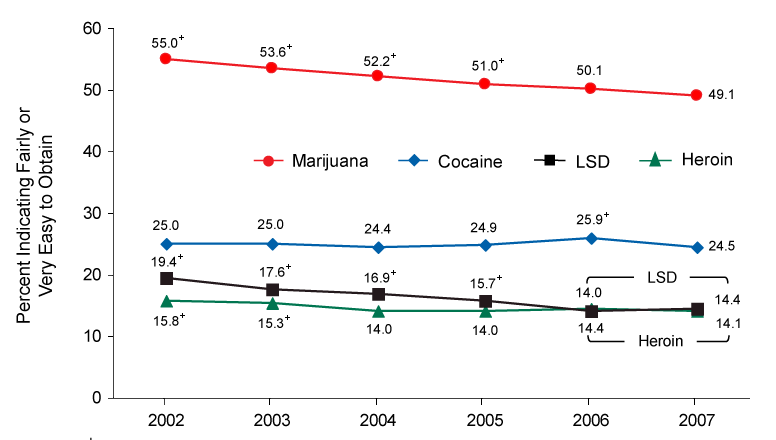
+
Difference between this estimate and the 2007 estimate is statistically significant
at the .05 level.
- The percentage of youths
who reported that illicit drugs would be easy to obtain increased with age
in 2007. For example, 20.6 percent of those aged 12 or 13 said it would
be fairly or very easy to obtain marijuana compared with 50.9 percent
of those aged 14 or 15 and 73.4 percent of those aged 16 or 17.
- In 2007, 14.5 percent
of youths aged 12 to 17 indicated that they had been approached by someone
selling drugs in the past month, which was down from the 16.7 percent
reported in 2002 (Figure 6.6).
The rate remained stable between 2006 (15.3 percent) and 2007.
Below is a bar graph.
Click here for the text describing this graph.
Figure 6.6 Approached
in the Past Month by Someone Selling Drugs among Youths Aged 12 to 17: 2002-2007
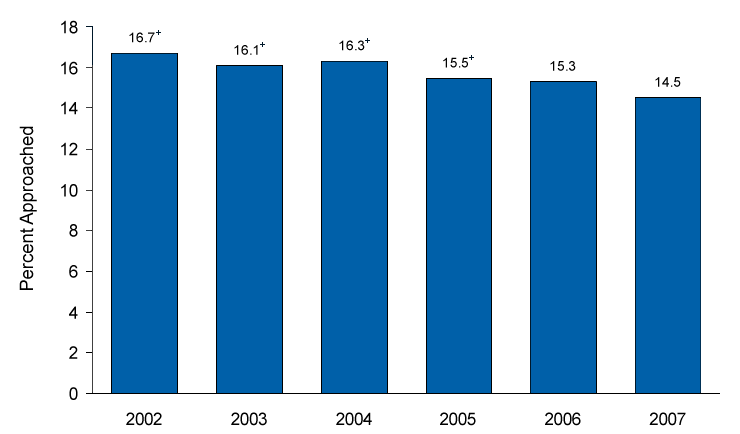
+
Difference between this estimate and the 2007 estimate is statistically significant
at the .05 level.
Perceived Parental Disapproval
of Substance Use
- Most youths aged 12
to 17 believed their parents would "strongly disapprove" of their
using substances. In 2007, 91.0 percent of youths reported that their
parents would strongly disapprove of their trying marijuana or hashish once
or twice; this was similar to the rate in 2006 (90.4 percent), but
was higher than the rate in 2002 (89.1 percent). Most (89.6 percent)
reported that their parents would strongly disapprove of their having one
or two drinks of an alcoholic beverage nearly every day, which was the same
as the rate in 2006 and similar to the 89.0 percent reported in 2002.
In 2007, however, 92.1 percent of youths reported that their parents
would strongly disapprove of their smoking one or more packs of cigarettes
per day, which was higher than the 91.4 percent reported in 2006 and
the 89.5 percent reported in 2002.
- Youths aged 12 to 17
who believed their parents would strongly disapprove of their using substances
in certain amounts or frequencies were less likely to use that substance
than were youths who believed their parents would somewhat disapprove or
neither approve nor disapprove. For example, in 2007, past month cigarette
use was reported by 7.2 percent of youths who perceived strong parental
disapproval of their smoking one or more packs of cigarettes per day compared
with 41.5 percent of youths who believed their parents would not strongly
disapprove. Current marijuana use also was much less prevalent among youths
who perceived strong parental disapproval for trying marijuana or hashish
once or twice than among those who did not (4.6 vs. 28.1 percent, respectively).
Feelings about Peer Substance
Use
- A majority of youths
aged 12 to 17 reported that they disapprove of their peers using substances.
In 2007, 89.7 percent of youths "strongly" or "somewhat"
disapproved of their peers smoking one or more packs of cigarettes per day,
which was similar to the rate of 89.1 percent in 2006, but higher than
the 87.1 percent in 2002. In addition, 82.9 percent strongly or
somewhat disapproved of peers using marijuana or hashish once a month or
more, which was similar to the 82.8 percent reported in 2006, but was
an increase from the 80.4 percent in 2002. Also, 86.6 percent
of youths strongly or somewhat disapproved of peers having one or two drinks
of an alcoholic beverage nearly every day, which was similar to the rate
of 86.4 percent in 2006, but was higher than the 84.7 percent
reported in 2002.
- In 2007, past month
marijuana use was reported by 2.3 percent of youths aged 12 to 17 who
strongly or somewhat disapproved of their peers using marijuana once a month
or more compared with 27.7 percent of youths who reported that they
neither approve nor disapprove of such behavior from their peers.
Fighting and Delinquent
Behavior
- In 2007, 22.3 percent
of youths aged 12 to 17 reported that, in the past year, they had gotten
into a serious fight at school or at work; this was similar to the rate
in 2006 (22.6 percent), but was higher than that in 2002 (20.6 percent).
Almost one in six (15.4 percent) had taken part in a group-against-group
fight, which was lower than the rate in 2006 (17.0 percent), but was
similar to the rate in 2002 (15.9 percent). One in thirty (3.3 percent)
had carried a handgun at least once, which was similar to the rates in 2006
(3.2 percent) and 2002 (3.3 percent). An estimated 2.9 percent
had sold illegal drugs, which was similar to the rate of 3.3 percent
in 2006, but was lower than the 4.4 percent rate in 2002. In 2007,
4.3 percent had, at least once, stolen or tried to steal something
worth more than $50; this was similar to the rate in 2006 (4.8 percent),
but lower than the rate in 2002 (4.9 percent). An estimated 7.3 percent
had, in at least one instance, attacked others with the intent to harm or
seriously hurt them, which was similar to the rates of 7.9 percent
in 2006 and 7.8 percent in 2002.
- Youths aged 12 to 17
who had engaged in fighting or other delinquent behaviors were more likely
than other youths to have used illicit drugs in the past month. For example,
in 2007, past month illicit drug use was reported by 16.5 percent of
youths who had gotten into a serious fight at school or work in the past
year compared with 7.5 percent of those who had not engaged in fighting,
and by 36.6 percent of those who had stolen or tried to steal something
worth over $50 in the past year compared with 8.2 percent of those
who had not engaged in such theft.
Religious Beliefs and
Participation in Activities
- In 2007, 31.4 percent
of youths aged 12 to 17 reported that they had attended religious services
25 or more times in the past year, which was similar to the rate in 2006
(31.7 percent) and the rate in 2002 (33.0 percent). In addition,
76.1 percent agreed or strongly agreed with the statement that religious
beliefs are a very important part of their lives, which was similar to the
77.0 percent reported in 2006, but was lower than the 78.2 percent
reported in 2002. Also, 35.1 percent agreed with the statement that
it is important for their friends to share their religious beliefs, which
was the same as the rate in 2006 and similar to the rate in 2002 (35.8 percent).
- Rates of past month
use of illicit drugs, cigarettes, and alcohol (including binge alcohol)
were lower among youths aged 12 to 17 who agreed with these statements than
among those who disagreed. For example, in 2007, past month illicit drug
use was reported by 7.4 percent of those who agreed that religious
beliefs are a very important part of life compared with 16.3 percent
of those who disagreed with that statement.
Exposure to Substance
Use Prevention Messages and Programs
- In 2007, approximately
one in eight youths aged 12 to 17 (11.3 percent) reported that they
had participated in drug, tobacco, or alcohol prevention programs outside
of school in the past year. This rate was similar to the 11.4 percent
reported in 2006, but was lower than the rates reported in 2002 (12.7 percent)
and 2003 (13.9 percent). The prevalence of past month binge alcohol
use was lower among those who participated in these prevention programs
outside of school (7.9 percent) than among those who did not (9.9 percent).
However, the prevalence of past month use of illicit drugs, marijuana, or
cigarettes was not significantly lower among those who participated in these
prevention programs outside of school (9.4 percent, 6.2 percent, and
9.0 percent, respectively) than among those who did not (9.5 percent,
6.7 percent, and 9.9 percent, respectively).
- In 2007, 77.9 percent
of youths aged 12 to 17 reported having seen or heard drug or alcohol prevention
messages in the past year from sources outside of school, which was lower
than the 79.4 percent reported in 2006 and the 83.2 percent reported
in 2002 (Figure 6.7). The prevalence
of past month use of illicit drugs was lower among those who reported having
such exposure (9.2 percent) than among those who reported having no
such exposure (10.6 percent).
Below is a line graph.
Click here for the text describing this graph.
Figure 6.7 Exposure to
Substance Use Prevention Messages and Programs among Youths Aged 12 to 17:
2002-2007

+
Difference between this estimate and the 2007 estimate is statistically significant
at the .05 level.
1 Estimates are from youths aged 12 to 17 who were enrolled in
school in the past year.
- In 2007, 75.8 percent
of youths aged 12 to 17 enrolled in school in the past year reported having
seen or heard drug or alcohol prevention messages at school, which was lower
than the 76.9 percent reported in 2006 and the 78.8 percent reported
in 2002 (Figure 6.7). The prevalence
of past month use of illicit drugs or marijuana was lower among those who
reported having such exposure (8.7 percent and 6.0 percent for
illicit drugs and marijuana, respectively) than among those who reported
having no such exposure (12.0 percent and 9.1 percent, respectively).
- In 2007, 59.6 percent
of youths aged 12 to 17 reported that they had talked at least once in the
past year with at least one of their parents about the dangers of drug,
tobacco, or alcohol use. This was similar to the 59.8 percent reported
in 2006, but was higher than the 58.1 percent reported in 2002. The prevalence
of past month use of illicit drugs, marijuana, cigarettes, or binge alcohol
among those who reported having had such conversations with their parents
(8.6 percent, 6.2 percent, 9.0 percent, and 9.3 percent,
respectively) was lower than that among those who reported having no such
conversations (10.9 percent, 7.3 percent, 11.0 percent, and
10.4 percent, respectively).
Parental Involvement
- Youths aged 12 to 17
were asked a number of questions related to the extent of support, oversight,
and control that they perceived their parents exercised over them in the
year prior to the survey. In 2007, among youths aged 12 to 17 enrolled in
school in the past year, 79.5 percent reported that in the past year
their parents always or sometimes checked on whether or not they had completed
their homework, which was the same as the rate in 2006 and similar to the
78.4 percent reported in 2002. In addition, 80.9 percent reported
that their parents always or sometimes provided help with their homework,
which was similar to the rates of 79.8 percent in 2006 and 81.4 percent
in 2002. Also, 70.4 percent reported that their parents limited the
amount of time that they spent out with friends on school nights, which
was higher than the 69.1 percent reported in 2006, but was similar
to the 70.7 percent reported in 2002.
- In 2007, 87.8 percent
of youths aged 12 to 17 reported that in the past year their parents made
them always or sometimes do chores around the house, 86.2 percent reported
that their parents always or sometimes let them know that they had done
a good job, and 85.7 percent reported that their parents let them know
they were proud of something they had done. All of these percentages in
2007 were similar to those reported in 2006 and remained statistically unchanged
from the rates reported in 2002. In 2007, however, 39.7 percent of
youths reported that their parents limited the amount of time that they
watched television, which was similar to the rate in 2006 (39.4 percent),
but was higher than the 36.9 percent reported in 2002.
- In 2007, past month
use of illicit drugs, cigarettes, and alcohol (including binge alcohol)
was lower among youths aged 12 to 17 who reported that their parents always
or sometimes engaged in monitoring behaviors than among youths whose parents
"seldom" or "never" engaged in such behaviors. For example,
the rate of past month use of any illicit drug was 8.1 percent for
youths whose parents always or sometimes helped with homework compared with
16.0 percent among youths who indicated that their parents seldom or
never helped. Rates for current cigarette smoking were 8.5 and 16.3 percent
for the two groups of youths, respectively, and rates of past month binge
alcohol use were 7.9 versus 18.3 percent correspondingly.
7. Substance
Dependence, Abuse, and Treatment
The National Survey on
Drug Use and Health (NSDUH) includes a series of questions to assess the prevalence
of substance use disorders (i.e., dependence on or abuse of a substance) in
the past 12 months. Substances include alcohol and illicit drugs, such as
marijuana, cocaine, heroin, hallucinogens, inhalants, and the nonmedical use
of prescription-type psychotherapeutic drugs. These questions are used
to classify persons as dependent on or abusing specific substances based on
criteria specified in the Diagnostic and Statistical Manual of Mental
Disorders, 4th edition (DSM-IV) (American Psychiatric Association
[APA], 1994).
The questions related
to dependence ask about health and emotional problems associated with substance
use, unsuccessful attempts to cut down on use, tolerance, withdrawal, reducing
other activities to use substances, spending a lot of time engaging in activities
related to substance use, or using the substance in greater quantities or
for a longer time than intended. The questions on abuse ask about problems
at work, home, and school; problems with family or friends; physical danger;
and trouble with the law due to substance use. Dependence is considered to
be a more severe substance use problem than abuse because it involves the
psychological and physiological effects of tolerance and withdrawal. Although
individuals may meet the criteria specified here for both dependence and abuse,
persons meeting the criteria for both are classified as having dependence,
but not abuse. Persons defined with abuse in this report do not meet the criteria
for dependence.
This chapter provides
estimates of the prevalence and patterns of substance use disorders occurring
in the past year from the 2007 NSDUH and compares these estimates against
the results from the 2002, 2003, 2004, 2005, and 2006 surveys. It also provides
estimates of the prevalence and patterns of the receipt of treatment in the
past year for problems related to substance use. This chapter concludes with
a discussion of the need for and the receipt of treatment at specialty facilities
for problems associated with substance use.
7.1. Substance Dependence
or Abuse
- In 2007, an estimated
22.3 million persons aged 12 or older were classified with substance dependence
or abuse in the past year (9.0 percent of the population aged 12 or older)
(Figure 7.1). Of these, 3.2
million were classified with dependence on or abuse of both alcohol and
illicit drugs, 3.7 million were dependent on or abused illicit drugs but
not alcohol, and 15.5 million were dependent on or abused alcohol but not
illicit drugs.
Below is a bar graph.
Click here for the text describing this graph.
Figure 7.1 Substance
Dependence or Abuse in the Past Year among Persons Aged 12 or Older: 2002-2007
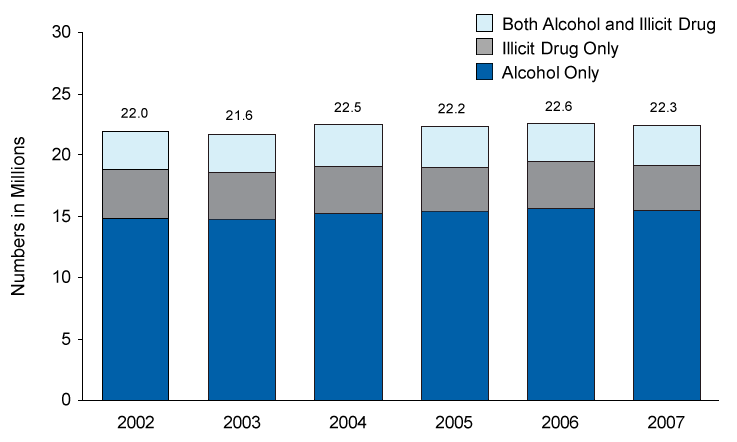
+
Difference between this estimate and the 2007 estimate is statistically significant
at the .05 level.
- The number of persons
with substance dependence or abuse was stable between 2002 and 2007 (22.0
million in 2002, 21.6 million in 2003, 22.5 million in 2004, 22.2 million
in 2005, 22.6 million in 2006, and 22.3 million in 2007).
- In 2007, 18.6 million
persons aged 12 or older were classified with dependence on or abuse of
alcohol. This represents 7.5 percent of the population. The number
and the percentage have remained similar since 2002.
- Marijuana was the illicit
drug that had the highest rate of past year dependence or abuse in 2007,
followed by pain relievers and cocaine. Of the 6.9 million persons aged
12 or older classified with dependence on or abuse of illicit drugs in 2007,
3.9 million were dependent on or abused marijuana or hashish (representing
1.6 percent of the total population aged 12 or older, and 57.4 percent
of all those classified with illicit drug dependence or abuse), 1.7 million
persons were classified with dependence on or abuse of pain relievers, and
1.6 million persons were classified with dependence on or abuse of cocaine
(Figure 7.2). These estimates
for pain relievers and cocaine did not change significantly between 2006
and 2007 and between 2002 and 2007. The rate for marijuana decreased from
2002 to 2007 but was stable from 2006 to 2007, while the number of people
dependent on or abusing marijuana did not change significantly between 2006
and 2007 and between 2002 and 2007.
- The percentages of
persons with dependence on or abuse of illicit drugs remained stable between
2006 (2.9 percent) and 2007 (2.8 percent). Between 2002 and 2007, the
rate declined from 3.0 to 2.8 percent. During the 6-year period,
the percentages of persons with dependence on or abuse of alcohol remained
stable (7.7 percent in 2002, 7.6 percent in 2006, and 7.5 percent
in 2007).
Below is a bar graph.
Click here for the text describing this graph.
Figure 7.2 Dependence
on or Abuse of Specific Illicit Drugs in the Past Year among Persons Aged
12 or Older: 2007
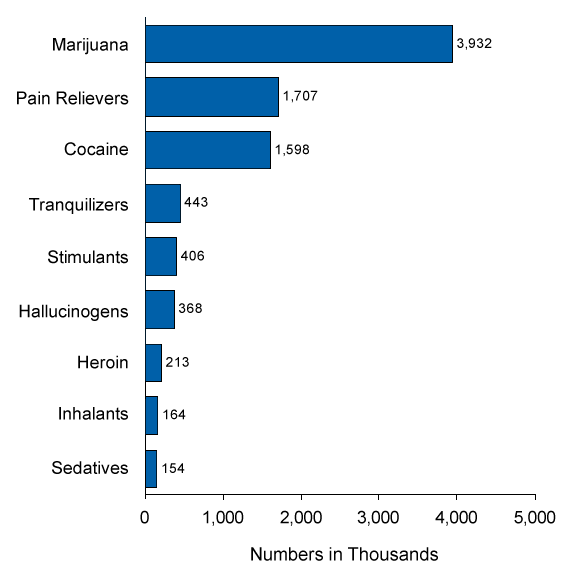
Age at First Use
- In 2007, among adults
aged 18 or older who first tried marijuana at age 14 or younger, 12.9 percent
were classified with illicit drug dependence or abuse, higher than the 2.7 percent
of adults who had first used marijuana at age 18 or older.
- Among adults, age at
first use of alcohol was associated with dependence on or abuse of alcohol.
In 2007, among adults aged 18 or older who first tried alcohol at age 14
or younger, 15.9 percent were classified with alcohol dependence or
abuse compared with only 3.9 percent of adults who had first used alcohol
at age 18 or older. Adults aged 21 or older who had first used alcohol before
age 21 were more likely than adults who had their first drink at age 21
or older to be classified with alcohol dependence or abuse (9.6 vs. 2.2 percent)
(Figure 7.3).
Below is a bar graph.
Click here for the text describing this graph.
Figure 7.3
Alcohol Dependence or Abuse in the Past Year among Adults Aged 21 or Older,
by Age at First Use of Alcohol: 2007
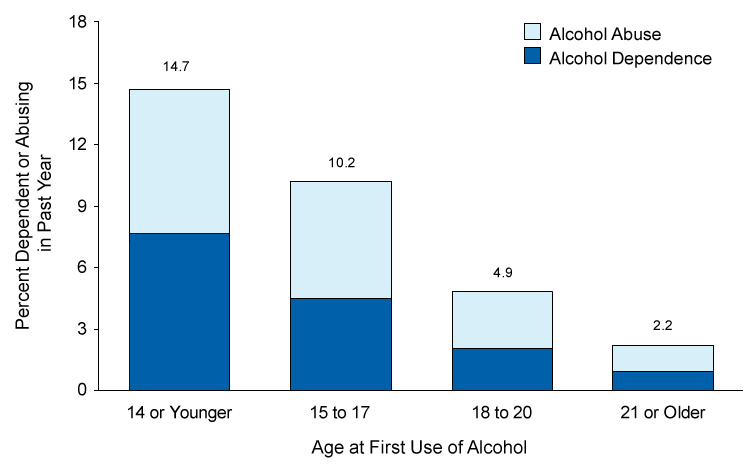
Age
- Rates of substance
dependence or abuse were associated with age. In 2007, the rate of substance
dependence or abuse among adults aged 18 to 25 (20.7 percent) was higher
than that among youths aged 12 to 17 (7.7 percent) and among adults
aged 26 or older (7.2 percent). None of these estimates changed significantly
between 2006 and 2007. For youths aged 12 to 17, the rate decreased from
8.9 percent in 2002 to 7.7 percent in 2007. There were no changes
from 2002 to 2007 for adults aged 18 to 25 and those 26 or older.
- In 2007, among persons
with substance dependence or abuse, the proportion with dependence on or
abuse of illicit drugs also was associated with age: 56.3 percent of
youths aged 12 to 17, 38.3 percent of young adults aged 18 to 25, and
23.3 percent of adults aged 26 or older. For young adults aged 18 to
25 and adults aged 26 or older, these estimates did not change significantly
between 2006 and 2007 and between 2002 and 2007. For youths aged 12 to 17,
the rate decreased between 2002 and 2007, but did not change significantly
between 2006 and 2007.
- The rate of substance
dependence or abuse among youths aged 12 to 17 remained stable between 2006
and 2007 (7.7 percent in 2007 and 8.0 percent in 2006), but the rate
in 2007 was lower than the rate in 2002 (8.9 percent). The rate of
alcohol dependence or abuse among youths aged 12 to 17 remained stable between
2006 and 2007 and between 2002 and 2007 (5.4 percent in 2007, 5.4 percent
in 2006, and 5.9 percent in 2002).
Gender
- As was the case from
2002 through 2006, the rate of substance dependence or abuse for males aged
12 or older in 2007 was about twice as high as the rate for females. For
males in 2007, the rate was 12.5 percent, which was similar to the
12.3 percent in 2006, while for females, it was 5.7 percent, which
was lower than the 6.3 percent in 2006 (Figure 7.4).
Among youths aged 12 to 17, however, the rate of substance dependence or
abuse among males was similar to the rate among females during the 6-year
period (7.7 vs. 7.7 percent in 2007; 8.0 vs. 8.1 percent in 2006; and
9.3 vs. 8.6 percent in 2002).
Below is a bar graph.
Click here for the text describing this graph.
Figure 7.4 Substance
Dependence or Abuse in the Past Year, by Age and Gender: 2007
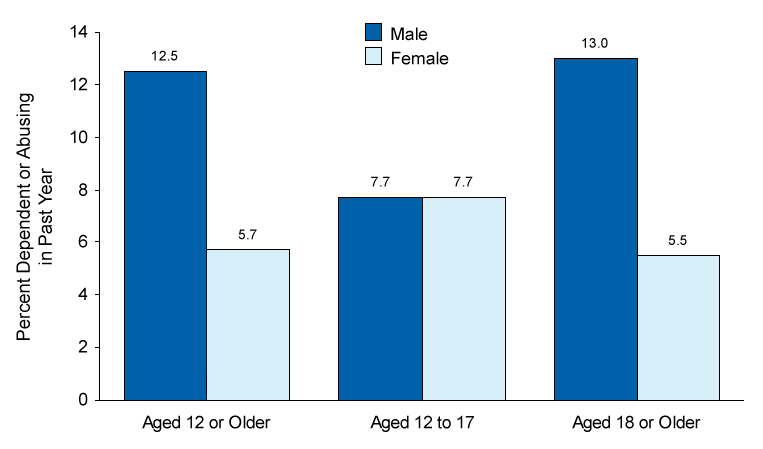
- The rate of illicit
drug dependence or abuse among males aged 12 or older was similar between
2006 and 2007 and between 2002 and 2007 (3.8 percent in 2007, 3.7 percent
in 2006, and 4.0 percent in 2002). The rate for females remained stable
between 2006 and 2007, but decreased between 2002 and 2007 (1.8 percent
in 2007, 2.0 percent in 2006, and 2.1 percent in 2002).
Race/Ethnicity
- In 2007, among persons
aged 12 or older, the rate of substance dependence or abuse was the lowest
among Asians (4.7 percent). Racial/ethnic groups with similar rates
included American Indians or Alaska Natives (13.4 percent), persons
reporting two or more races (10.8 percent), Native Hawaiians or Other Pacific
Islanders (9.9 percent), whites (9.4 percent), blacks (8.5 percent),
and Hispanics (8.3 percent). These rates in 2007 were similar to the
rates in 2002 and 2006, except that the rate of substance dependence or
abuse among Hispanics in 2007 was lower than the rate in 2002 (10.4 percent)
and 2006 (10.0 percent).
Education/Employment
- Rates of substance
dependence or abuse were associated with level of education in 2007. Among
adults aged 18 or older, those who graduated from a college or university
had a lower rate of dependence or abuse (7.5 percent) than those who
graduated from high school (9.3 percent), those who did not graduate
from high school (9.8 percent), and those with some college (10.3 percent).
- Rates of substance
dependence or abuse were associated with current employment status in 2007.
A higher percentage of unemployed adults aged 18 or older were classified
with dependence or abuse (20.0 percent) than were full-time employed
adults (10.1 percent) or part-time employed adults (10.6 percent).
- Most adults aged 18
or older with substance dependence or abuse were employed full time in 2007.
Of the 20.4 million adults classified with dependence or abuse, 12.3 million
(60.4 percent) were employed full time.
Criminal Justice Populations
- In 2007, adults aged
18 or older who were on parole or a supervised release from jail during
the past year had higher rates of dependence on or abuse of a substance
(37.2 percent) than their counterparts who were not on parole or supervised
release during the past year (8.9 percent).
- In 2007, probation
status was associated with substance dependence or abuse. The rate of substance
dependence or abuse was 37.4 percent among adults who were on probation
during the past year, which was significantly higher than the rate among
adults who were not on probation during the past year (8.5 percent).
Geographic Area
- In 2007, rates of substance
dependence or abuse for persons aged 12 or older showed evidence of differences
by region, with the Midwest (10.0 percent) having a higher rate than
the South (8.7 percent) and the Northeast (8.1 percent), but a
similar rate to the West (9.2 percent). Rates for substance dependence
or abuse among persons aged 12 or older in 2007 also varied by county type,
with small metropolitan counties (9.4 percent) having a significantly
higher rate than nonmetropolitan counties (8.3 percent), but a similar
rate when compared with large metropolitan counties (9.0 percent).
7.2. Past Year Treatment
for a Substance Use Problem
Estimates described in
this section refer to treatment received for illicit drug or alcohol use,
or for medical problems associated with the use of illicit drugs or alcohol.
This includes treatment received in the past year at any location, such as
a hospital (inpatient), rehabilitation facility (outpatient or inpatient),
mental health center, emergency room, private doctor's office, prison or jail,
or a self-help group, such as Alcoholics Anonymous or Narcotics Anonymous.
Persons could report receiving treatment at more than one location. Note that
the definition of treatment in this section is different from the definition
of specialty treatment described in Section 7.3.
Specialty treatment only includes treatment at a hospital (inpatient), a rehabilitation
facility (inpatient or outpatient), or a mental health center.
Individuals who reported
receiving substance use treatment but were missing information on whether
the treatment was specifically for alcohol use or illicit drug use were not
counted in estimates of illicit drug use treatment or in estimates of alcohol
use treatment; however, they were counted in estimates for "drug or alcohol
use" treatment.
- In 2007, 3.9 million
persons aged 12 or older (1.6 percent of the population) received some
kind of treatment for a problem related to the use of alcohol or illicit
drugs. Of these, 1.4 million received treatment for the use of both alcohol
and illicit drugs, 0.8 million received treatment for the use of illicit
drugs but not alcohol, and 1.3 million received treatment for the use of
alcohol but not illicit drugs. (Note that estimates by substance do not
sum to the total number of persons receiving treatment because the total
includes persons who reported receiving treatment but did not report for
which substance the treatment was received.)
- The number and the
percentage of the population aged 12 or older receiving substance use treatment
within the past year remained stable between 2006 and 2007 and between 2002
and 2007 (3.9 million, 1.6 percent in 2007; 4.0 million, 1.6 percent
in 2006; and 3.5 million, 1.5 percent in 2002).
- In 2007, among the
3.9 million persons aged 12 or older who received treatment for alcohol
or illicit drug use in the past year, 2.2 million persons received treatment
at a self-help group, and 1.7 million received treatment at a rehabilitation
facility as an outpatient (Figure 7.5).
There were 1.0 million persons who received treatment at a rehabilitation
facility as an inpatient, 889,000 persons who received treatment at a mental
health center as an outpatient, 779,000 at a hospital as an inpatient, 593,000
at a private doctor's office, 523,000 at an emergency room, and 302,000
at a prison or jail. None of these estimates changed significantly between
2006 and 2007 or between 2002 and 2007.
- In 2007, during their
most recent treatment in the past year, 2.5 million persons aged 12 or older
reported receiving treatment for alcohol use, and 936,000 persons reported
receiving treatment for marijuana use (Figure 7.6).
Accordingly, estimates on receiving treatment for the use of other drugs
were 809,000 persons for cocaine, 558,000 for pain relievers, 335,000 for
heroin, 311,000 for stimulants, and 303,000 for hallucinogens. None of these
estimates changed significantly between 2006 and 2007, except that the numbers
who received treatment for marijuana use and for nonmedical use of stimulants
in 2007 were lower than the numbers in 2006 (1.2 million and 535,000 persons,
respectively). None of these estimates changed significantly between 2002
and 2007, except that the number who received treatment for the use of pain
relievers in 2007 was higher than the number in 2002 (360,000 persons).
(Note that respondents could indicate that they received treatment for more
than one substance during their most recent treatment.)
Below is a bar graph.
Click here for the text describing this graph.
Figure 7.5 Locations
Where Past Year Substance Use Treatment Was Received among Persons Aged 12
or Older: 2007
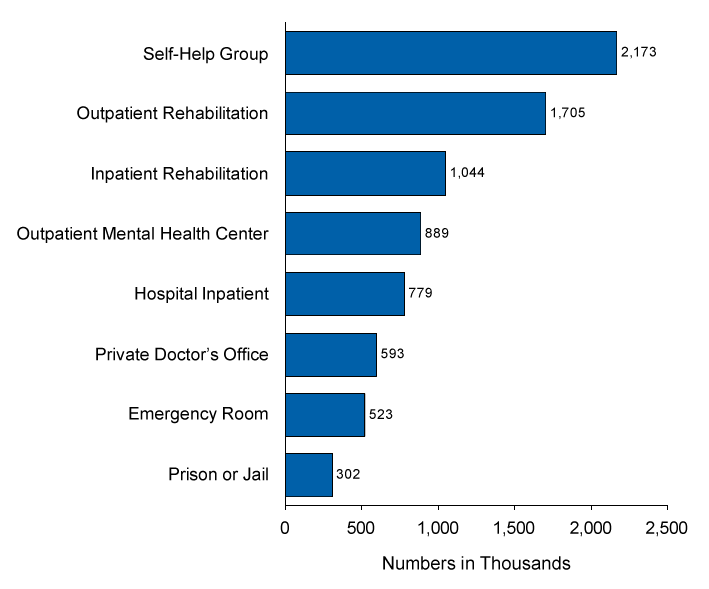
Below is a bar graph.
Click here for the text describing this graph.
Figure 7.6 Substances
for Which Most Recent Treatment Was Received in the Past Year among Persons
Aged 12 or Older: 2007
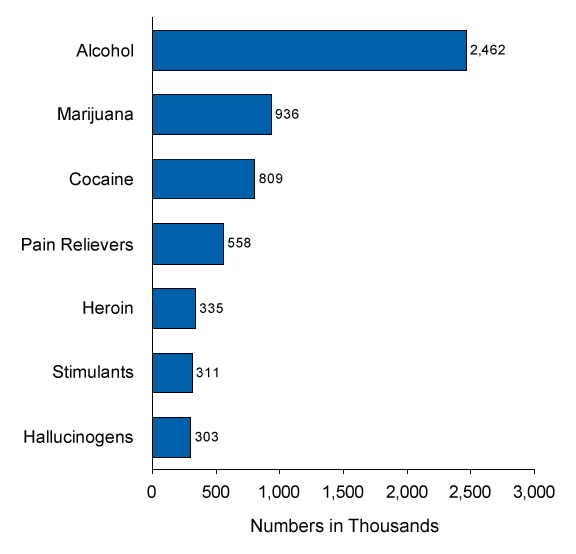
7.3. Need for and Receipt
of Specialty Treatment
This section discusses
the need for and receipt of treatment for a substance use problem at a "specialty"
treatment facility. Specialty treatment is defined as treatment received at
any of the following types of facilities: hospitals (inpatient only), drug
or alcohol rehabilitation facilities (inpatient or outpatient), or mental
health centers. It does not include treatment at an emergency room, private
doctor's office, self-help group, prison or jail, or hospital as an outpatient.
An individual is defined as needing treatment for an alcohol or drug use problem
if he or she met the DSM-IV (APA, 1994) diagnostic criteria for dependence
on or abuse of alcohol or illicit drugs in the past 12 months or if he or
she received specialty treatment for alcohol use or illicit drug use in the
past 12 months.
In this section, an individual
needing treatment for an illicit drug use problem is defined as receiving
treatment for his or her drug use problem only if he or she reported receiving
specialty treatment for drug use in the past year. Thus, an individual who
needed treatment for illicit drug use but only received specialty treatment
for alcohol use in the past year or who received treatment for illicit drug
use only at a facility not classified as a specialty facility was not counted
as receiving treatment for drug use. Similarly, an individual who needed treatment
for an alcohol use problem was only counted as receiving alcohol use treatment
if the treatment was received for alcohol use at a specialty treatment facility.
Individuals who reported receiving specialty substance use treatment but were
missing information on whether the treatment was specifically for alcohol
use or drug use were not counted in estimates of specialty drug use treatment
or in estimates of specialty alcohol use treatment; however, they were counted
in estimates for "drug or alcohol use" treatment.
In addition to questions
about symptoms of substance use problems that are used to classify respondents'
need for treatment based on DSM-IV criteria, NSDUH includes questions
asking respondents about their perceived need for treatment (i.e., whether
they felt they needed treatment or counseling for illicit drug use or alcohol
use). In this report, estimates for perceived need for treatment are only
discussed for persons who were classified as needing treatment (based on DSM-IV
criteria) but did not receive treatment at a specialty facility. Similarly,
estimates for whether a person made an effort to get treatment are only discussed
for persons who felt the need for treatment.
Illicit Drug or Alcohol
Use Treatment and Treatment Need
- In 2007, 23.2 million
persons aged 12 or older needed treatment for an illicit drug or alcohol
use problem (9.4 percent of the persons aged 12 or older). Of these,
2.4 million (1.0 percent of persons aged 12 or older and 10.4 percent
of those who needed treatment) received treatment at a specialty facility.
Thus, 20.8 million persons (8.4 percent of the population aged 12 or
older) needed treatment for an illicit drug or alcohol use problem but did
not receive treatment at a specialty substance abuse facility in the past
year. These estimates are similar to the estimates for 2006 and for 2002.
- Of the 2.4 million
people aged 12 or older who received specialty substance use treatment in
2007, 952,000 received treatment for alcohol use only, 728,000 received
treatment for illicit drug use only, and 615,000 persons received treatment
for both alcohol and illicit drug use. These estimates are similar to the
estimates for 2006 and for 2002.
- In 2007, among persons
who received their last or current substance use treatment at a specialty
facility in the past year, 53.3 percent reported using their "own
savings or earnings" as a source of payment for their most recent specialty
treatment, 34.9 percent reported using private health insurance, 26.3 percent
reported using public assistance other than Medicaid, 19.7 percent
reported using Medicare, 19.6 percent reported using funds from family
members, and 18.2 percent reported using Medicaid. None of these estimates
changed significantly between 2006 and 2007 and between 2002 and 2007, except
that the 53.3 percent reported using their "own savings or earnings"
as a source of payment in 2007 was higher than the 42.1 percent reported
in 2006. (Note that persons could report more than one source of payment.)
- Of the 20.8 million
persons in 2007 who were classified as needing substance use treatment but
not receiving treatment at a specialty facility in the past year, 1.3 million
persons (6.4 percent) reported that they perceived a need for treatment
for their illicit drug or alcohol use problem (Figure 7.7).
Of these 1.3 million persons who felt they needed treatment but did not
receive treatment in 2007, 380,000 (28.5 percent) reported that they
made an effort to get treatment, and 955,000 (71.5 percent) reported
making no effort to get treatment.
Below is a pie chart.
Click here for the text describing this chart.
Figure 7.7 Past Year
Perceived Need for and Effort Made to Receive Specialty Treatment among Persons
Aged 12 or Older Needing But Not Receiving Treatment for Illicit Drug or Alcohol
Use: 2007
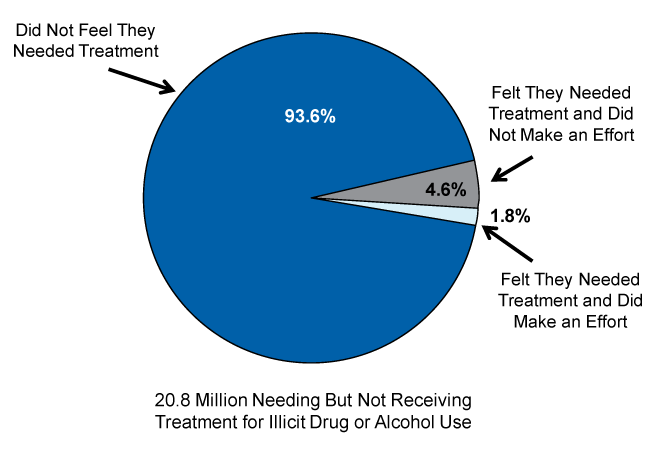
- The number and the
percentage of youths aged 12 to 17 who needed treatment for an illicit drug
or alcohol use problem remained unchanged between 2006 and 2007; however,
there was a significant decrease between 2002 and 2007 (2.0 million youths
and 7.9 percent of the population in 2007; 2.1 million and 8.2 percent
in 2006; and 2.3 million and 9.1 percent in 2002). Of the 2.0 million
youths who needed treatment in 2007, 150,000 received treatment at a specialty
facility (about 7.6 percent of the youths who needed treatment), leaving
1.8 million who needed treatment for a substance use problem but did not
receive it at a specialty facility.
- Based on 2004-2007
combined data, five of the most often reported reasons for not receiving
illicit drug or alcohol use treatment among persons who needed but did not
receive treatment at a specialty facility and perceived a need for treatment
included (a) not ready to stop using (38.7 percent), (b) no health
coverage and could not afford cost (31.1 percent), (c) possible negative
effect on job (11.6 percent), (d) not knowing where to go for treatment
(11.6 percent), and (e) concern that receiving treatment might cause
neighbors/community to have negative opinion (11.1 percent).
- Based on 2004-2007
combined data, among persons who needed but did not receive illicit drug
or alcohol use treatment, made an effort to receive treatment, and felt
a need for treatment, some of the most often reported reasons for not receiving
treatment were (a) no health coverage and could not afford cost (35.9 percent),
(b) not ready to stop using (26.6 percent), (c) able to handle the
problem without treatment (12.5 percent), (d) no transportation/inconvenient
(10.5 percent), (e) might cause neighbors/community to have negative
opinion (8.9 percent), (f) no program having type of treatment (8.1 percent),
(g) might have negative effect on job (7.0 percent), and (h) did not
know where to go for treatment (6.9 percent) (Figure 7.8).
Below is a bar graph.
Click here for the text describing this graph.
Figure 7.8 Reasons for
Not Receiving Substance Use Treatment among Persons Aged 12 or Older Who Needed
and Made an Effort to Get Treatment But Did Not Receive Treatment and Felt
They Needed Treatment: 2004-2007 Combined

Illicit Drug Use Treatment
and Treatment Need
- In 2007, the number
of persons aged 12 or older needing treatment for an illicit drug use problem
was 7.5 million (3.0 percent of the total population). Of these, 1.3
million (0.5 percent of the total population and 17.8 percent
of the persons who needed treatment) received treatment at a specialty facility
for an illicit drug use problem in the past year. Thus, there were 6.2 million
persons (2.5 percent of the total population) who needed treatment
but did not receive treatment at a specialty facility for an illicit drug
use problem in 2007. None of these estimates changed significantly between
2006 and 2007 and between 2002 and 2007.
- The number of persons
needing treatment for illicit drug use in 2007 (7.5 million) was similar
to the number needing treatment in 2002 (7.7 million), 2003 (7.3 million),
2004 (8.1 million), 2005 (7.6 million), and 2006 (7.8 million). Also, the
number of persons needing but not receiving specialty treatment in the past
year for an illicit drug use problem in 2007 (6.2 million) was similar to
the estimates in 2002 (6.3 million), 2003 (6.2 million), 2004 (6.6 million),
2005 (6.3 million), and 2006 (6.2 million).
- Of the 6.2 million
people aged 12 or older who needed but did not receive specialty treatment
for illicit drug use in 2007, 548,000 (8.9 percent) reported that they perceived
a need for treatment for their illicit drug use problem. Of the 548,000
persons who felt a need for treatment in 2007, 205,000 (37.5 percent)
reported that they made an effort and 343,000 (62.5 percent) reported
making no effort to get treatment.
- Among youths aged 12
to 17, there were 1.1 million (4.5 percent) who needed treatment for
an illicit drug use problem in 2007. Of this group, only 111,000 received
treatment at a specialty facility (9.9 percent of youths aged 12 to
17 who needed treatment), leaving 1.0 million youths who needed treatment
but did not receive it at a specialty facility.
- Among people aged 12
or older who needed but did not receive illicit drug use treatment and felt
they needed treatment (based on 2004-2007 combined data), six of the
most often reported reasons for not receiving treatment were (a) no health
coverage and could not afford cost (34.3 percent), (b) not ready to
stop using (31.8 percent), (c) concern that getting treatment might
cause neighbors/community to have negative opinion (14.4 percent),
(d) not knowing where to go for treatment (13.5 percent), (e) being
able to handle the problem without treatment (12.7 percent), and (f) possible
negative effect on job (11.7 percent).
Alcohol Use Treatment
and Treatment Need
- In 2007, the number
of persons aged 12 or older needing treatment for an alcohol use problem
was 19.3 million (7.8 percent of the population aged 12 or older).
Of these, 1.6 million (0.6 percent of the total population and 8.1 percent
of the people who needed treatment for an alcohol use problem) received
alcohol use treatment at a specialty facility. Thus, there were 17.7 million
people who needed treatment but did not receive treatment at a specialty
facility for an alcohol use problem. None of these estimates changed significantly
between 2006 and 2007 and between 2002 and 2007.
- Among the 17.7 million
people aged 12 or older who needed but did not receive treatment for an
alcohol use problem in 2007, there were 859,000 (4.8 percent) who felt
they needed treatment for their alcohol use problem. The number and the
percentage were higher than those reported in 2006 (541,000 persons and
3.0 percent, respectively), but were similar to those reported in 2002
(761,000 persons and 4.5 percent, respectively). Of these, 619,000
(72.1 percent) did not make an effort to get treatment, and 240,000
(27.9 percent) made an effort but were unable to get treatment in 2007.
- In 2007, there were
1.4 million youths (5.5 percent) aged 12 to 17 who needed treatment
for an alcohol use problem. Of this group, only 82,000 received treatment
at a specialty facility (0.3 percent of all youths and 5.9 percent
of youths who needed treatment), leaving 1.3 million youths who needed but
did not receive treatment.
8. Mental
Health
This chapter presents
findings on mental health problems in the United States, including the prevalence
of serious psychological distress (SPD) and major depressive episode (MDE)
and the association of these problems with substance use and substance dependence
or abuse (substance use disorder). Also reported here are the rates of treatment
for depression (among those with MDE) in the past year, the percentages of
adults aged 18 or older and youths aged 12 to 17 who received mental health
care in the past year, and the percentage of adults who had an unmet need
for mental health care in the past year.
SPD is an overall indicator
of past year psychological distress that is derived from the K6 scale administered
to adults aged 18 or older in the National Survey on Drug Use and Health (NSDUH).
Numerical scores derived from responses to these six questions range from
0 to 24. For this report, a score of 13 or higher is considered SPD. It is
notable that the data related to SPD assessed from 2004 to 2007 are not directly
comparable with data from earlier years because of study design changes. Further
information on the measurement of SPD, the scoring algorithm, and the study
design changes is provided in Section B.4.4
of Appendix B.
A module of questions
designed to obtain measures of lifetime and past year prevalence of MDE, the
level of functional impairment caused by MDE in the past year, and treatment
for depression has been administered to adults aged 18 or older and youths
aged 12 to 17 since 2004. Some questions in the adolescent depression module
were modified slightly from the adult depression module to make them more
appropriate for youths. Given these differences, adult and youth depression
estimates are presented separately in this chapter.
MDE is defined as a period
of at least 2 weeks when a person experienced a depressed mood or loss of
interest or pleasure in daily activities and had at least four of the seven
additional symptoms reflecting the criteria for major depressive disorder
as described in the 4th edition of the Diagnostic and Statistical Manual
of Mental Disorders (DSM-IV) (American Psychiatric Association [APA],
1994). It should be noted that no exclusions were made for MDE caused by medical
illness, bereavement, or substance use disorders. Impairment is defined by
the level of role interference reported to be caused by MDE in the past 12
months. For adults, the Sheehan Disability Scale (SDS) role domains are (1)
home management, (2) work/school, (3) close relationships with others, and
(4) social life. The role domains are assessed on a 0 to 10 scale with impairment
categories of none (0), mild (1-3), moderate (4-6), severe (7-9),
and very severe (10). The role domains for youths are slightly modified to
be made age appropriate, but are assessed on the same 0 to 10 scale described
for adults. The specific questions used to measure MDE and role impairment
and the scoring algorithm for these responses are included in Section B.4.5
of Appendix B.
Although there is substantial
overlap in the populations classified with SPD and MDE, there are important
distinctions between the definitions of the two. Meeting the criteria for
SPD indicates that the respondent endorsed having symptoms at a level known
to be indicative of having a mental disorder (i.e., any disorder such as an
anxiety or mood disorder). Meeting the criteria for past year MDE indicates
that the respondent had the specific physical and emotional symptom profile
indicative of MDE in the past 12 months. MDE is known to be a fairly common
disorder that often has a significant impact on a person's work, home, and
social life.
This chapter also presents
data on mental health care among adults aged 18 or older and youths aged 12
to 17 for any type of mental health problem. Initiated in 2000, the mental
health service utilization modules are asked of respondents regardless of
MDE or SPD status. In the adult module, respondents are asked whether they
received treatment or counseling for any problem with emotions, "nerves,"
or mental health in the past year in any inpatient or outpatient setting or
used prescription medication for a mental or emotional condition. The treatment
questions in this module are generic in that they do not ask specifically
about treatment for a particular disorder, as do the questions in the MDE
module. As such, subsequent references to treatment or counseling for any
problem with emotions, nerves, or mental health are described broadly as "mental
health service use" or receiving/needing "mental health care."
It is possible for a respondent to have indicated receipt of treatment for
depression without having indicated that he or she received services for any
problems with emotions, nerves, or mental health.
In NSDUH, questions in
the youth mental health service utilization module differ from those asked
of adults. Youths aged 12 to 17 are asked whether they received any treatment
or counseling within the 12 months prior to the interview for problems with
behavior or emotions in the specialty mental health setting (outpatient or
inpatient care), the general medical setting (pediatrician or family physician
care for emotional or behavior problems), or the education setting (talked
with a counselor, psychologist, or teacher, or received special education
services while in a regular classroom or placed in a special classroom, special
program, or special school). They also are asked for the number of nights
spent in overnight facilities, the number of visits they had to outpatient
mental health providers, and the reason(s) for the most recent stay or visit.
Both the youth and the adult mental health questions specifically exclude
treatment for problems with substance use, a topic asked about in other interview
modules.
Estimates of unmet need
for mental health care are reported for adults. Unmet need is established
using a question that asks whether the respondent perceived a need for, but
did not receive mental health treatment or counseling at any time in the 12
months prior to the NSDUH interview. This measure also includes persons who
received some type of mental health service in the past 12 months, but reported
a perceived need for additional services they did not receive.
It is important to note
that because the survey covers the U.S. civilian, noninstitutionalized population,
persons residing in long-term psychiatric or other institutions continuously
throughout the year were not included in the NSDUH sampling frame. Persons
who were hospitalized or institutionalized for a period of time during 2007,
but who resided in households during the rest of the year, were included in
the sample.
8.1. Adults Aged 18 or
Older
Prevalence of Serious
Psychological Distress among Adults
- In 2007, there were
an estimated 24.3 million adults aged 18 or older in the United States with
SPD in the past year. This represents 10.9 percent of all adults in
this country, a rate similar to the SPD rate in 2006 (11.3 percent)
(Figure 8.1), but below the
rate in 2004 (12.2 percent).
Below is a bar graph.
Click here for the text describing this graph.
Figure 8.1 Serious Psychological
Distress in the Past Year among Adults Aged 18 or Older, by Age: 2006-2007
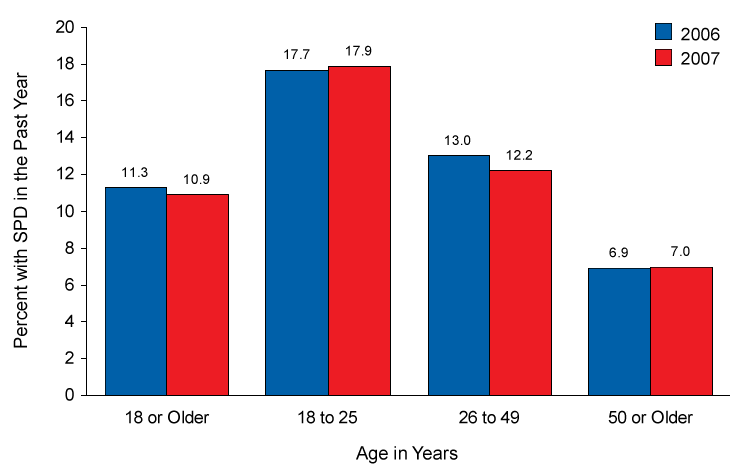
+
Difference between this estimate and the 2007 estimate is statistically significant
at the .05 level.
- Rates of SPD in 2007
were highest for adults aged 18 to 25 (17.9 percent) and lowest for
adults aged 50 or older (7.0 percent).
- The prevalence of SPD
in 2007 among women aged 18 or older (13.4 percent) was significantly
higher than among men in that age group (8.2 percent).
- In 2007, rates of past
year SPD were lowest among Asians at 6.4 percent. Rates for other racial/ethnic
groups were 10.2 percent among Hispanics, 10.5 percent among blacks,
11.3 percent among whites, 11.9 percent among Native Hawaiians
or Other Pacific Islanders, 13.7 percent among American Indians or
Alaska Natives, and 14.0 percent among persons reporting two or more
races.
Mental Health Service
Use among Adults with Serious Psychological Distress
- Among the 24.3 million
adults aged 18 or older with SPD in 2007, 10.8 million (44.6 percent)
used mental health services in the past year. Among all adults with SPD,
38.8 percent received prescription medication, 27.3 percent received
outpatient services, and 5.1 percent received inpatient services for
a mental health problem in the past year. Respondents could report more
than one type of service used.
- Among those with SPD
who reported receiving mental health services in the past year, 47.2 percent
received one type of care (inpatient, outpatient, or prescription medication),
45.9 percent received two types of care, and 6.9 percent received
all three types of care (Figure 8.2).
Below is a pie chart.
Click here for the text describing this chart.
Figure 8.2 Number of
Types of Mental Health Services Received in the Past Year among Persons Aged
18 or Older with Past Year Serious Psychological Distress Who Received Mental
Health Services in the Past Year: 2007
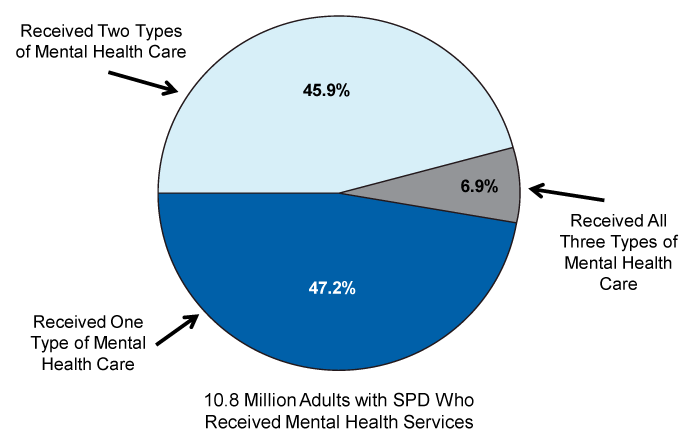
Note:
The three types of mental health care are receiving inpatient care, outpatient
care, or prescription medication.
Serious Psychological
Distress and Substance Use and Dependence or Abuse among Adults
- Past year illicit drug
use in 2007 was higher among adults aged 18 or older with SPD (28.0 percent)
than among adults without SPD (12.2 percent). Similarly, the rate of past
month cigarette use was higher among adults with SPD (42.1 percent)
than among adults without SPD (23.9 percent).
- Among adults aged 18
or older with past year SPD in 2007, the rate of binge alcohol use (drinking
five or more drinks on the same occasion [i.e., at the same time or within
a couple of hours of each other] on at least 1 day in the past 30 days)
was 32.2 percent, which was higher than the 24.0 percent among
adults who did not meet the criteria for SPD. Similarly, the rate of heavy
alcohol use (drinking five or more drinks on the same occasion on each of
5 or more days in the past 30 days) among adults with SPD in the past year
was higher (10.9 percent) than the rate reported among adults without
SPD in the past year (6.9 percent).
- SPD in the past year
was associated with past year substance dependence or abuse in 2007. Among
adults aged 18 or older with SPD, 22.1 percent were dependent on or abused
illicit drugs or alcohol. The rate among adults without SPD was 7.6 percent.
Mental Health Care among
Adults with Co-Occurring Serious Psychological Distress and Substance
Use Disorders
- Among the 5.4 million
adults aged 18 or older with both SPD and substance dependence or abuse
(i.e., a substance use disorder) in 2007, 46.5 percent received mental
health care or substance use treatment at a specialty facility; 10.4 percent
received both mental health care and specialty substance use treatment,
33.3 percent received only mental health care, and 2.8 percent
received only specialty substance use treatment (Figure 8.3).
Below is a pie chart.
Click here for the text describing this chart.
Figure 8.3 Past Year
Mental Health Care among Adults Aged 18 or Older with Both Serious Psychological
Distress and a Substance Use Disorder: 2007
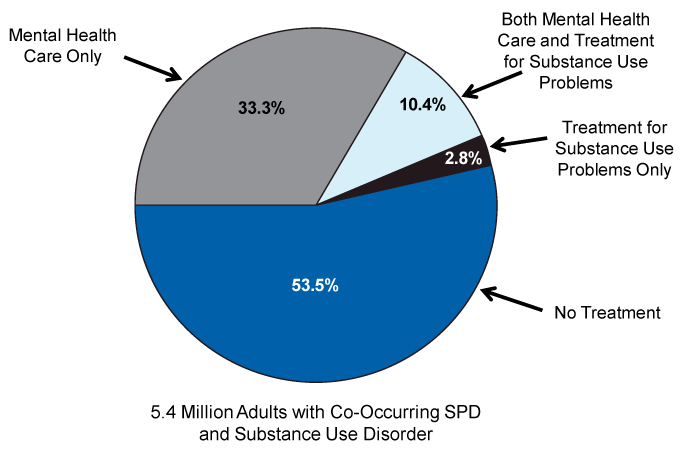
Prevalence of Major Depressive
Episode among Adults
- In 2007, 7.5 percent
of adults aged 18 or older (16.5 million people) had at least one MDE in
the past year (Figure 8.4).
Almost 1 in 20 adults (4.6 percent or 10.1 million people) had a past
year MDE with severe impairment. The rates of past year MDE and MDE with
severe impairment were stable between 2006 and 2007.
Below is a bar graph.
Click here for the text describing this graph.
Figure 8.4 Major Depressive
Episode in the Past Year among Adults Aged 18 or Older, by Severe Impairment,
Age, and Gender: 2007
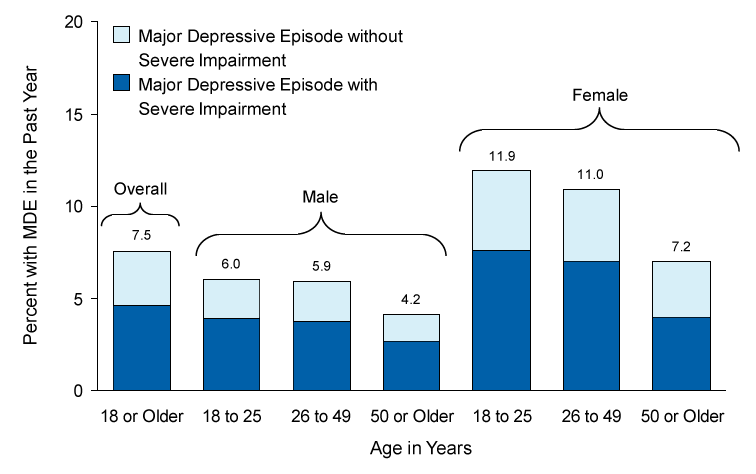
Note:
Respondents with an unknown level of impairment were included in the estimates
for Major Depressive Episode without Severe Impairment.
- The past year prevalence
of MDE in 2007 was lowest for those aged 50 or older (5.8 percent).
The rates were similar among persons aged 18 to 25 (8.9 percent) and
those aged 26 to 49 (8.5 percent).
- The past year prevalence
of MDE was higher among adult females than among adult males (9.5 vs. 5.3 percent).
Among women, past year MDE rates were higher in the younger age groups (11.9 percent
for 18 to 25 year olds, 11.0 percent for 26 to 49 year olds) compared
with those 50 or older (7.2 percent).
- Among adults aged 18
or older, past year prevalence of MDE varied by race/ethnicity in 2007.
The rate of MDE was lowest among Asians (2.9 percent), while rates for other
groups were 12.1 percent among persons reporting two or more races,
9.2 percent among American Indians or Alaska Natives, 8.1 percent
among whites, 6.3 percent among Hispanics, and 6.1 percent among
blacks.
- Among adults aged 18
or older in 2007, past year prevalence of MDE with severe impairment was
higher among unemployed persons (10.2 percent) than among persons employed
full time (3.6 percent), persons employed part time (5.2 percent),
and persons not in the labor force (5.7 percent).
Major Depressive Episode
and Substance Use and Dependence or Abuse among Adults
- In 2007, adults aged
18 or older with past year MDE had higher rates of past year illicit drug
use than those without MDE (27.4 vs. 12.8 percent). A similar pattern was
observed for specific types of past year illicit drug use, such as marijuana,
cocaine, heroin, hallucinogens, inhalants, and the nonmedical use of prescription-type
psychotherapeutics.
- Among adults aged 18
or older with MDE in the past year, 10.4 percent were heavy alcohol
users in the past month, higher than the 7.1 percent of heavy alcohol users
without MDE in the past year. Similarly, among adults with past year MDE,
the rate of daily cigarette use in the past month was 28.7 percent,
while the rate was 15.2 percent among adults without past year MDE.
- Having MDE in the past
year was associated with past year substance dependence or abuse. Among
adults aged 18 or older who had MDE in 2007, 21.5 percent were dependent
on or abused alcohol or illicit drugs, while among adults without MDE 8.2 percent
were dependent on or abused alcohol or illicit drugs (Figure 8.5).
Adults with past year MDE were more likely than those without MDE to be
dependent on or abuse illicit drugs (8.8 vs. 2.1 percent) and alcohol
(17.0 vs. 7.0 percent).
Below is a bar graph.
Click here for the text describing this graph.
Figure 8.5 Substance
Dependence or Abuse among Adults Aged 18 or Older, by Major Depressive Episode
in the Past Year: 2007
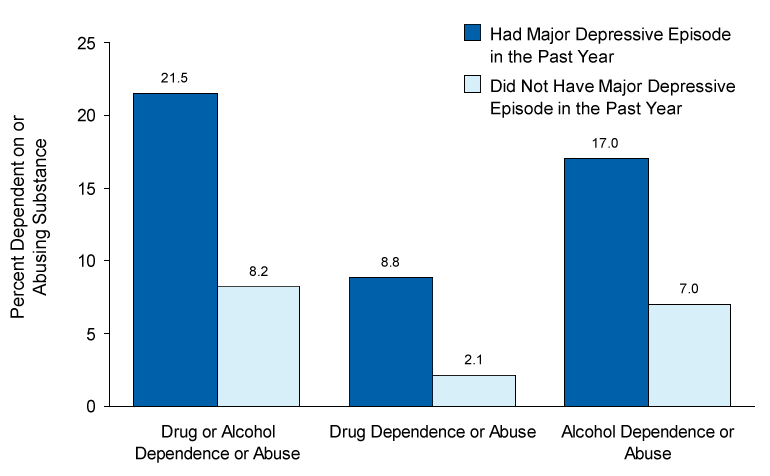
Treatment for Major Depressive
Episode among Adults
- Among adults aged 18
or older who had past year MDE in 2007, 64.5 percent received treatment
(i.e., saw or talked to a medical doctor or other professional or used prescription
medication) for depression in the same time period, which was lower than
in 2006 (69.1 percent). Among persons aged 50 or older who had MDE
in the past year, the treatment rate decreased from 85.4 percent in
2006 to 74.2 percent in 2007. Of adults aged 18 or older who had past
year MDE with severe impairment in 2007, 72.2 percent received treatment,
similar to the rate in 2006 (74.1 percent).
- In 2007, women aged
18 or older who had MDE in the past year were more likely than men to receive
treatment for depression in the past year (68.0 vs. 57.8 percent),
though the treatment rate for women was significantly lower than in 2006
(73.7 percent).
- Among adults aged 18
or older with past year MDE in 2007, approximately half of those with no
insurance (49.3 percent) received treatment for depression in the past
year compared with higher rates for those with insurance: 64.4 percent
of adults with private insurance, 76.7 percent of adults covered by
Medicaid or CHIP, and 77.6 percent of adults with other health insurance
(including Medicare, CHAMPUS, TRICARE, CHAMPVA, VA, and other sources of
health care or insurance). The rates of treatment for adults with private
health insurance and other health insurance decreased from 2006 (71.1 and
86.8 percent, respectively).
Mental Health Service
Use and Unmet Need for Mental Health Care among Adults
- In 2007, 29.4 million
adults (13.2 percent of the population 18 years or older) received
mental health services during the past 12 months (Figure 8.6).
This was similar to the rate in 2006 (12.9 percent).
- In 2007, the type of
mental health services most often received by adults aged 18 or older was
prescription medication (11.1 percent), followed by outpatient services
(6.9 percent). Rates of prescription medication and outpatient service
use in 2007 were similar to the rates in 2006 (10.9 and 6.7 percent,
respectively). Respondents could report receiving more than one type of
mental health care.
Below is a line graph.
Click here for the text describing this graph.
Figure 8.6 Past Year
Mental Health Service Use among Adults Aged 18 or Older, by Type of Care:
2002-2007

+
Difference between this estimate and the 2007 estimate is statistically significant
at the .05 level.
- About 2.1 million adults
(1.0 percent of the population aged 18 years or older) received inpatient
care for mental health problems during the past year. This estimate was
the same as the rate reported in 2005 after a significant decline in inpatient
care noted in 2006 (0.7 percent or 1.6 million adults).
- Rates of mental health
service use varied by age for adults aged 18 or older: 10.3 percent
for adults aged 18 to 25, 14.3 percent for adults aged 26 to 49, and
13.2 percent for adults aged 50 or older.
- Men were less likely
than women to receive outpatient mental health services (4.7 vs. 9.0 percent)
and prescription medication (7.5 vs. 14.5 percent) for mental health
problems in the past year. There was no significant gender difference in
inpatient care (1.0 vs. 0.9 percent).
- Among racial/ethnic
groups, the rates of mental health service use for adults aged 18 or older
in 2007 were 16.0 percent for whites, 15.6 percent for persons reporting
two or more races, 11.6 percent for American Indians or Alaska Natives,
7.3 percent for Hispanics, 6.8 percent for blacks, and 3.9 percent
for Asians.
- In 2007, there were
10.9 million adults aged 18 or older (4.9 percent) who reported an
unmet need for mental health care in the past year. This included 5.4 million
adults who did not receive any mental health services in the past year.
Among the 5.5 million adults with an unmet need who did receive some type
of mental health service in the past year, 18.7 percent reported an
unmet need for mental health care. (Unmet need among adults who received
mental health services may reflect a delay in care or a perception of insufficient
care.)
- Among the 5.4 million
adults who reported an unmet need for mental health care and did not receive
mental health services in the past year, several barriers to care were reported.
These included an inability to afford care (43.2 percent), believing
at the time that the problem could be handled without care (29.3 percent),
not knowing where to go for care (18.1 percent), and not having the
time to go for care (16.7 percent) (Figure 8.7).
Below is a bar graph.
Click here for the text describing this graph.
Figure 8.7 Reasons for
Not Receiving Mental Health Services in the Past Year among Adults Aged 18
or Older with an Unmet Need for Mental Health Care Who Did Not Receive Mental
Health Services: 2007
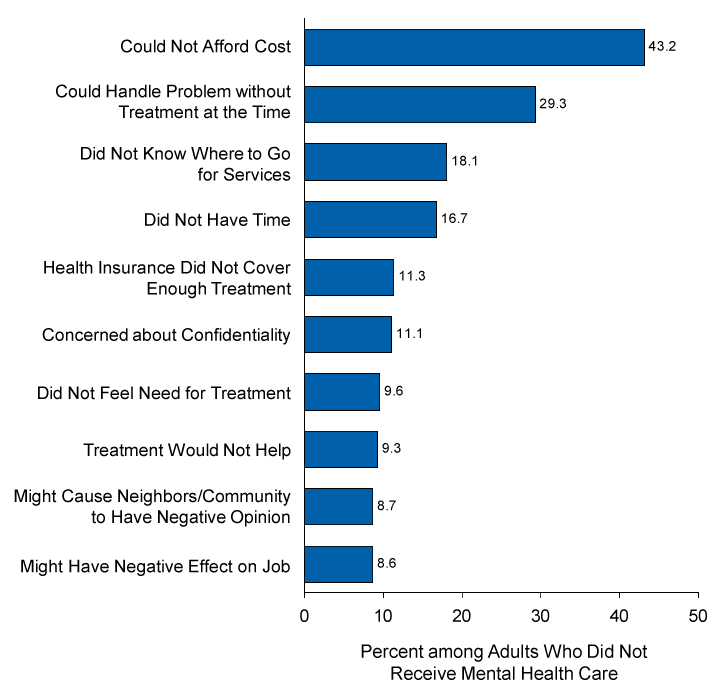
8.2. Youths Aged 12 to
17
Prevalence of Major Depressive
Episode among Youths
- In 2007, there were
2.0 million youths (8.2 percent of the population aged 12 to 17) who
had major depressive episode (MDE) during the past year. An estimated 1.4
million (5.5 percent) had MDE with severe impairment in one or more
role domains (chores at home; school or work; close relationships with family;
or social life).
- Among youths aged 12
to 17 in 2007, the past year prevalence of MDE ranged from 2.8 percent
among 12 year olds to 11.8 percent among those aged 16 and 11.1 percent
among those aged 17. Similarly, rates of past year MDE with severe impairment
ranged from 1.8 percent among 12 years olds to 7.9 percent among
16 and 17 year olds.
- Among youths aged 12
to 17 in 2007, the prevalence rates of MDE and MDE with severe impairment
among females were more than twice those among males. Female youths had
an MDE prevalence rate of 11.9 percent in 2007, while the rate for
males in the same age range was 4.6 percent. The prevalence of MDE
with severe impairment was 8.2 percent for females and 3.0 percent
for males (Figure 8.8).
Below is a bar graph.
Click here for the text describing this graph.
Figure 8.8
Major Depressive Episode in the Past Year among Youths Aged 12 to 17, by Severe
Impairment, Age, and Gender: 2007
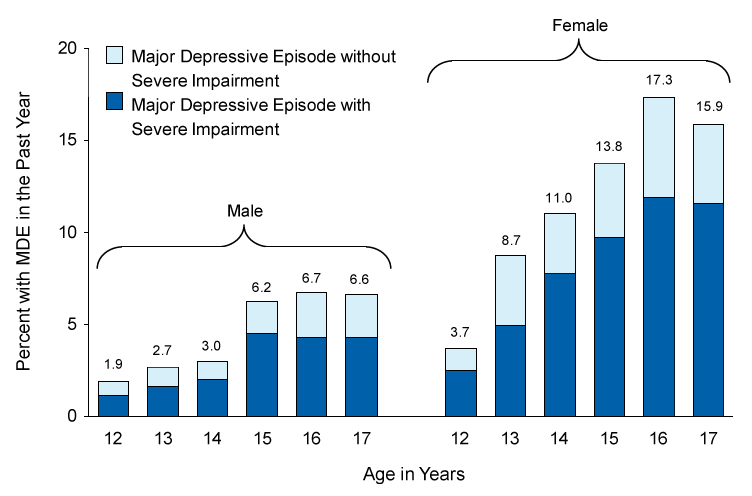
Note:
Respondents with an unknown level of impairment were included in the estimates
for Major Depressive Episode without Severe Impairment.
Major Depressive Episode
and Substance Use among Youths
- Among 12 to 17 year
olds who had past year MDE in 2007, 35.5 percent had used illicit drugs
during the same period (Figure 8.9).
This was higher than the rate of 17.2 percent among youths who did
not have past year MDE. This pattern was similar for most specific types
of illicit drug use, including marijuana, cocaine, hallucinogens, inhalants,
and the nonmedical use of prescription-type psychotherapeutics.
- In 2007, youths aged
12 to 17 who had MDE during the past year were more likely to report daily
cigarette use in comparison with those who did not have MDE during the past
year (4.8 vs. 2.3 percent). Similarly, youths who had past year MDE
were more likely to report heavy use of alcohol than those who did not have
MDE (3.8 vs. 2.2 percent).
- The occurrence of MDE
in the past year among youths aged 12 to 17 was associated with a higher
prevalence of illicit drug or alcohol dependence or abuse (18.9 percent).
Among youths who did not report past year MDE, 6.7 percent had illicit
drug or alcohol dependence or abuse during the same period.
Below is a bar graph.
Click here for the text describing this graph.
Figure 8.9 Substance
Use among Youths Aged 12 to 17, by Major Depressive Episode in the Past Year:
2007
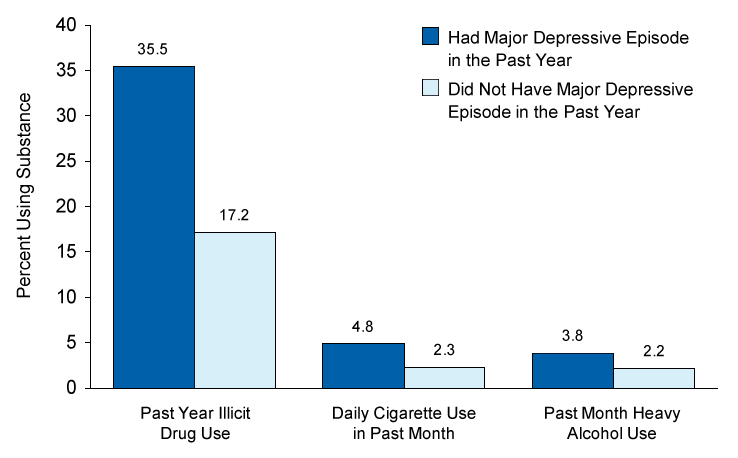
Treatment for Major Depressive
Episode among Youths
- In 2007, 38.9 percent
of youths aged 12 to 17 with past year MDE received treatment for depression
(i.e., saw or talked to a medical doctor or other professional or used prescription
medication), which was unchanged from the 2006 rate. Among youths with past
year MDE in 2007, 20.5 percent saw or talked to a medical doctor or other
professional only, 2.5 percent used prescription medication only, and
15.6 percent received treatment from both sources for depression in
the past year.
Mental Health Service
Use among Youths
- In 2007, 3.1 million
youths aged 12 to 17 (12.5 percent) received treatment or counseling
for problems with behavior or emotions in the specialty mental health setting
(inpatient or outpatient care). Additionally, 11.5 percent of youths
received services in the education setting, and 2.8 percent received
mental health services from the general medical setting in the past 12 months.
Mental health services were received from both the specialty setting and
either the education or general medical settings (i.e., care from multiple
settings) by 5.1 percent of youths.
- Female youths were
more likely than male youths to report using outpatient specialty mental
health services (13.3 vs. 9.1 percent), education services (13.2 vs.
9.9 percent), or general medical-based services (3.2 vs. 2.3 percent),
but there was no significant gender difference in the use of inpatient specialty
mental health services (Figure 8.10).
- Of the 2.8 million
youths who received outpatient specialty mental health services in the past
12 months, 19.7 percent reported having 1 visit, 17.4 percent
reported having 2 visits, 27.1 percent reported having 3 to 6 visits,
22.9 percent reported having 7 to 24 visits, and 12.9 percent reported
having 25 or more visits (Figure 8.11).
- Of the 628,000 youths
who received inpatient or residential specialty mental health services in
the past 12 months, over half (52.4 percent) reported staying overnight
1 to 2 nights, 18.4 percent reported staying 3 to 6 nights, 14.4 percent
reported staying 7 to 24 nights, and 14.8 reported staying 25 or more nights
(Figure 8.12).
Below is a bar graph.
Click here for the text describing this graph.
Figure 8.10 Past Year
Mental Health Service Use among Youths Aged 12 to 17, by Gender: 2007
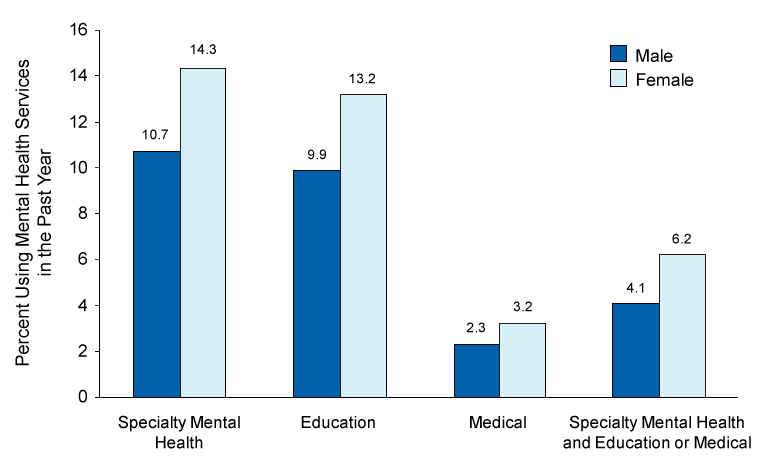
Below is a pie chart.
Click here for the text describing this chart.
Figure 8.11 Number of
Outpatient Visits in the Past Year among Youths Aged 12 to 17 Who Received
Outpatient Specialty Mental Health Services: 2007
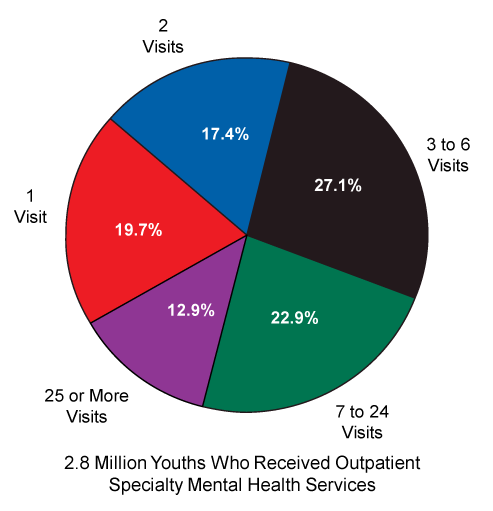
Below is a pie chart.
Click here for the text describing this chart.
Figure 8.12 Number of
Nights Stayed in an Inpatient Specialty Mental Health Facility in the Past
Year among Youths Aged 12 to 17 Who Received Inpatient Specialty Mental Health
Services: 2007
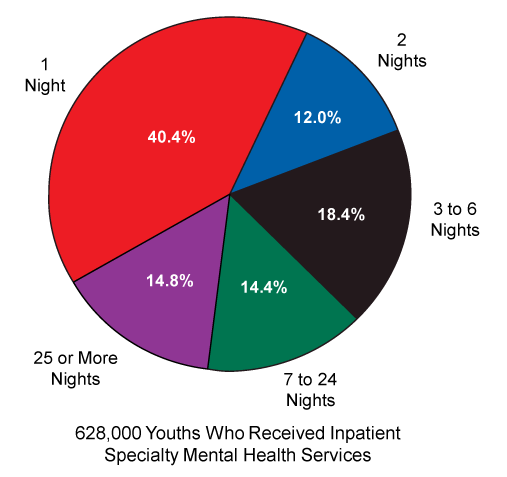
9. Discussion
of Trends in Substance Use among Youths and Young Adults
This report presents findings
from the 2007 National Survey on Drug Use and Health (NSDUH). Conducted since
1971 and previously named the National Household Survey on Drug Abuse (NHSDA),
the survey underwent several methodological improvements in 2002 that have
affected prevalence estimates. As a result, the 2002 through 2007 estimates
are not comparable with estimates from 2001 and earlier surveys. Therefore,
the primary focus of the report is on comparisons of measures of substance
use and mental health problems across subgroups of the U.S. population in
2007 and changes between 2006 and 2007, as well as between 2002 and 2007.
This chapter provides an additional discussion of the findings concerning
a topic of great interest—trends in substance use among youths and young
adults.
An important step in the
analysis and interpretation of NSDUH or any other survey data is to compare
the results with those from other data sources. This can be difficult sometimes
because the other surveys typically have different purposes, definitions,
and designs. Research has established that surveys of substance use and other
sensitive topics often produce inconsistent results because of different methods
used. Thus, it is important to understand that conflicting results often reflect
differing methodologies, not incorrect results. Despite this limitation, comparisons
can be very useful. Consistency across surveys can confirm or support conclusions
about trends and patterns of use, and inconsistent results can point to areas
for further study. Further discussion of this issue is included in Appendix D,
along with descriptions of methods and results from other sources of substance
use and mental health data.
Unfortunately, few additional
data sources are available at this time to compare with NSDUH results. One
established source is Monitoring the Future (MTF), a study sponsored by the
National Institute on Drug Abuse (NIDA). MTF surveys students in the 8th,
10th, and 12th grades in classrooms during the spring of each year, and it
also collects data by mail from a subsample of adults who had participated
earlier in the study as 12th graders (Johnston, O'Malley, Bachman, & Schulenberg,
2007c, 2008a, 2008b). Historically, NSDUH rates of substance use among youths
have been lower than those of MTF, and occasionally the two surveys have shown
different trends over a short time period. Nevertheless, the two sources have
shown very similar long-term trends in prevalence. NSDUH and MTF rates
of substance use generally have been similar among young adults, and the two
sources also have shown similar trends.
A comparison of NSDUH
and MTF estimates for 2002 to 2007 is shown in Tables 9.1
and 9.2 at the end of this chapter
for several substances that are defined similarly in the two surveys. MTF
data on 8th and 10th graders combined give the closest match on age to estimates
for NSDUH youths aged 12 to 17, while MTF follow-up data on persons aged
19 to 24 provide the closest match on age to estimates for NSDUH young adults
aged 18 to 25. The NSDUH results are remarkably consistent with MTF trends
for both youths and young adults, as discussed below.
Both surveys generally
show decreases between 2002 and 2007 in the percentages of youths who used
marijuana, Ecstasy, LSD, alcohol, and cigarettes in the lifetime, past year,
and past month (Table 9.1). One
exception was for LSD in the past month for MTF, and information on cigarettes
in the past year was not available for MTF. Estimates from both surveys indicate
a decline in cocaine use between 2002 and 2007, although the trend was statistically
significant in NSDUH data but not in MTF data. Both surveys show no decrease
in the rates of past year and past month inhalant use among youths between
2002 and 2007, although only NSDUH shows a significant decrease in lifetime
use. The consistency between NSDUH and MTF trend data is found not only in
terms of the specific drugs showing decreases, but also in terms of the magnitude
of the decreases. Despite the higher levels of prevalence estimated from MTF,
the two surveys show very similar rates of change in past month prevalence,
especially for the three substances used most commonly by youths: alcohol,
cigarettes, and marijuana. Between 2002 and 2007, the rate of current alcohol
use among youths declined 10 percent according to both NSDUH and MTF.
Current cigarette use prevalence rates in 2007 were 25 percent lower
in both NSDUH and MTF compared with 2002 rates. For past month marijuana use,
the NSDUH decline from 2002 to 2007 was 18 percent, and the MTF decline
was 24 percent.
Data on young adults also
show similar trends in the two surveys, although not as consistent as for
the youth data (Table 9.2). Potential
reasons for differences are the relatively smaller MTF sample size for young
adults and possible bias in the MTF sample due to noncoverage of school dropouts
and a low overall response rate, considering nonresponse by schools, by students
in the 12th grade survey, and in the follow-up mail survey. Both surveys
show declines from 2002 to 2007 in past year and past month cigarette and
marijuana use among young adults, although the decline in past month marijuana
use in NSDUH was not statistically significant. However, the NSDUH rates of
decline in current cigarette and marijuana use for young adults were less
than the declines in NSDUH for youths and for young adults in MTF. Past month
marijuana prevalence among young adults declined 5 percent according
to NSDUH and 12 percent according to MTF. For past month cigarette use,
declines were 11 percent in NSDUH and 18 percent in MTF. Both surveys
show no significant change from 2002 and 2007 in the rate of current alcohol
use among young adults. A significant decline between 2006 and 2007 in past
month cocaine use is seen in the NSDUH data, and the MTF data show a similar
drop in use (although not statistically significant).
Both NSDUH and MTF generally
show substantial decreases for both youths and young adults in the past year
use of Ecstasy and LSD between 2002 and 2004, then a leveling in 2005. The
2006 data from both surveys had suggested the start of a possible resurgence
in the past year use of Ecstasy among youths and young adults, but the 2007
data do not indicate any major increase or decrease since 2005, in general.
The only statistically significant change in past year Ecstasy use between
2005 and 2007 was for use among youths in NSDUH (from 1.0 to 1.3 percent).
NSDUH also showed a statistically significant increase between 2005 and 2006
in past year initiation of Ecstasy use for young adults (from 322,000 initiates
in 2005 to 494,000 initiates in 2006), but the increase did not continue in
2007 (414,000 initiates).
Another source of data
on trends in the use of drugs among youths is the Youth Risk Behavior Survey
(YRBS), sponsored by the Centers for Disease Control and Prevention. YRBS
surveys students in 9th through 12th grades in classrooms every other year
during the spring (Eaton et al., 2008). The most recent survey was completed
in 2007. YRBS has generally shown higher prevalence rates but similar long-term
trends when compared with NSDUH and MTF. However, comparisons between YRBS
and NSDUH or MTF are less straightforward because of the different periodicity
(i.e., biennially instead of annually) and ages covered, the limited number
of drug use questions, and smaller sample size in the YRBS. For the substances
for which information on current use is collected in the YRBS, including alcohol,
cigarettes, marijuana, and cocaine, the YRBS trend results between 2001 and
2007 are consistent with NSDUH and MTF (Eaton et al., 2008; Grunbaum et al.,
2002). YRBS data for the combined grades 9 through 12 showed no significant
change in alcohol use (47.1 percent in 2001 and 44.7 percent in
2007), a decrease in cigarette use (28.5 percent in 2001, 20.0 percent
in 2007), a decrease in marijuana use (23.9 percent in 2001, 19.7 percent
in 2007), and a decline in cocaine use (4.2 percent in 2001, 3.3 percent
in 2007).
Although changes in NSDUH
preclude direct comparisons of recent estimates with estimates from before
2002, it is important to put the recent trends in context by reviewing longer
term trends in use. NSDUH data (prior to the design changes in 1999 and 2002)
on youths aged 12 to 17 and MTF data on high school seniors have shown substantial
increases in youth illicit drug use during the 1970s, reaching a peak in the
late 1970s. Both surveys then showed significant declines throughout the 1980s
until about 1992, when rates reached a low point. These trends were driven
by the trend in marijuana use. With the start of annual data collection in
NSDUH in 1991, along with the biennial YRBS and the annual 8th and 10th grade
samples in MTF, trends among youths are well documented since the low point
that occurred in the early 1990s. Although they employ different survey designs
and cover different age groups, the three surveys are consistent in showing
increasing rates of marijuana use during the early to mid-1990s, reaching
a peak in the late 1990s, followed by consistent declines in use since the
turn of the 21st century (Figure 9.1).
Below is a line graph.
Click here for the text describing this graph.
Figure 9.1 Past Month
Marijuana Use among Youths in NSDUH, MTF, and YRBS: 1971-2007

MTF
= Monitoring the Future; NSDUH = National Survey on Drug Use and Health; YRBS
= Youth Risk Behavior Survey.
Table 9.1 –
Comparison of NSDUH and MTF Prevalence Estimates among Youths: 2002-2007
| Substance/Time
Period |
NSDUH |
MTF |
| Ages
12-17 |
8th
and 10th Grades |
| 2002 |
2003 |
2004 |
2005 |
2006 |
2007 |
2002 |
2003 |
2004 |
2005 |
2006 |
2007 |
--
Not available.
NOTE: MTF data for 8th and 10th graders are simple averages of estimates
for those two grades. Data for 8th and 10th graders are reported in
Johnston, O'Malley, Bachman, and Schulenberg (2008a). Design effects
used for variance estimation are reported in Johnston, O'Malley, Bachman,
and Schulenberg (2007c).
a Difference between this estimate and 2007 estimate is statistically
significant at the .05 level.
Sources: SAMHSA, Office of Applied Studies, National Survey on Drug
Use and Health, 2002, 2003, 2004, 2005, 2006, and 2007. University of
Michigan, The Monitoring the Future Study, 2002, 2003, 2004, 2005, 2006,
and 2007. |
| Marijuana |
|
|
|
|
|
|
|
|
|
|
|
|
| Lifetime |
16.2 |
23.8 |
22.6 |
| Past
Year |
13.2 |
12.5 |
18.5 |
17.5 |
| Past
Month |
6.8 |
6.7 |
6.7 |
10.9 |
10.4 |
10.0 |
| Cocaine |
|
|
|
|
|
|
|
|
|
|
|
|
| Lifetime |
2.4 |
2.3 |
2.2 |
2.1 |
4.9 |
4.4 |
4.4 |
4.5 |
4.1 |
4.2 |
| Past
Year |
1.8 |
1.6 |
1.7 |
1.6 |
1.5 |
3.2 |
2.8 |
2.9 |
2.9 |
2.6 |
2.7 |
| Past
Month |
0.5 |
0.6 |
0.4 |
0.4 |
1.4 |
1.1 |
1.3 |
1.3 |
1.3 |
1.1 |
| Ecstasy |
|
|
|
|
|
|
|
|
|
|
|
|
| Lifetime |
2.1 |
1.6 |
1.9 |
1.8 |
4.3 |
3.6 |
3.4 |
3.5 |
3.8 |
| Past
Year |
1.3 |
1.2 |
1.2 |
1.3 |
2.6 |
2.1 |
2.2 |
2.1 |
2.5 |
| Past
Month |
0.4 |
0.3 |
0.3 |
0.3 |
0.3 |
0.9 |
0.8 |
0.8 |
1.0 |
0.9 |
| LSD |
|
|
|
|
|
|
|
|
|
|
|
|
| Lifetime |
0.9 |
0.8 |
2.8 |
2.3 |
2.2 |
2.2 |
2.3 |
| Past
Year |
0.6 |
0.6 |
0.6 |
0.4 |
0.5 |
1.5 |
1.4 |
1.4 |
1.3 |
1.5 |
| Past
Month |
0.2 |
0.2 |
0.1 |
0.1 |
0.1 |
0.7 |
0.6 |
0.6 |
0.6 |
0.6 |
0.6 |
| Inhalants |
|
|
|
|
|
|
|
|
|
|
|
|
| Lifetime |
10.1 |
9.6 |
14.4 |
14.3 |
14.9 |
15.1 |
14.7 |
14.6 |
| Past
Year |
4.4 |
4.4 |
3.9 |
6.8 |
7.1 |
7.8 |
7.8 |
7.8 |
7.5 |
| Past
Month |
1.2 |
1.3 |
1.2 |
1.2 |
1.3 |
1.2 |
3.1 |
3.2 |
3.5 |
3.2 |
3.2 |
3.2 |
| Alcohol |
|
|
|
|
|
|
|
|
|
|
|
|
| Lifetime |
40.4 |
39.4 |
51.0 |
50.3 |
| Past
Year |
31.8 |
45.3 |
44.7 |
44.1 |
| Past
Month |
16.5 |
16.6 |
15.9 |
25.2 |
25.5 |
24.7 |
| Cigarettes |
|
|
|
|
|
|
|
|
|
|
|
|
| Lifetime |
23.7 |
28.4 |
| Past
Year |
15.7 |
-- |
-- |
-- |
-- |
-- |
-- |
| Past
Month |
10.4 |
9.8 |
10.6 |
Table 9.2 –
Comparison of NSDUH and MTF Prevalence Estimates among Young Adults: 2002-2007
Substance/
Time Period |
NSDUH |
MTF |
| Ages
18-25 |
Ages
19-24 |
| 2002 |
2003 |
2004 |
2005 |
2006 |
2007 |
2002 |
2003 |
2004 |
2005 |
2006 |
2007 |
--
Not available.
NOTE: MTF data for persons aged 19 to 24 are simple averages of modal
age groups 19-20, 21-22, and 23-24 as reported in Johnston,
O'Malley, and Bachman (2003b) and in Johnston, O'Malley, Bachman, and
Schulenberg (2004b, 2005b, 2006b, 2007b, 2008b).
NOTE: For the 19 to 24 age group in the MTF data, significance tests
were performed assuming independent samples between years an odd number
of years apart because two distinct cohorts a year apart were monitored
longitudinally at 2-year intervals. Although appropriate for comparisons
of 2002, 2004, and 2006 estimates with 2007 estimates, this assumption
results in conservative tests for comparisons of 2003 and 2005 estimates
with 2007 estimates because it does not take into account covariances
that are associated with repeated observations from the longitudinal
samples. Estimates of covariances were not available.
a Difference between this estimate and 2007 estimate is statistically
significant at the .05 level.
Sources: SAMHSA, Office of Applied Studies, National Survey on Drug
Use and Health, 2002, 2003, 2004, 2005, 2006, and 2007. University of
Michigan, The Monitoring the Future Study, 2002, 2003, 2004, 2005, 2006,
and 2007. |
| Marijuana |
|
|
|
|
|
|
|
|
|
|
|
|
| Lifetime |
50.8 |
56.1 |
55.6 |
54.4 |
53.8 |
53.9 |
| Past
Year |
28.5 |
27.8 |
28.0 |
28.0 |
27.5 |
33.0 |
31.6 |
31.4 |
30.9 |
31.0 |
| Past
Month |
17.3 |
17.0 |
16.1 |
16.6 |
16.3 |
16.4 |
18.2 |
17.0 |
17.0 |
17.5 |
| Cocaine |
|
|
|
|
|
|
|
|
|
|
|
|
| Lifetime |
15.4 |
15.0 |
15.2 |
15.1 |
15.7 |
15.0 |
12.9 |
12.6 |
13.6 |
12.4 |
| Past
Year |
6.7 |
6.6 |
6.6 |
6.9 |
6.9 |
6.4 |
6.5 |
7.3 |
6.9 |
7.0 |
6.3 |
| Past
Month |
2.0 |
1.7 |
2.5 |
2.6 |
2.4 |
2.1 |
2.4 |
1.9 |
| Ecstasy |
|
|
|
|
|
|
|
|
|
|
|
|
| Lifetime |
13.7 |
13.4 |
12.8 |
11.5 |
9.5 |
| Past
Year |
3.7 |
3.1 |
3.1 |
3.8 |
3.5 |
3.3 |
3.4 |
3.6 |
2.8 |
| Past
Month |
0.7 |
0.7 |
0.8 |
0.7 |
0.8 |
0.6 |
0.9 |
0.3 |
| LSD |
|
|
|
|
|
|
|
|
|
|
|
|
| Lifetime |
7.3 |
6.7 |
5.9 |
| Past
Year |
1.1 |
1.0 |
1.0 |
1.2 |
1.1 |
1.5 |
1.2 |
1.1 |
1.5 |
1.4 |
| Past
Month |
0.2 |
0.3 |
0.2 |
0.2 |
0.2 |
0.4 |
0.2 |
0.2 |
0.2 |
0.3 |
0.3 |
| Inhalants |
|
|
|
|
|
|
|
|
|
|
|
|
| Lifetime |
11.3 |
9.3 |
9.7 |
7.5 |
| Past
Year |
2.1 |
1.8 |
1.6 |
1.5 |
1.6 |
1.8 |
1.1 |
| Past
Month |
0.5 |
0.4 |
0.4 |
0.5 |
0.4 |
0.4 |
0.8 |
0.3 |
0.4 |
0.3 |
0.4 |
0.3 |
| Alcohol |
|
|
|
|
|
|
|
|
|
|
|
|
| Lifetime |
86.2 |
85.7 |
85.2 |
87.6 |
87.2 |
87.1 |
87.0 |
86.0 |
| Past
Year |
77.9 |
78.1 |
78.0 |
77.9 |
78.8 |
77.9 |
83.9 |
82.3 |
83.1 |
82.8 |
83.2 |
82.8 |
| Past
Month |
60.5 |
61.4 |
60.5 |
60.9 |
61.9 |
61.2 |
67.7 |
66.3 |
67.3 |
66.8 |
67.0 |
67.4 |
| Cigarettes |
|
|
|
|
|
|
|
|
|
|
|
|
| Lifetime |
64.7 |
-- |
-- |
-- |
-- |
-- |
-- |
| Past
Year |
45.1 |
37.1 |
36.2 |
| Past
Month |
36.2 |
26.7 |
25.7 |
End
Notes
1
RTI International is a trade name of Research Triangle Institute.
2See
http://webapp.icpsr.umich.edu/cocoon/SAMHDA/DAS3/00064.xml.


|

This
page has been accessed
234531
times since September 4, 2008.
This page was last updated on September 04, 2008.
|





























































